-
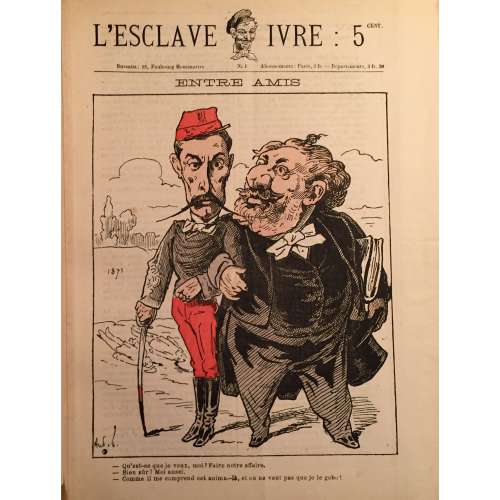 Artist: André Gill [real name Louis-André Gosset] (French, 1840 – 1885). L'Esclave Ivre [The Drunken Slave] was a Parisian weekly, published in 1881, 4 issues total. Léon Gambetta (French, 1838 – 1882) stands arm in arm with Marshal Patrice de MacMahon (French, 1808 – 1893). Dead bodies of communards lie in the midground and a landscape is faintly perceived in the background. 1871 is written on the hill on the left. L'Esclave Ivre, Issue 1. Entre Amis. Text below the image: - Qu'est-ce que je veux, moi? Faire notre affaire. / - Bien sûr! Moi aussi. / - Comme il me comprend cet animal-là, et on ne veut pas que je le gobe! [In between friends / - What do I want? To make a deal. / - Of course! Me too. / - How well this animal understands me, and we do not want me to swallow him!]
Artist: André Gill [real name Louis-André Gosset] (French, 1840 – 1885). L'Esclave Ivre [The Drunken Slave] was a Parisian weekly, published in 1881, 4 issues total. Léon Gambetta (French, 1838 – 1882) stands arm in arm with Marshal Patrice de MacMahon (French, 1808 – 1893). Dead bodies of communards lie in the midground and a landscape is faintly perceived in the background. 1871 is written on the hill on the left. L'Esclave Ivre, Issue 1. Entre Amis. Text below the image: - Qu'est-ce que je veux, moi? Faire notre affaire. / - Bien sûr! Moi aussi. / - Comme il me comprend cet animal-là, et on ne veut pas que je le gobe! [In between friends / - What do I want? To make a deal. / - Of course! Me too. / - How well this animal understands me, and we do not want me to swallow him!] -
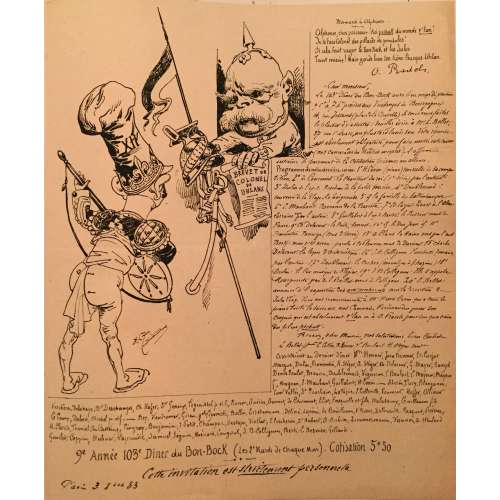
The 103rd Bon Bock Dinner Invitation
Artist: François Avenet a.k.a. Alexandre Ferdinandus (French, 1850 – 1888).
Cher monsieur, Le 103ème Dîner du Bon-Bock aura lieu mardi prochain / à 7h précises aux Vendanges de Bourgognel / 14, rue Jessaint (place de la Chapelle). Si vous nous faites le plaisir d’y assister : Veuillez écrire à Mr. E. Bellot, / 37 rue St Marc, au plus tard lundi soir. Votre réponse / est absolument obligatoire pour faire mettre votre couvert (nos camarades des théâtres exceptés.) L’affirmative entraine le paiement de la cotisation présence ou absence. / Programme de notre dernière soirée. 1e H Covin (piano) une valse de sa compo- / sition. 2e de Courment : Le Chanteur du roi (1ère série) par l’auteur. / 3e Dulin de l’o.p.e. Rondeau de la petite mariée 4e Doublemard : / souvenir de la Plage La baigneuse 5e "la famille des Saltimbanque" / 6e C. Maubant Romance de la Traviata. 7e Ct. Carjat Toast à l’Alsace-/Lorraine vers par l’auteur. 8e Guillabert de l’ap. de Nantes : le Pressoir mud. de / Faure . 9e Ch. Delacour : le Poete, Sonnet. 10e if. le Duc Jean if. 11e / Fromentin. Panurge (Mus. d’Hervé) 13e A. Claris la Haine vers par l’aut. / Benty : mon p’tit neveu : paroles d’Po Clouvier. mus. de Darcier. 15e Charles / Delacour : la leçon d’Arithmétique. 16e J.B. Collegnon Fanchette, romance/ par l’auteur. 17e Doublemard : le Cocher (monologue de P. Marzin) 18e / Dulin : le Cor musique de Flégier. 19e J. M. Collignon : Elle s’appela/ Marguerite par. De L. Baillet mus de Collignon. 20e L. Bellot / annonce de l’exposition des arts incohérents sous la direction de / Jules Féry. Tous nos remerciements à Mr. Henri Covin qui a tenu le/ piano toute la soirée et a nos Camarades Ferdinandus pour son / croquis qui est absolument v’lan et à O. Pradels pour son quatrain/ des plus pachutt. // Recevez, cher Monsieur, nos salutations bien Cordiale / E. Bellot, G durater E. Cottin, R. Géner, L. Bocilart, H. Héger comba / assistaient au Dernier Dîner Mrs : Henner, Jean Brenner, Et. Carjat / Margue, Dulin, Fromentin, H. Stéger, A . Stéger, eh. Delacour, G. Mayer, Sanzel/ Denis Poulot, Bricaire, Doublemard, Vigneron, T. Boulart, L. Mayeur, Mayeur/ flle, Magnan, E. Maubant, Guillabert, H. Corin. ___ Lebreton, Tucy, Blangarnon. / Comt. Vallée, Dr Pourbain, Latapie, E. Colleville, Roumier, Hoffer, Ollivier / Verchère, Delhaye, Dr Deschamps, Ch. Hofer, Dr Geneirp, Péginissel p, et F. , Pierson, Guérin, Cronnot, de Courmont, Eliot, Fasquelle et filsm Malasamy, Guillaume fils /G Caux, Dabert, Michel p, et f.s, ___Rey. Vaundremer, Girau, general Lipovvski, Ballin, Ersetemenn, Délivré, Lepéné, de Bouillanne, V. Roser, Delbroueth. Pasquet, Treterre, / A. Claris, Thoniel, du Castaings, Pingray, Benjamin, I. Petit, Champon, Destape, Viotlat, F. Percheron, Dr Hubert, A. Aubin, Zimmermann, Vannes, A. Heulard, / Gourlet, Coppin, Hubner, laprandie, Samuel, Séguin, Ménard, Cougoul, J. B. Collignon, Beri L. Besnier, Gillandi. // 9e Année 103e Diner du Bon-Bock (Les 2e Mardi de Chaque Mois). Cotisation 5h50 / Cette invitation est strictement personnelle / Paris 3 8bre 83.Bismarck à Alphonse
Alphonse, cher poissure! Roi pschutt du monde u’lan! Je te fais Colonel des pillards de pendules! Si cela fait rager le Bon-Bock et les Jules Tant mieux! Mais garde bien to Trône Basque-Uhlan. O. Pradels.
Bismarck to Alphonse Alphonse, dear annoyance! King shushh from the Uh'lan world I name you Colonel of the looters of pendulums! If this makes the Bon-Bock and Jules angry All the better! But protect your Basque-Uhlan throne well. O. Pradels.
Dear sir, The 103rd Dinner of the Bon-Bock will take place next Tuesday at 7 pm precisely at the Grape Harvest of Bourgognel, 14, Jessaint street (la Chapelle plaza). If you would do us the honour of coming: Please write to Mr E. Bellot, 37 St Marc street, on Monday night at the latest. Your answer is absolutely mandatory to prepare the place settings (our friends from the theatres excluded.) The 'yes' comes with a payment of the due whether or not you end up attending. Program for our last evening. 1st – H. Covin (piano) a waltz composed by him. 2nd – Courment: Le Chanteur du roi (King's singer) (1st series) by the author. 3rd – Dulin: Rondeau from opera "Le petite mariée" (The Little Bride) 4th – Doublemard: Memory of the bather's beach 5th – "The Saltimbanque family" 6th – Maubant: Romance of "La Traviata". 7th – Étienne Carjat Toast to the Alsace-Lorraine, verses by the author. 8th – Guillabert from the opera "Nantes: le Press mud" by Fauré. 9th – Charles Delacour: the Poet, Sonnet. 10th – "Duke Jean" 11th – Fromentin. Panurge (Mus. of Hervé) 13th – A. Claris "The Hatred" verses by the author, Benty: my lil’ nephew: lyrics by Clouvier, music by Darcier. 15th – Charles Delacour: the lesson in arithmetic. 16th – J.-B.Collegnon, "Fanchette", romance by the author. 17th – Doublemard: the Coach driver (monologue by P. Marzin). 18th – Dulin: the horn music by Flégier. 19th – J.-B. Collignon: "Her name was Marguerite", lyrics by L. Baillet music by Collignon. 20th – L. Bellot, an announcement from the incoherent arts exhibition curated by Jules Férry. All of our thanks to Mr Henri Covin who played the piano all night and to our Friends Ferdinandus for his sketch that is absolutely bam and to O. Pradels for his quatrain among the most pazazz worthy. We send you our most cordial salutation, Monsieur. E. Bellot, G. Durater, E. Cottin, R. Géner, L. Bocilart, H. Héger, Henner, Jean Brenner, Et. Carjat, Margue, Dulin, Fromentin, H. Stéger, A . Stéger, Ch. Delacour, G. Mayer, Sanzel, Denis Poulot, Bricaire, Doublemard, Vigneron, T. Boulart, L. Mayeur, Mayeur daugter, Magnan, E. Maubant, Guillabert, H. Corin. Lebreton, Tucy, Blangarnon. Comt. Vallée, Dr Pourbain, Latapie, E. Colleville, Roumier, Hoffer, Ollivier, Verchère, Delhaye, Dr. Deschamps, Ch. Hofer, Dr. Geneirp, Péginissel père et fils, Pierson, Guérin, Cronnot, de Courmont, Eliot, Fasquelle et fils Malasamy, Guillaume fils, G. Caux, Dabert, Michel père et fils, Rey. Vaundremer, Girau, General Lipovvski, Ballin, Ersetemenn, Délivré, Lepéné, de Bouillanne, V. Roser, Delbroueth, Pasquet, Treterre, A. Claris, Thoniel, du Castaings, Pingray, Benjamin, J. Petit, Champon, Destape, Viotlat, F. Percheron, Dr. Hubert, A. Aubin, Zimmermann, Vannes, A. Heulard, Gourlet, Coppin, Hubner, Laprandie, Samuel, Séguin, Ménard, Cougoul, J. B. Collignon, Berti, Besnier, Gillandi. 9th Year 103rd Dinner of the Bon-Bock (The 2nd Tuesdays of Each Month). Due 5:50 pm. This invitation is strictly personal. Paris 3 October 1883. Bismarck hands a certificate for the title of colonel along with a lance, an Uhlan helmet (Polish cavalry) and a sword to a joker. The joker wears a traditional Polish folk hat inscribed with 'XIV' and holds a guitar. ______ Comments: Émile Bellot [L. Bellot] (French, the second half of the 19th century) – engraver, model for a painting by Édouard Manet "Le bon bock", the founder of Le Bon Bock Dinner. Covin, Henri (French, 1845 – 1887) – Musician, arranger. Étienne Carjat (French, 1828 – 1906) – Journalist, caricaturist and photographer. Charles Delacour (French, 18.. – 1898) – Composer. Jean-Baptiste Collignon (French, 18..-1906) – Composer. Ange Flégier (French, 1846 – 1927) – Composer. Joseph Darcier (French, 1819 – 1883) – Composer, singer and actor. Le petite mariée (The Little Bride) – a three-act opéra-bouffe, music by Charles Lecocq, libretto by Eugène Leterrier and Albert Vanloo. La plage de la Baigneuse – beach of Saint Jean de Monts in the Vendée department in the Pays de la Loire region in western France. La Famille du Saltimbanque: L'Enfant Blessé – The Family of Street Acrobats: the Injured Child – painting by Gustave Doré (French, 1832 – 1883) produced in 1873. Henri-Polydore Maubant (1821-1902) – actor, vocalist (baritone) Gabriel Urbain Fauré (French, 1845 – 1924) – French composer, organist, pianist, and teacher. Hervé [Louis Auguste Florimond Ronger] (French, 1825 – 1892) – French singer, composer, librettist, conductor and scene painter, inventor of the genre of operetta in Paris. -
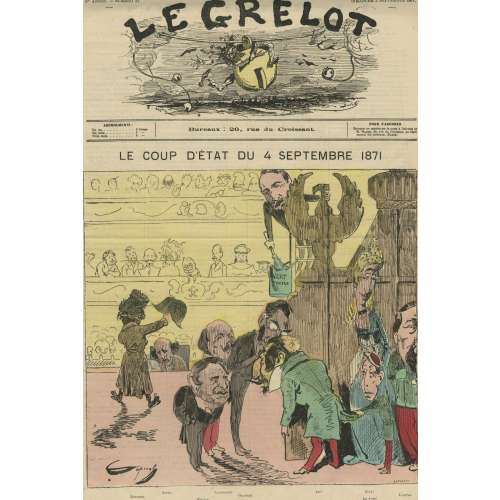 Le Grelot / journal illustré politique et satirique, №21, dimanche, 3 septembre 1871. Artist: Caporal (signed in the lower-left corner) Engraver/Printer: J. Lefman (signed LEFMAN SC in the lower-right corner) Title: LE COUP D'ÉTAT DU 4 SEPTEMBRE 1871. The Coup d'Etat of September 4th 1871. The artist equalled the 4th of September revolution when Napoleon III was ousted and the Second Empire collapsed, to a coup d'Etat. Although the number is marked September 3, it is dedicated to the events of September 4th. This was a usual French newspaper practice to postdate their issues. That's why they almost always operated with categories such as "today", "yesterday", and "tomorrow" instead of definitive calendar dates. "Le Grelot" means "The Sleigh Bell". Personages: Ratapoil – fictional personage invented by Honoré Daumier (French, 1808 – 1879), a Napoleon III caricaturized figure. Ratapoil is addressing the audience holding up Napoléon Bonaparte's tricorn cocked hat. Pietri – Joseph Marie Piétri [Joachim Piétri] (French, – is sitting in the first row, taking notes. Rouher – Eugène Rouher (French, 1814 – 1884), president of the Senat. Canrobert – François Marcellin Certain de Canrobert (French, 1809 – 1895), French Marshal, captured by the Prussian army in Metz with Marshal Bazaine during the surrender of Metz on October 28, 1870. Ollivier – Olivier Émile Ollivier (French, 1825 – 1913), head of the government. Hiding behind the theater decoration are: Napoleon III (Lui!), his wife Eugénie (Elle!), their son Prince Imperial (Le P'tit!), and Pierre Bonaparte (L'Autre). Sitting in the theatre box facing the scene: Adolphe Thiers (French, 1797 – 1877), Jules Favre (French, 1809 – 1880), Louis-Jules Trochu [Le General Trochu] (French, 1815 – 1896), and the other members of the "Government of National Defence". On the gallery: youngsters and two men in sans-culottes hats. An unidentified person on a ladder holding to an eagle figure is having a paintbrush and a bucket with 'tender green' paint. Ref: Musée Carnavalet
Le Grelot / journal illustré politique et satirique, №21, dimanche, 3 septembre 1871. Artist: Caporal (signed in the lower-left corner) Engraver/Printer: J. Lefman (signed LEFMAN SC in the lower-right corner) Title: LE COUP D'ÉTAT DU 4 SEPTEMBRE 1871. The Coup d'Etat of September 4th 1871. The artist equalled the 4th of September revolution when Napoleon III was ousted and the Second Empire collapsed, to a coup d'Etat. Although the number is marked September 3, it is dedicated to the events of September 4th. This was a usual French newspaper practice to postdate their issues. That's why they almost always operated with categories such as "today", "yesterday", and "tomorrow" instead of definitive calendar dates. "Le Grelot" means "The Sleigh Bell". Personages: Ratapoil – fictional personage invented by Honoré Daumier (French, 1808 – 1879), a Napoleon III caricaturized figure. Ratapoil is addressing the audience holding up Napoléon Bonaparte's tricorn cocked hat. Pietri – Joseph Marie Piétri [Joachim Piétri] (French, – is sitting in the first row, taking notes. Rouher – Eugène Rouher (French, 1814 – 1884), president of the Senat. Canrobert – François Marcellin Certain de Canrobert (French, 1809 – 1895), French Marshal, captured by the Prussian army in Metz with Marshal Bazaine during the surrender of Metz on October 28, 1870. Ollivier – Olivier Émile Ollivier (French, 1825 – 1913), head of the government. Hiding behind the theater decoration are: Napoleon III (Lui!), his wife Eugénie (Elle!), their son Prince Imperial (Le P'tit!), and Pierre Bonaparte (L'Autre). Sitting in the theatre box facing the scene: Adolphe Thiers (French, 1797 – 1877), Jules Favre (French, 1809 – 1880), Louis-Jules Trochu [Le General Trochu] (French, 1815 – 1896), and the other members of the "Government of National Defence". On the gallery: youngsters and two men in sans-culottes hats. An unidentified person on a ladder holding to an eagle figure is having a paintbrush and a bucket with 'tender green' paint. Ref: Musée Carnavalet -
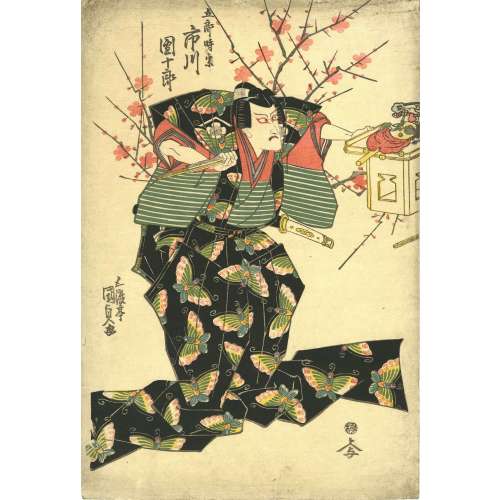 Actor Ichikawa Danjuro VII as Soga Goro Tokimune (one of the Soga brothers). Ichikawa Ebizô V held the name of Ichikawa Danjûrô VII from the 11th lunar month of 1800 to the 2nd lunar month of 1832. Artist: Utagawa Kunisada (Toyokuni III) [歌川 国貞] (Japanese, 1786 – 1865) Publisher: Uemura Yohei (Japanese, 1750 – 1832). Date: 1830 Size: Vertical ōban Signatures/Marks: Gototei Kunisada ga. Publisher's seal: Uemura Yohei. Censor's seal: Kiwame
Actor Ichikawa Danjuro VII as Soga Goro Tokimune (one of the Soga brothers). Ichikawa Ebizô V held the name of Ichikawa Danjûrô VII from the 11th lunar month of 1800 to the 2nd lunar month of 1832. Artist: Utagawa Kunisada (Toyokuni III) [歌川 国貞] (Japanese, 1786 – 1865) Publisher: Uemura Yohei (Japanese, 1750 – 1832). Date: 1830 Size: Vertical ōban Signatures/Marks: Gototei Kunisada ga. Publisher's seal: Uemura Yohei. Censor's seal: Kiwame -
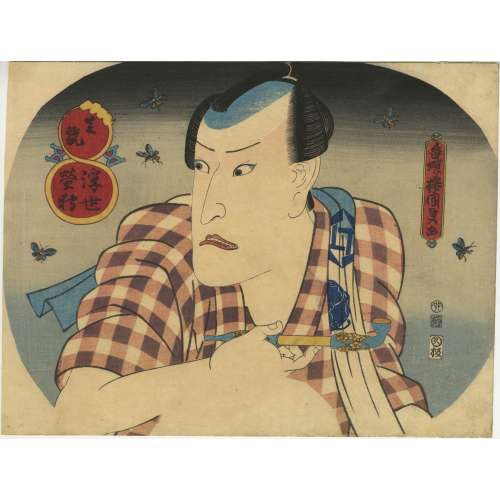 Uncut fan print (uchiwa-e) with the design of kabuki actor Nakamura Utaemon IV who held the name of Nakamura Shikan II from the 11th lunar month of 1825 to the 12th lunar month of 1835, dressed in a checkered kimono, holding a pipe and surrounded by flying fireflies. Character: Nakamura Utaemon IV [中村歌右衛門] (Japanese, 1796 – 1852); other names: Nakamura Shikan II, Nakamura Tsurusuke I, Nakamura Tōtarō. Series title: Catching fireflies in the floating world [浮世蛍狩] (Ukiyo hotarugari). Artist: Utagawa Kunisada [歌川 国貞], a.k.a. Toyokuni III (Japanese, 1786 – 1865). Signed: Kōchōrō Kunisada ga [香蝶楼国貞画] in a red cartouche. Publisher: Ibaya Kyubei [伊場屋 久兵衛] (Japanese, fl. 1804 – 1851); seal: modified Marks 19-009 | 126d. Censor's seal: Kiwame Date seal: Tenpō 2 (1831). Ref: Kunisada.de, N58. A look-alike yearlier Kunisada's design can be found at kunisada.de, ref. # N120-Z0172-410:
Uncut fan print (uchiwa-e) with the design of kabuki actor Nakamura Utaemon IV who held the name of Nakamura Shikan II from the 11th lunar month of 1825 to the 12th lunar month of 1835, dressed in a checkered kimono, holding a pipe and surrounded by flying fireflies. Character: Nakamura Utaemon IV [中村歌右衛門] (Japanese, 1796 – 1852); other names: Nakamura Shikan II, Nakamura Tsurusuke I, Nakamura Tōtarō. Series title: Catching fireflies in the floating world [浮世蛍狩] (Ukiyo hotarugari). Artist: Utagawa Kunisada [歌川 国貞], a.k.a. Toyokuni III (Japanese, 1786 – 1865). Signed: Kōchōrō Kunisada ga [香蝶楼国貞画] in a red cartouche. Publisher: Ibaya Kyubei [伊場屋 久兵衛] (Japanese, fl. 1804 – 1851); seal: modified Marks 19-009 | 126d. Censor's seal: Kiwame Date seal: Tenpō 2 (1831). Ref: Kunisada.de, N58. A look-alike yearlier Kunisada's design can be found at kunisada.de, ref. # N120-Z0172-410:
Actor Onoe Baikō, artist Kunisada, publisher Ibaya Kyūbei, c. 1820.
-

A very thin kobushi-gata form iron tsuba decorated in openwork (sukashi), some openings filled with grey metal (silver or pewter) treated in a way to resemble cracked ice, ginkgo leaf to recto and plum blossoms to verso in low-relief (takabori) and gold inlay (zōgan), and unevenly folded over rim (hineri-mimi). The overall theme of the piece is linked to the icy ponds, falling ginkgo leaves and blossoming plums in the late winter.
Size: 84 x 80 mm, thickness (center): 2 mm.Signed: Yamashiro no kuni Fushimi no ju Kaneie [Kaneie of Fushimi in Yamashiro Province] [山城國伏見住金家], with Kaō.
Probably the work of Meijin-Shodai Kaneie (c. 1580 – 1600).
The silver or pewter inlays likely a later work that may be attributed to Goto Ichijo (1791 – 1876) or one of his apprentices in the late 19th century, possibly as a tribute to the great Kaneie masters. Here is an article by Steve Waszak dedicated to Kaneie masters and this tsuba in particular.Kaneie
For many tosogu aficionados, this name reigns supreme among all tsubako across Japanese history. The first Kaneie is celebrated for many things. He is recognized as being the first ever to bring pictorial landscape subjects to a canvas so small as that of a tsuba plate. His skill in being able to render classical Chinese landscape themes while working with a material as unyielding as steel, and to do so with the sensitivity he does, is nothing short of astounding. The quality of his workmanship — especially that of his exquisitely carved motif elements and the extraordinary deftness of his tsuchime (槌目 or 鎚目, hammer-blow) utilizing such thin plates — astonishes even to this day. His sensibilities concerning the shaping of his sword guards and the presentation of the rims were no less innovative than his subject matter. He was among the very first to regularly sign his name as a tsuba smith. And it is likely that he served the great warlord Toyotomi Hideyoshi in the latter years of the 16th century. Despite the great fame and reputation of Kaneie, very little of the lives of the two men who are seen by most scholars as the “true Kaneie” tsubako of the Momoyama and earliest Edo Periods is known to us now. They were both smiths working in steel, with occasional added soft-metal inlay (usually serving to highlight features), and both made sword guards of the same style, using subject matter focused on landscapes, allusions to historical events, or religious themes. The first of these men is often referred to as “O-Shodai,” or Great First Generation, while the second is known as “Meijin-Shodai,” or Famous First Generation. While some see subsequent generations stemming from these first two men, others have the O-Shodai and the Meijin-Shodai as THE two true Kaneie and make a sharp distinction between these two smiths and any others who may share the name.The work of the O-Shodai may appear with two different mei. One of these is written “Joshu Fushimi Ju Kaneie,” while his work may also carry a mei reading “Yamashiro no Kuni Fushimi Ju Kaneie.” It is thought by some scholars that the earlier works present with the “Joshu” mei, while his later works feature the “Yamashiro” mei. However, there are only some five or six tsuba extant with the “Joshu” signature, so we should not necessarily see works with the “Yamashiro” signature as dating only to the latest years of his working life. The answers to the questions of exactly when Kaneie might have begun his life as a tsubako, or how old he was when he moved to sign his works with the “Yamashiro” mei, will probably remain shrouded in uncertainty.The association between Kaneie and Toyotomi Hideyoshi is speculative, to be sure, but the circumstantial evidence is tantalizing. The area of Fushimi is thought to have been an entirely unremarkable land prior to Hideyoshi’s building of a castle there, so it would seem unlikely that the first Kaneie would have been working in such a nondescript place, much less including the place name in his mei, before Hideyoshi’s putting it on the map, so to speak. Why emphasize such pride of place in one’s signature unless the place itself carries a certain weight? The name “Kaneie” translates roughly to “gold family,” which, given Hideyoshi’s notorious love of gold, would seem too much of a coincidence when combined with the explicit mention of Fushimi in the signatures. Combine this with the consideration of what is an equally compelling relationship between the celebrated tsubako Nobuie and Oda Nobunaga (“Nobuie” means roughly “of the family of “Nobu”), whom Hideyoshi served as a top general until Oda’s demise in 1582, and the circumstantial evidence becomes even harder to deny the plausibility of. Oda, ever the innovator, may have been the one responsible for birthing the practice of tsubako regularly signing their works. Having a superb smith like Nobuie affix the name to the tsuba as a regular practice establishes a sort of “brand name,” a brand coming with the seal of approval of Oda Nobunaga. It is more than possible that Nobunaga may have then used these valuable sword guards as rewards given to vassals and other important relations to honour them for their services to him, a practice that would have allowed Nobunaga to avoid having to use gold, guns, swords, horses, or land to do so. The awarding of a magnificent Nobuie tsuba to a deserving warrior, an appreciated ally, or a family member would bring honour to the recipient, of course, but would also honour the maker of the sword guard, and even the giver of the object. Such a way of thinking would be absolutely typical of him, and given that both Oda Nobunaga and Nobuie were men of Kiyosu in Owari in the early Momoyama Period, it does not strain credulity to imagine that the above dynamic could have occurred in just this way. If indeed it did, Toyotomi Hideyoshi is unlikely to have let this pass unnoticed. He may even have been so honoured himself! When he rose to power very shortly after Oda’s death, then, and when he reinforced and consolidated that power in the late 1580s and early 1590s, which included the building of the castle at Fushimi, perhaps he sought to emulate the Oda vision and practice of establishing a “royal tsubako.” If so, Kaneie would have been that smith.As noted, this scenario is speculative, and not a little romantic. This does not mean, however, that it is in fact not likely, for there would be a number of coincidences involved for it to be entirely false.Tsuba scholars will say that Kaneie’s skills in the making of his sword guards indicate an armour-making background. This is an interesting viewpoint, but one can’t help but wonder how many armourers were possessed of such fluent literacy in lyrical Chinese historical tales that they could then represent them as motifs on steel plates. Kaneie subjects often are in the form of Chinese landscapes and allusions, as noted, one of which — The Eight Views of the Xiao and the Xiang — was very well known as a famous subject of Chinese painting and poetry from the Song Dynasty. There exist Kaneie tsuba which depicts at least some of these “views,” and it seems unlikely that if one or more of them were to be created, not all of them would be, in a sort of “series.” The cultural and literary fluency Kaneie would seem to have had, then, may suggest a Buddhist background, and indeed, some of the subjects seen are explicitly Buddhist in nature. Perhaps his background then, somehow offering a dovetailing of metalwork and Buddhist teachings; in any event, we are all the richer for at least some of the works of Kaneie to have survived to reach us today.One of the hallmarks of Kaneie tsuba (real ones) is the extreme thinness of the plate, combined with utterly superb tsuchime expression of that plate. To be able to hammer the plate to achieve such strength of expression while the plate is so thin is seen by the Japanese as practically miraculous. A notable and important kantei point between the early masterpieces by the two “Shodai” Kaneie and the tsuba made by followers is this thinness of the plate. Another kantei point: because the plate is so thin when raised areas representing motif elements are present, they are inlaid into the plate, because trying to carve them from such a thin plate would be practically impossible: the likelihood of piercing the plate would be high, and the plate in that area, even if not pierced, would be significantly weakened by trying to manage the raising of a motif element from the plate. In real Kaneie works, then, one would expect any raised motif elements to be inlaid.Other highlights: the “Shodai” Kaneie are famous for the kobushi-gata (拳形) or “fist-shaped” design in their work, but despite this, there actually aren’t that many extant sword guards boasting this shape. Another feature for which the Kaneie are justly famous is their folding over of the lip of the rim onto the plate in a very tasteful manner, just here and there, rather than uniformly across the tsuba. However, again, this feature is actually not commonly seen, either. The combination, then, of a kobushi-gata shape with the rim folded over in just a few areas is that much rarer.Which brings us to the featured piece.Here is a Kaneie tsuba, a “Meijin-Shodai” Kaneie, which presents with a very thin plate, being between 1.5 and 2mm in thickness. The motif elements are inlaid, as we should expect. The sugata (姿, shape) is Kobushi-gata with the rim folded over in only a few places, representing a relatively infrequently encountered form, as stated. The tsuba here is fortunate not to have any added hitsu-ana, unlike many or most other Kaneie do. The sukashi elements are fascinating to consider, being difficult to determine the meaning of; however, the raised elements clearly point to a seasonal motif, with cherry and plum blossoms on the omote for Spring, and ginkgo on the ura for Fall. The inlaid metal in two of the openings — silver, shibuichi, or pewter, perhaps — is very likely a later addition, probably 19th-century, and more specifically, late-19th-century. The finishing on these inlaid portions has all the hallmarks of Goto Ichijo workmanship. Namely, the treatment of the surface of the inlay to resemble fallen snow (in the Japanese sense of things) is expressed in a very Ichijo sense of things, and, given the great importance of Kaneie tsuba, and the seasonal expression the motif of the guard has, it is plausible that the inlay is Ichijo work or that of one of his top students. In any event, this inlay complements the rest of the tsuba beautifully. The inlay also resembles the art of kintsugi (金継ぎ, golden joinery) or the Japanese practice of ceramic repair using lacquer when a piece is particularly special or important. In this way, a nod is given to Tea Culture, too, creating a wonderful blending of associations and allusions, typical of the highest Japanese aesthetic sense.At 8.4cm, the tsuba is of an excellent size and is in great condition (no rust, no deep rust pitting, no fire damage). There is, intriguingly, one small sign of battle damage at 6:00 on the guard: it would seem a sword blow cut into the tsuba at the rim, and penetrated slightly into the plate. The superb repair represented by a little stitch or two right at the rim and along a few millimetres of the plate is visible on very close inspection. The repair is old, probably nearly contemporary with when the tsuba was made. Given the high status of Kaneie in their lifetime (as tsubako for Hideyoshi, one might imagine their importance), and given the obvious high quality of this piece, it is not surprising that the finest repair efforts were put into its care.The name Kaneie justly enjoys its fame and accolades as pre-eminent among the tens of thousands of tsubako in Japanese history. We are fortunate indeed to have had a small number of the works of the early masters survive to this day. The first of their kind, and as most scholars and aficionados would wholeheartedly agree, the best of their kind, Kaneie sword guards remain among the very finest examples of the Japanese metal-working traditions. -
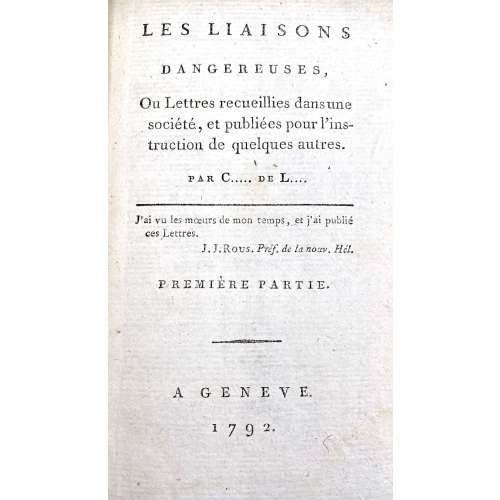 Four parts bound in two 18mo volumes (1-2 & 3-4), half polished brown calf, dot-ruled, flat spine with gilt bands and lettering, marbled boards, some plates with guard sheets, margins sparkled red. Title-page: LES LIAISONS | DANGEREUSES, | Ou Lettres recueillies dans une | société, et publiées pour l’ins- | truction de quelques autres. | par C….. de L… | — | J’ai vu les mœurs de mon temps, et j’ai publié | ces Lettres. | J. J. Rous. Préf. De la nouv. Hél. | PREMIÈRE PARTIE. | — | A GENEVE. | 1792. || Vol. 1: Pagination: ffep, blank, [2] – h.t., [i, ii] – t.p. part one, [iii] iv-xxij, [1] 2-245 [246] + 2 plates (p. 26 & p. 75); [1, 2] – h.t., [3, 4] – t.p. part two, [5] 6-233 [234], fep + 2 plates (p. 59 & p. 222). Collation: part 1: a12, A-M18 N5; part 2: A-M18 N9, plus four plates by various engravers after Le Barbier. Vol. 2: Pagination: ffep, blank, [1, 2] – h.t., [3, 4] – t.p. part three, [5] 6-225 [226] + 2 plates (p. 69 & p. 215); [1, 2] – h.t., [3, 4] – t.p. part four, [5] 6-250, fep + 2 plates (p. 25 & p. 201). Collation: part 3: A-M18 N5; part 4: A-N18 O5, plus four plates by various engravers after Le Barbier. Illustrations: After Le Barbier, engravers: Halbou (1), Simonet (1), N. Thomas (2), Dambrun (2), and Delignon (2). In the first illustration (vol. 1, part one, p. 26) Le Barbier signed “Le Barbier Jnv. 1794”, however, the edition was published (anonymously) in 1792. Cohen-De Ricci mentions an edition of 1794 (Paris: Maradan) and 1801 (Genéve) with the same plates. Lewine mentions a reprint of 1794 without naming the publisher. Catalogue raisonné: Cohen-De Ricci: 234-5, Ray: p. 79; Lewine: 109-10. Contributors: Choderlos de Laclos, Pierre Ambroise François (French, 1741 – 1803) – author. Le Barbier, Jean-Jacques-François (French, 1738 – 1826) – artist Engravers: Dambrun, Jean (French, 1741 – c. 1808) Delignon, Jean Louis (French, 1755 – 1804) Halbou, Louis Michel (1730 – 1809) Thomas, N. (French, c. 1750 – 1812) Simonet, Jean-Baptiste Blaise (French, 1742 – 1813)
Four parts bound in two 18mo volumes (1-2 & 3-4), half polished brown calf, dot-ruled, flat spine with gilt bands and lettering, marbled boards, some plates with guard sheets, margins sparkled red. Title-page: LES LIAISONS | DANGEREUSES, | Ou Lettres recueillies dans une | société, et publiées pour l’ins- | truction de quelques autres. | par C….. de L… | — | J’ai vu les mœurs de mon temps, et j’ai publié | ces Lettres. | J. J. Rous. Préf. De la nouv. Hél. | PREMIÈRE PARTIE. | — | A GENEVE. | 1792. || Vol. 1: Pagination: ffep, blank, [2] – h.t., [i, ii] – t.p. part one, [iii] iv-xxij, [1] 2-245 [246] + 2 plates (p. 26 & p. 75); [1, 2] – h.t., [3, 4] – t.p. part two, [5] 6-233 [234], fep + 2 plates (p. 59 & p. 222). Collation: part 1: a12, A-M18 N5; part 2: A-M18 N9, plus four plates by various engravers after Le Barbier. Vol. 2: Pagination: ffep, blank, [1, 2] – h.t., [3, 4] – t.p. part three, [5] 6-225 [226] + 2 plates (p. 69 & p. 215); [1, 2] – h.t., [3, 4] – t.p. part four, [5] 6-250, fep + 2 plates (p. 25 & p. 201). Collation: part 3: A-M18 N5; part 4: A-N18 O5, plus four plates by various engravers after Le Barbier. Illustrations: After Le Barbier, engravers: Halbou (1), Simonet (1), N. Thomas (2), Dambrun (2), and Delignon (2). In the first illustration (vol. 1, part one, p. 26) Le Barbier signed “Le Barbier Jnv. 1794”, however, the edition was published (anonymously) in 1792. Cohen-De Ricci mentions an edition of 1794 (Paris: Maradan) and 1801 (Genéve) with the same plates. Lewine mentions a reprint of 1794 without naming the publisher. Catalogue raisonné: Cohen-De Ricci: 234-5, Ray: p. 79; Lewine: 109-10. Contributors: Choderlos de Laclos, Pierre Ambroise François (French, 1741 – 1803) – author. Le Barbier, Jean-Jacques-François (French, 1738 – 1826) – artist Engravers: Dambrun, Jean (French, 1741 – c. 1808) Delignon, Jean Louis (French, 1755 – 1804) Halbou, Louis Michel (1730 – 1809) Thomas, N. (French, c. 1750 – 1812) Simonet, Jean-Baptiste Blaise (French, 1742 – 1813) -
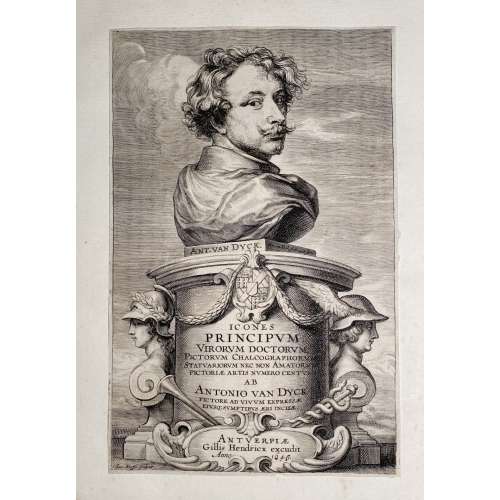 A book of sixty-eight copperplate engravings (burin and etching) by various artists after Anthony van Dyck, and one engraving by Lucas Vorsterman I, printed in black on laid paper, bound in full calf with a blind-stamped double-fillet ruling to the boards, spine with raised bands, gilt floral lozenges in compartments, gilt lettering "RECUE DE FIGUR", all margins sprinkled red, marbled end-papers. Engravers: Adriaen Lommelin (French engraver, 1637 – c. 1673) : 12 plates: №№ 3, 17, 18, 20, 21, 24, 25, 26, 28, 30, 35, and 48. Anthony van Dyck (Flemish, 1599 – 1641) : partially engraved himself 1 plate: № 53. Antoine Couchet (Flemish, 1630 – 1678) : 1 plate № 30. Conrad Waumans [Woumans] (Flemish engraver, 1619 – after 1675) : 6 plates: №№ 5, 32, 36, 57, 64, and 66. Cornelis Galle the Younger (Flemish engraver, 1615 – 1678) : 5 plates: №№ 2, 7, 10, 29, and 33. Hendrick Snyers (Flemish engraver, 1611 – 1644) : 1 plate: № 9. Jacob Neefs, or Neeffs (Flemish engraver, 1610 – after 1660): 4 plates: №№ 1, 16, 45, and 67. Johannes [Jan] Meyssens (Flemish engraver and publisher, 1612 – 1670) : engraved 6 plates: №№ 4, 22, 31, 51, 61, and 62. Lucas Vorsterman the Elder (Flemish engraver, 1595 – 1675) : engraved 7 plates: №№ 11, 15, 55, 58, 59, 65, and 69. Michael Natalis, or Noël (Flemish engraver, 1610 – 1668) : 1 plate: № 34 Paulus Pontius (Flemish engraver, 1603 – 1658) : 2 plates: №№ 37 and 52. Peeter Clouwet (Flemish engraver, 1629 – 1670) : 3 plates: №№ 13, 27, and 49. Peeter van Lisebetten (Flemish engraver, 1630 – 1678) : 1 plate: № 56. Pieter de Bailliu (Flemish engraver, 1613 – after 1660) : 4 plates: №№ 8, 14, 44, and 54. Pieter de Jode II (Flemish, 1606 – 1670/74) : 7 plates: №№ 12, 19, 23, 46, 47, 50, and 60. Richard Gaywood (British, fl. 1644 – 1668) : 1 plate: № 63. Robert van Voerst (Dutch, 1597 – 1636) : 1 plate: № 6. Schelte Adamsz. Bolswert (Flemish, c. 1586 – 1659) : 2 plates: №№ 18 and 68. Wenceslaus Hollar (Bohemian, 1607 – 1677) : 6 plates: №№ 38, 39, 40, 41, 42, and 43. Publishers: 36 prints were printed/published by Johannes [Jan] Meyssens (Flemish, 1612 – 1670) : (2), (4), (5), (7), (8), (9), (10), (12), (14), (22), (29), (31), (32), (33), (34), (36), (37), (39), (40), (41), (42), (43), (44), (45), (46), (51), (53), (54), (56), (57), (60), (61), (62), (64), (66), (67). Gillis Hendricx (fl. 1640 – 1677) published 11 prints, including the title page: (1), (13), (18), (26), (30), (47), (48), (50), (59), (65), (68). N. Burgund. Cons. Brab : (20); John Overton (British, 1639/40 – 1713) : (63); Hendrik van der Borcht II (Dutch, 1614 – c. 1690) : (38); Peter Stent (British, fl. c. 1637 – 1665) : (63). Description of plates:
A book of sixty-eight copperplate engravings (burin and etching) by various artists after Anthony van Dyck, and one engraving by Lucas Vorsterman I, printed in black on laid paper, bound in full calf with a blind-stamped double-fillet ruling to the boards, spine with raised bands, gilt floral lozenges in compartments, gilt lettering "RECUE DE FIGUR", all margins sprinkled red, marbled end-papers. Engravers: Adriaen Lommelin (French engraver, 1637 – c. 1673) : 12 plates: №№ 3, 17, 18, 20, 21, 24, 25, 26, 28, 30, 35, and 48. Anthony van Dyck (Flemish, 1599 – 1641) : partially engraved himself 1 plate: № 53. Antoine Couchet (Flemish, 1630 – 1678) : 1 plate № 30. Conrad Waumans [Woumans] (Flemish engraver, 1619 – after 1675) : 6 plates: №№ 5, 32, 36, 57, 64, and 66. Cornelis Galle the Younger (Flemish engraver, 1615 – 1678) : 5 plates: №№ 2, 7, 10, 29, and 33. Hendrick Snyers (Flemish engraver, 1611 – 1644) : 1 plate: № 9. Jacob Neefs, or Neeffs (Flemish engraver, 1610 – after 1660): 4 plates: №№ 1, 16, 45, and 67. Johannes [Jan] Meyssens (Flemish engraver and publisher, 1612 – 1670) : engraved 6 plates: №№ 4, 22, 31, 51, 61, and 62. Lucas Vorsterman the Elder (Flemish engraver, 1595 – 1675) : engraved 7 plates: №№ 11, 15, 55, 58, 59, 65, and 69. Michael Natalis, or Noël (Flemish engraver, 1610 – 1668) : 1 plate: № 34 Paulus Pontius (Flemish engraver, 1603 – 1658) : 2 plates: №№ 37 and 52. Peeter Clouwet (Flemish engraver, 1629 – 1670) : 3 plates: №№ 13, 27, and 49. Peeter van Lisebetten (Flemish engraver, 1630 – 1678) : 1 plate: № 56. Pieter de Bailliu (Flemish engraver, 1613 – after 1660) : 4 plates: №№ 8, 14, 44, and 54. Pieter de Jode II (Flemish, 1606 – 1670/74) : 7 plates: №№ 12, 19, 23, 46, 47, 50, and 60. Richard Gaywood (British, fl. 1644 – 1668) : 1 plate: № 63. Robert van Voerst (Dutch, 1597 – 1636) : 1 plate: № 6. Schelte Adamsz. Bolswert (Flemish, c. 1586 – 1659) : 2 plates: №№ 18 and 68. Wenceslaus Hollar (Bohemian, 1607 – 1677) : 6 plates: №№ 38, 39, 40, 41, 42, and 43. Publishers: 36 prints were printed/published by Johannes [Jan] Meyssens (Flemish, 1612 – 1670) : (2), (4), (5), (7), (8), (9), (10), (12), (14), (22), (29), (31), (32), (33), (34), (36), (37), (39), (40), (41), (42), (43), (44), (45), (46), (51), (53), (54), (56), (57), (60), (61), (62), (64), (66), (67). Gillis Hendricx (fl. 1640 – 1677) published 11 prints, including the title page: (1), (13), (18), (26), (30), (47), (48), (50), (59), (65), (68). N. Burgund. Cons. Brab : (20); John Overton (British, 1639/40 – 1713) : (63); Hendrik van der Borcht II (Dutch, 1614 – c. 1690) : (38); Peter Stent (British, fl. c. 1637 – 1665) : (63). Description of plates: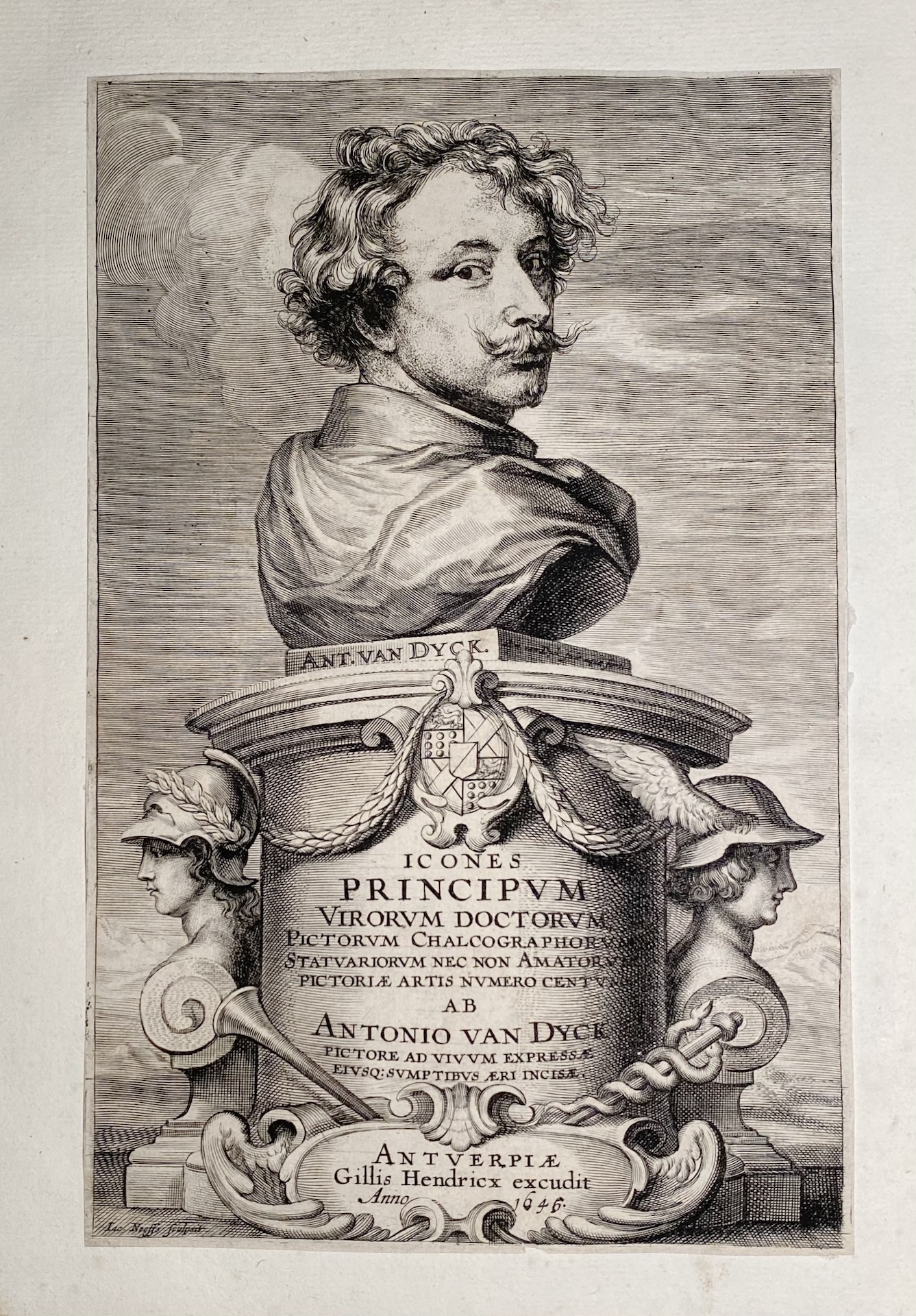
1. Engraved title page by Jacob Neeffs in 1646. On the slab supporting the bust, left: “ANT. VAN DYCK”, right: “Ant. van Dyck fecit aqua forti”. On the face of pedestal: “PRINCIPVM | VIRORVM DOCTORVM, | PICTORVM CHALCOGRAPHORVM, | STATVARIORVM NEC NON AMATORVM | PICTORIÆ ARTIS NVMERO CENTVM | AB | ANTONIO VAN DYCK, | PICTORE AD VIVVM EXPRESSÆ | EIVSQ: SVMPTIBVS ÆRI INCISÆ.” In cartouche: “ANTVERPIÆ | Gillis Hendricx excudit | Anno 1645” (corrected by hand “1646”). At lower left margin: “Iac. Neeffs Sculpsit.” The print with cut off margins pasted to the bound-in leaf. Size of the print: 24.3 x 15.8 cm. 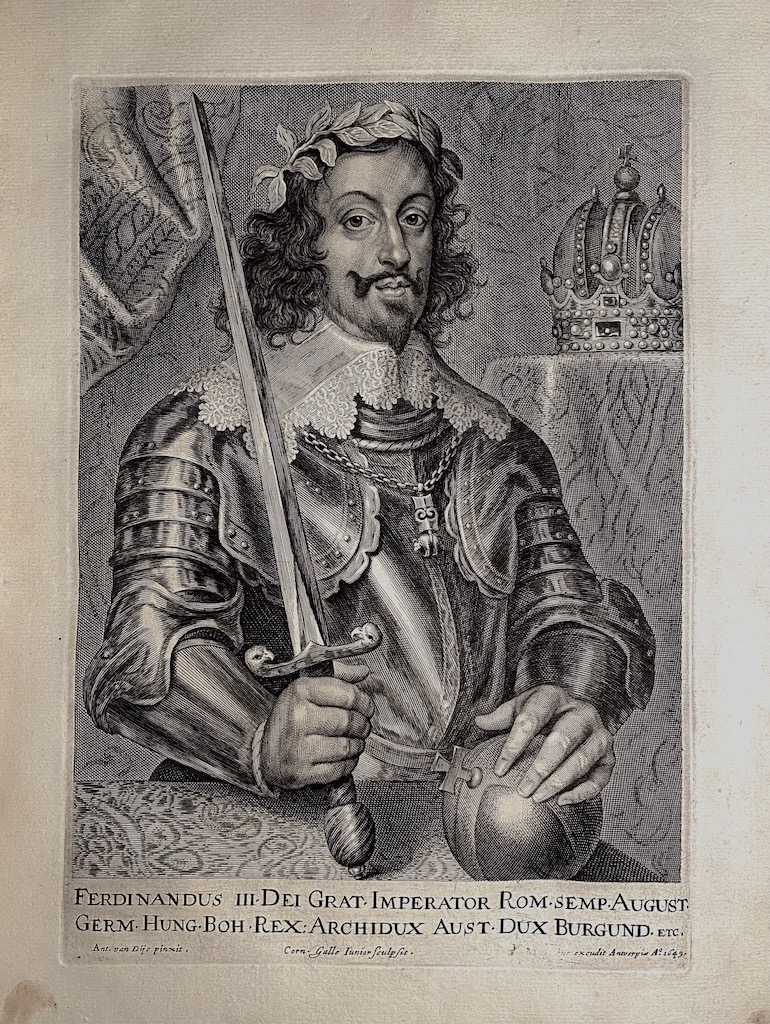
2. Ferdinand III, Holy Roman Emperor and King of Hungary and Bohemia (1608 – 1657); engraved by Cornelis Galle the Younger (Flemish, 1615–1678) in 1649. Inscription: “FERDINANDUS III. DEI GRAT. IMPERATOR ROM.SEMP.AUGUST. | GERM. HUNG. BOH. REX: ARCHIDICUX AU ST. DUX BURGUND. ETC.”. Below: “Ant. van Dÿc pinxit” <–> “Corn. Galle Iunior sculp∫it.”<–> “…excudit Antuerpiæ A.o 1649”. Second state with Meyssens’ name burnished. 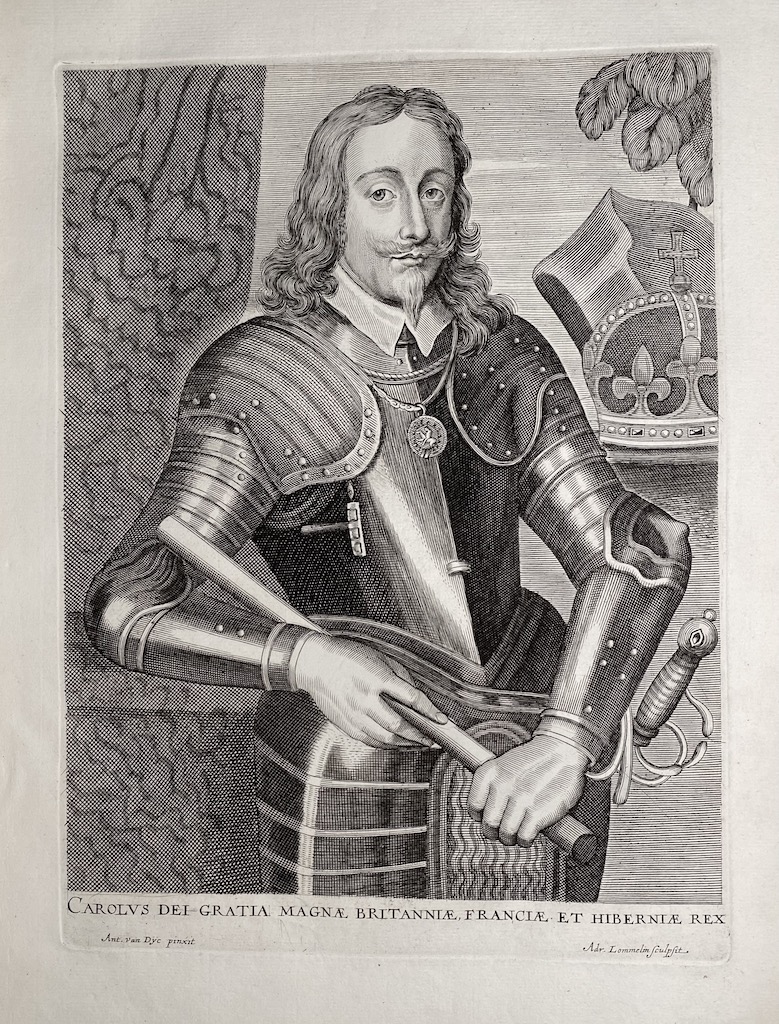
3. Charles I, King of England, Scotland, and Ireland (British, 1600 – 1649); engraved by Adriaen Lommelin (French, 1637 – c. 1673). Inscription: “CAROLVS DEI GRATIA MAGNÆ BRITANNIÆ, FRANCIÆ ET HIBERNIÆ REX”. Below: “Ant. van Dÿc pinxit” <–> “Adr. Lommelin sculpsit”. 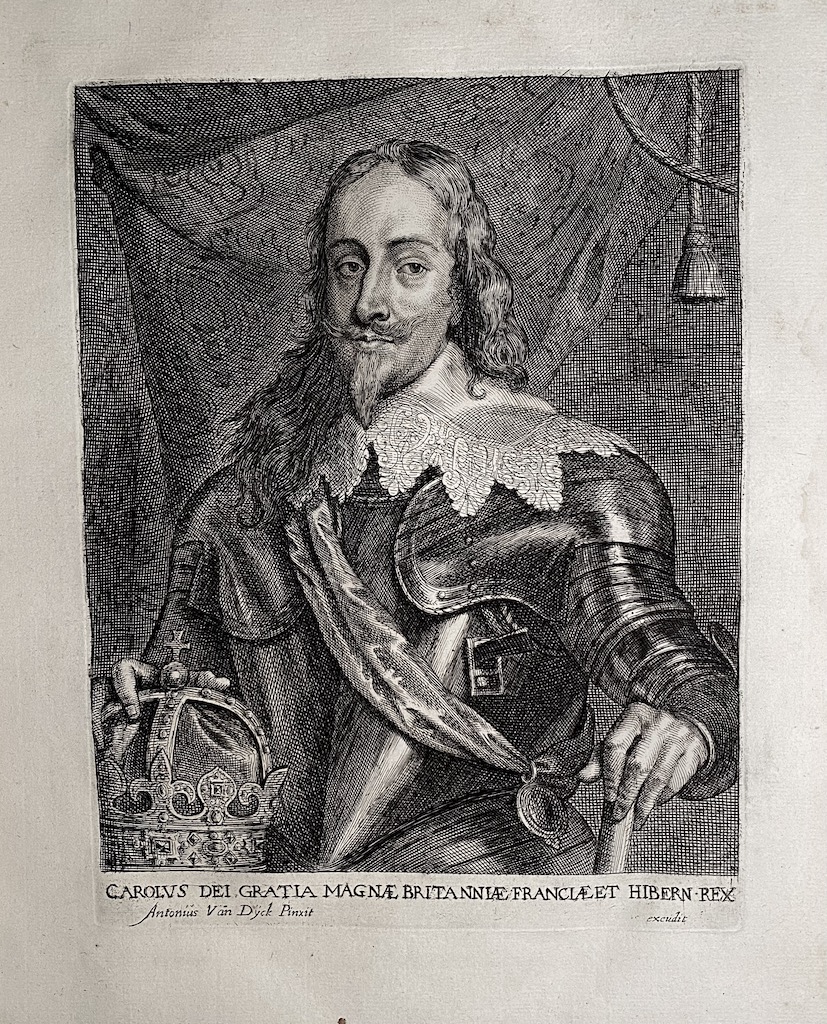
4. Charles I, King of England, Scotland, and Ireland (British, 1600 – 1649); engraved by Johannes [Jan] Meyssens (Flemish, 1612 – 1670). Inscription: “CAROLVS DEI GRATIA MAGNÆ BRITANNIÆ, FRANCIÆ ET HIBERNIÆ REX”. Below: Antonius Van Dÿck eques pinxit” <–> “...excudit”. Meyssens’ name burnished. [See similar print №61 with Ioannes Meysens name present]. 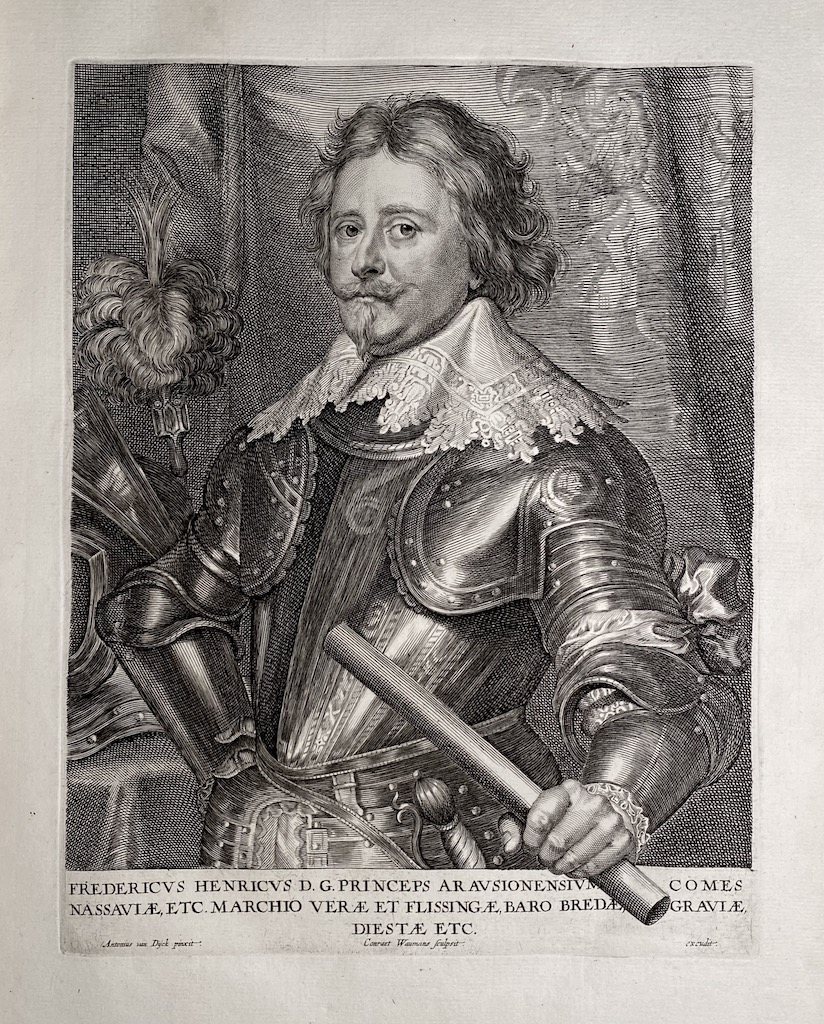
5. Frederick Henry, Prince of Orange, Count of Nassau (Dutch, 1584 – 1647); engraved by Conrad Waumans [Woumans] (Flemish, 1619 – after 1675). Inscription: “FREDERICVS HENRICVS, D.G. PRINCEPS ARAVSIONENSIVM, COMES | NASSAVIÆ, ETC. | MARCHIO VERÆ ET FLISSINGÆ, BARO BREDÆ GRAVÆ, | DIESTÆ ETC.” Below: “Antonius van Dÿck pinxit” <–> “Conraet Waumans sculpsit” <–> “…excudit”. Meyssens’ name burnished. [Similar to №57, but with Ioannes Meyssens name in place]. 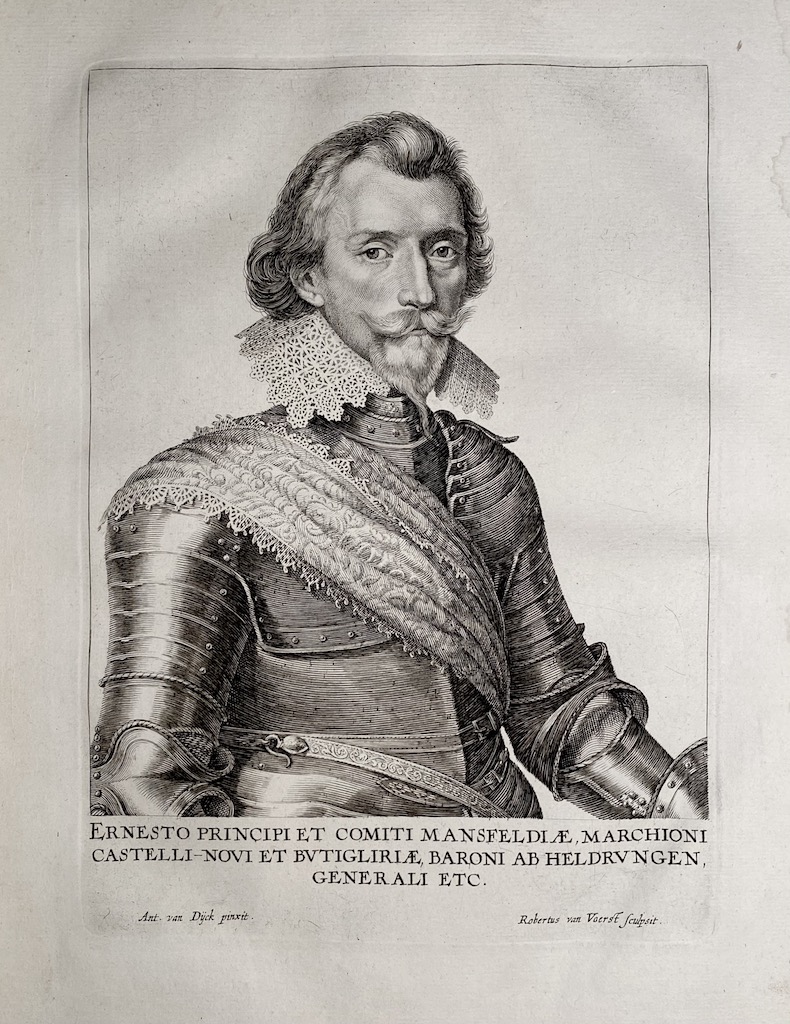
6. Count Ernst von Mansfield (German, 1580 – 1626); engraved by Robert van Voerst (Dutch, 1597 – 1636). Inscription: “ERNESTO PRINCIPI ET COMITI MANSFELDIÆ, MARCHIONI | CASTELLI-NOVI ET BUTIGLIRIÆ, BARONI AB HELDRUNGEN, GENERALI ETC.” Below “Ant. Van Dÿck pinxit” <–> “Robertus van Voerst Sculpsit”. 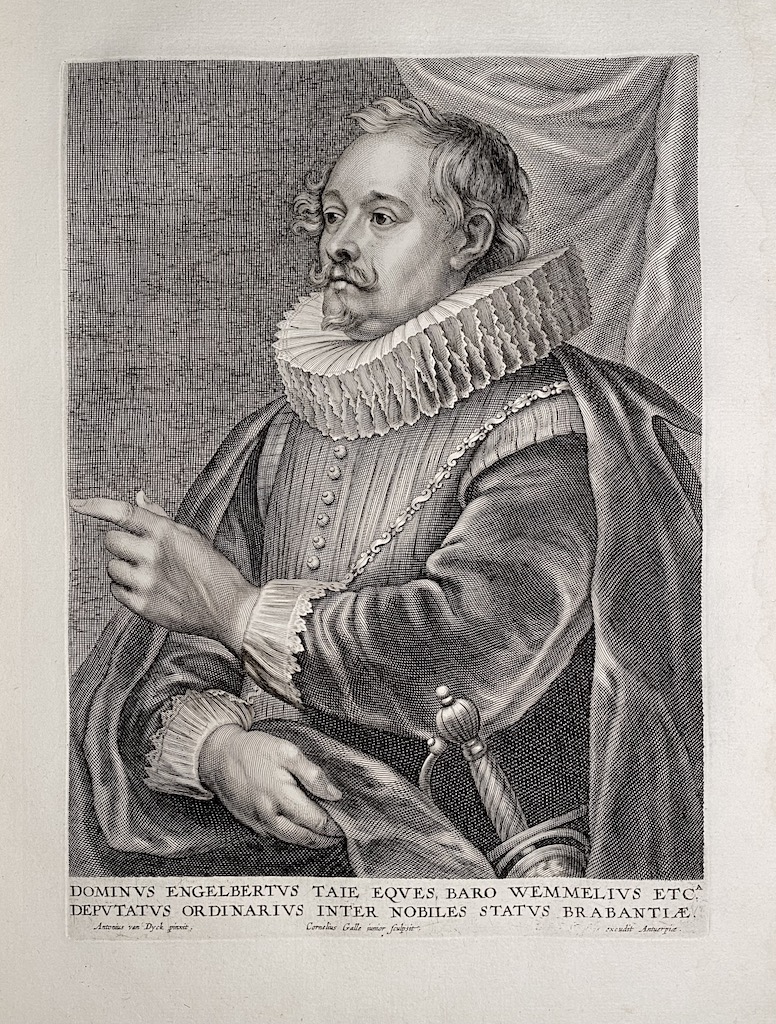
7. Engelbert Taye, Baron of Wemmel (Flemish, ? – 1638); engraved by Cornelis Galle the Younger. “DOMINVS ENGELBERTVS TAIE EQVES, BARO WEMMELIVS ETC.A | DEPVTATVS ORDINARIVS INTER NOBILES STATVS BRABANTIÆ.”. Below: “Antonius van Dyck pinxit”, “Cornelius Galle iunior ∫culpsit” <–> “…excudit Antuerpiæ.”. Second state, with “Ioannes Meyssens” erased. 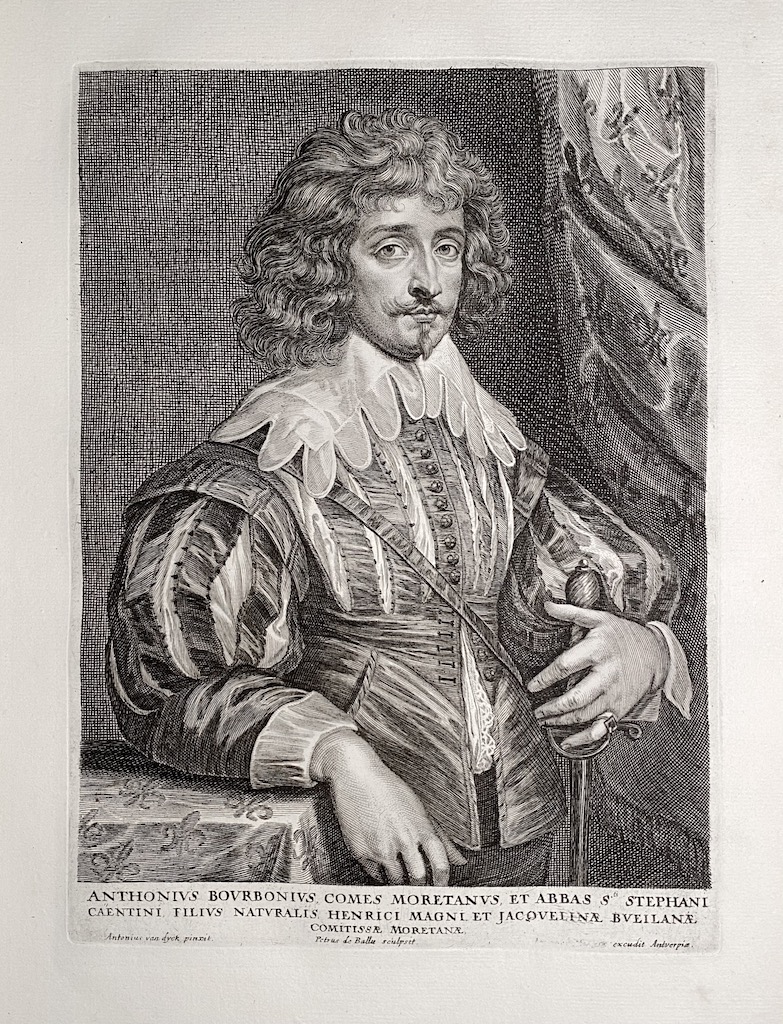
8. Antoine de Bourbon, comte de Moret (French, 1607 – 1632); engraved by Pieter de Bailliu (Flemish, 1613 – after 1660). Inscription: “ATHONIVS BOVRBONIVS, COMES MORETANVS, ET ABBAS S.TI STEPHANI | CAENTINI, FILIVS NATVRALIS, HENRICI MAGNI ET JACQVELINÆ BVEILANÆ | COMITISSÆ MORETANÆ,”. Below: “Antonius van dyck pinxit.” <–> “Petrus de Ballu sculpsit.” <–>“… excudit Antverpiæ.”. Second state with “Ioannes Meyssens” erased. Antoine de Bourbon was the illegitimate son of Henri IV, Roi de France and Jacqueline de Bueil, Comtesse de Moret. 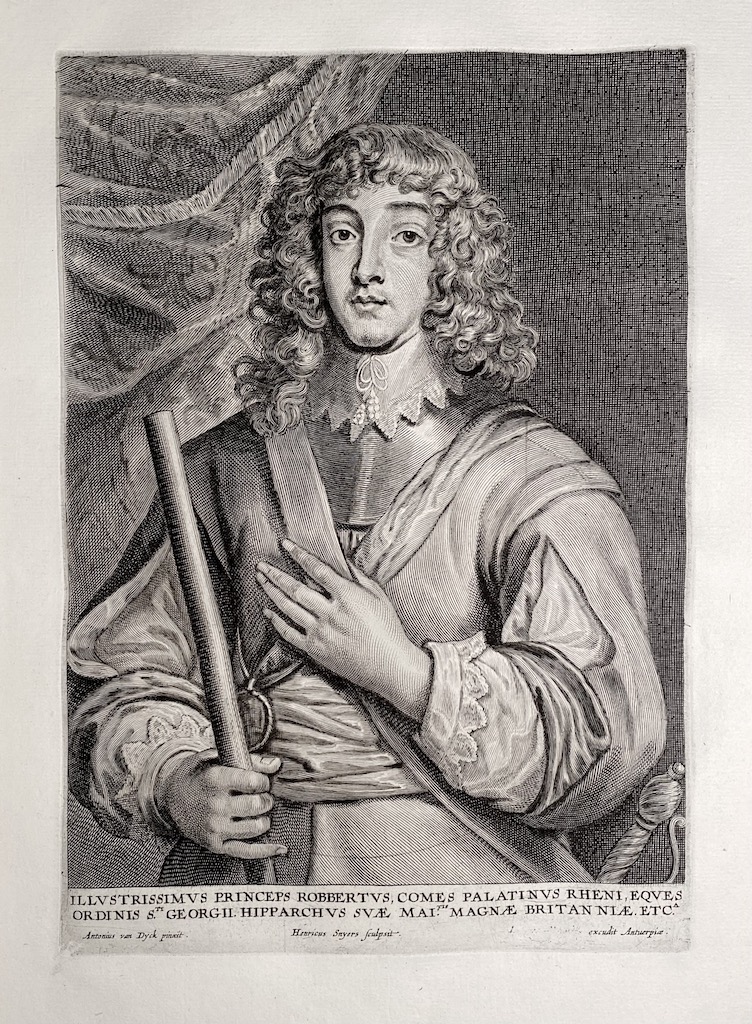
9. Prince Rupert of the Rhine (German, Bohemian, 1619 –1682); engraved by Hendrick Snyers (Flemish, 1611 – 1644). Inscription: “ILLVSTRISSIMVS PRINCEPS ROBBERTVS, COMES PALATINVS RHENI, EQVES | ORDINIS S.TI GEORGII. HIPPARCHVS SVÆ MAI.TIS MAGNÆ BRITANNIÆ. ETC.A”. Below: “Antonius van Dyck pinxit” <–> “Henricus Snyers sculpsit” <–> “...excudit Antuerpiæ.”. Second state with “Ioannes Meyssens” erased. 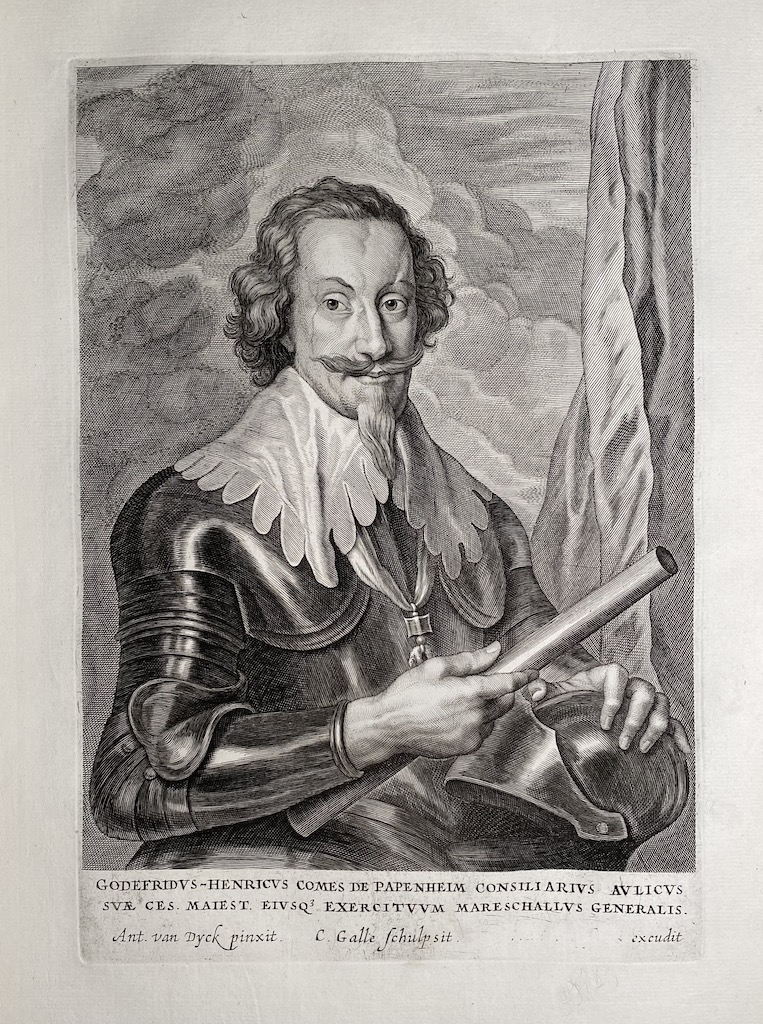
10. Gottfried-Heinrich, Count of Pappenheim; engraved by Cornelis Galle the Younger. Inscription: “GODEFRIDVS-HENRICVS COMES DE PAPENHEIM CONSILIARIVS AVLICVS | SVÆ CES. MAIES. EIVSQ³ EXERCITVVM MARESCHALLVS GENERALIS.” Lettered with production details below: “Ant. van Dyck pinxit” <–> “C. Galle ∫chulpsit.” <–> “…excudit”. Second state with “Ioan. Meyßens” erased. 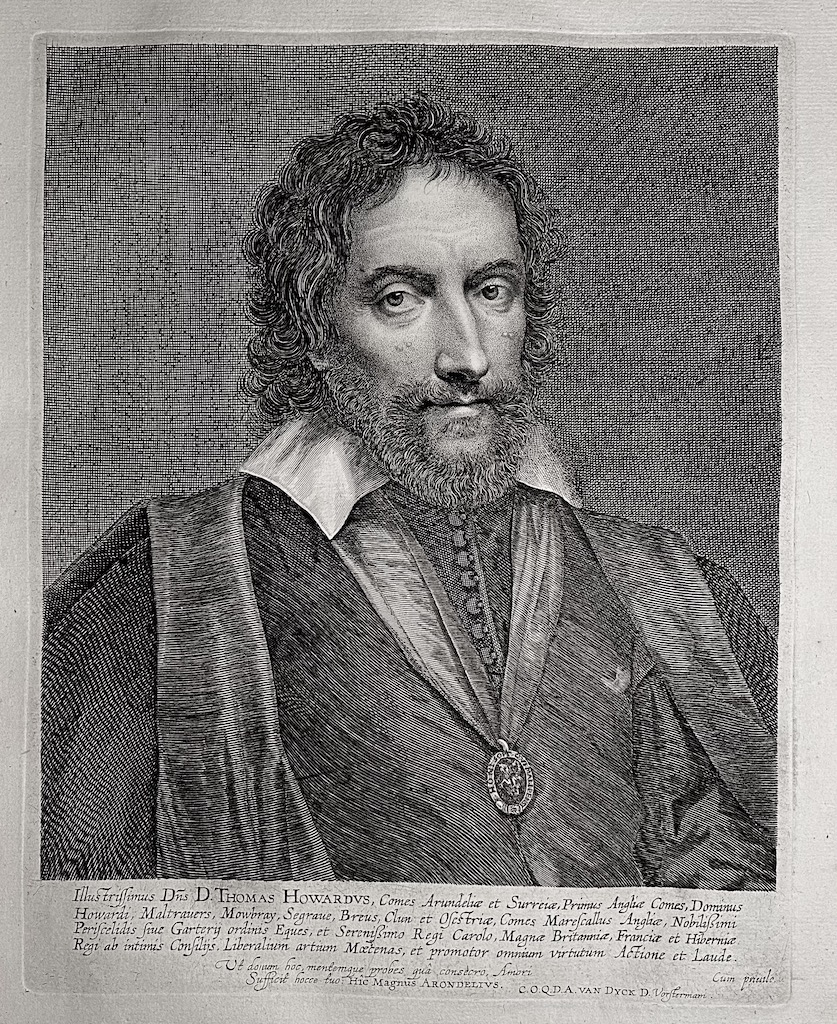
11. Thomas Howard, 14th Earl of Arundel (British, 1585 – 1646); engraved by Lucas Vorsterman the Elder (1595–1675). Inscription: “Illustri∫∫imus Dñs. D.Thomas Howardvs, Comes Arundeliæ et Surreiæ, Primus Angliæ Comes, Dominus | Howardi, Maltrauers, Mowbray, Segraue, Breus, Clun et O∫estriæ, Comes Mare∫callus Angliæ, Nobilißimi | Pericelidis ∫iue Garterij ordinis Eques, et Serenißimo Regi Carolo, Magnæ Britaniæ, Franciæ et Hiberniæ | Regi ab intimis Consilijs, Liberalium artium Mæcenas, et promotor omnion virtutum Actione et Laude.”. Below: “Ut donum hoc, mantenque probes qua consecro, Amori | Sufficit hocci tuo: Hic Magnvs ARONDELIVS”, “C.O.Q.D.A. VAN DYCK D. Vor∫termani.”, “Cum priuile.”. Third state with ‘Opera Vorstermanni’ burnished and two lines of Latin added below the four lines of the title. 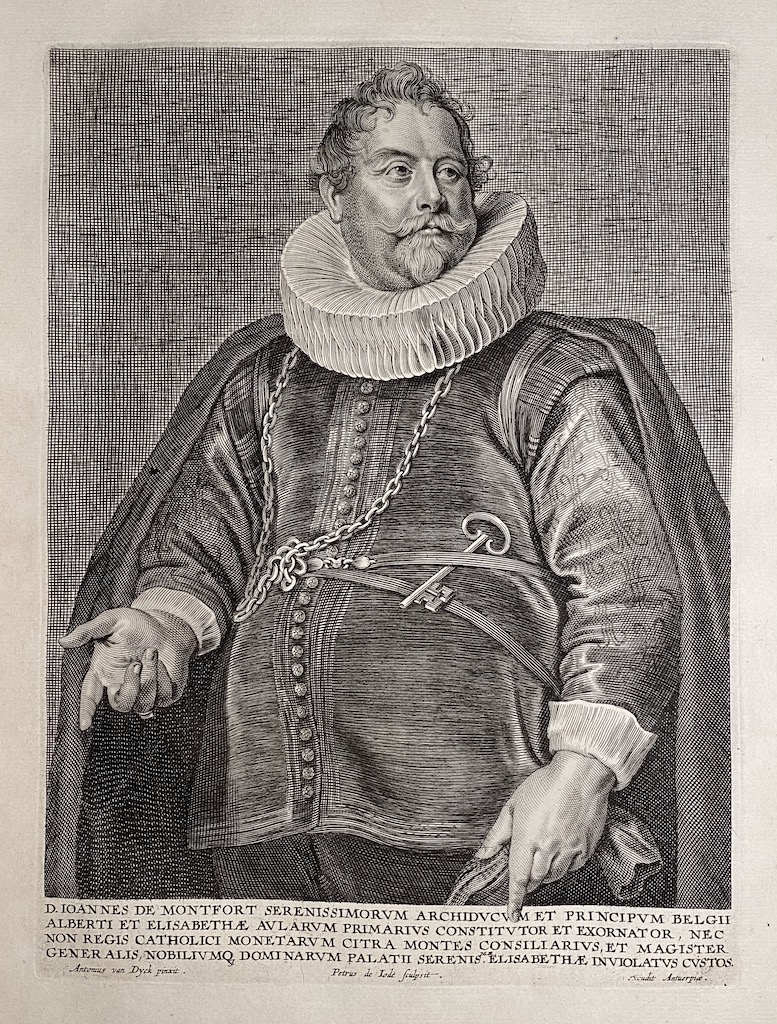
12. Jan van Montfort [Jean de Montfort] (Flemish, 1567 – 1648); engraved by Pieter de Jode II (Flemish, 1606 – 1670/74). Inscription: “D. IOANNES DE MONTFORT SERENISSIMORVM ARCHIDVCVM ET PRINCIPVM BELGII | ALBERTI ET ELISABETHÆ AVLARVM PRIMARIVS CONSTITVTOR ET EXORNATOR, NEC | NON REGIS CATHOLICI MONETARVM CITRA MONTES CONSILIARIVS, ET MAGISTER. | GENERALIS, NOBILIVMQ3 DOMINARVM PALATII SERENIS.MÆ ELISABETHÆ INVIOLATVS CVSTOS.” Below: “Antonius van Dyck pinxit.” <–> “Petrus de Iode sculpsit.” <–> “…excudit Antuerpiæ”. Second state with “Ioannes Meyssens” erased. 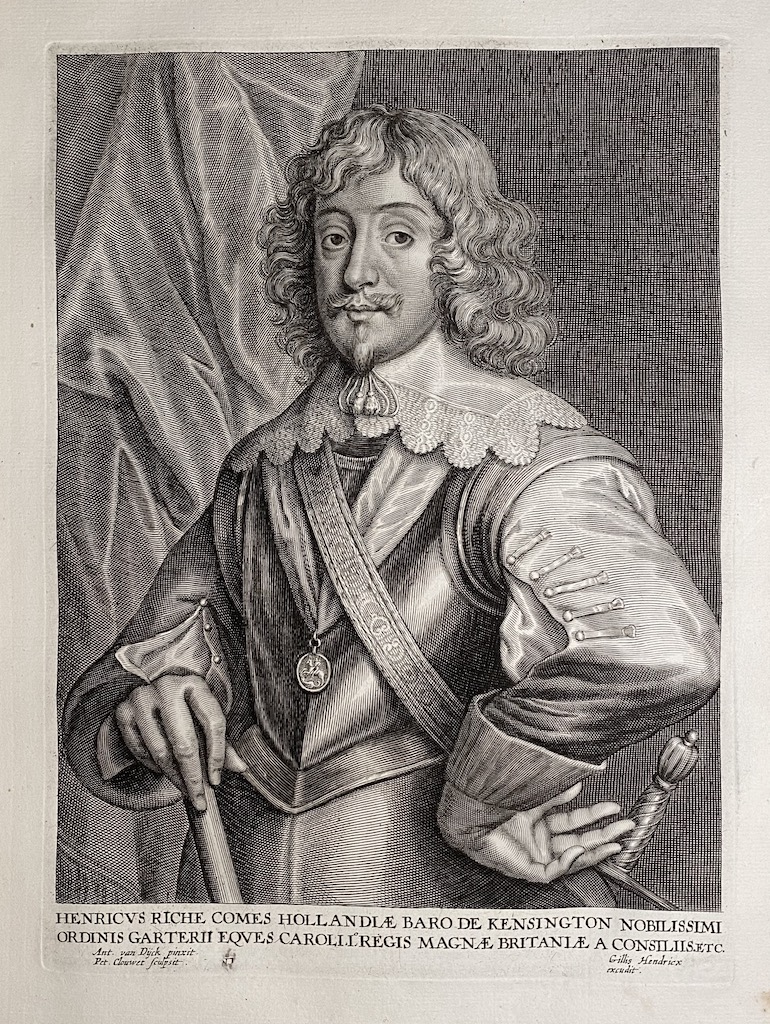
13. Henry Rich, 1st Earl of Holland (British, 1590 – 1649), engraved by Pieter Clouwet (Flemish, 1629 – 1670). Inscription: “HENRICVS RICHE COMES HOLLANDIÆ BARO DE KENSINGTON NOBILISSIMI | ORDINIS GARTERII EQVES CAROLI. LOREGIS MAGNÆ BRITANIÆ A CONSILIIS. ETC.”. Below: “Ant. van Dÿck pinxit.” | “Pet. Clouwet sculpsit” <–> “Gillis Hendricx | excudit”. Third state with the title added and production details re-engraved. 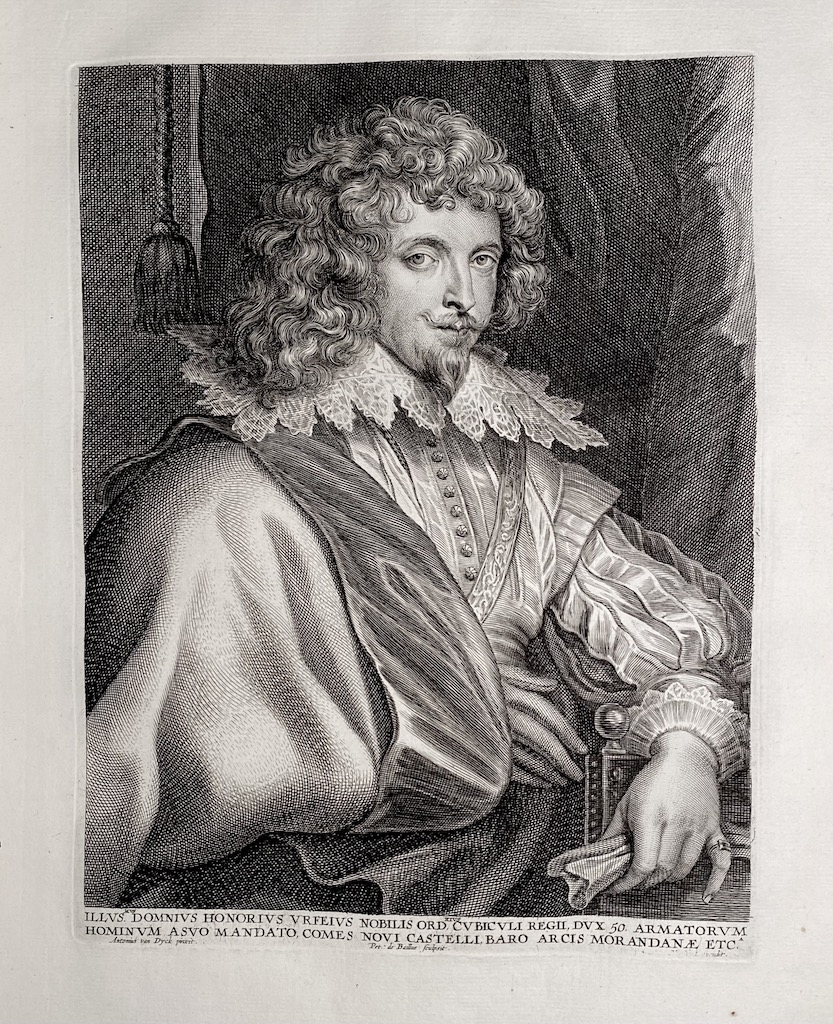
14. Honoré d’Urfé, marquis de Valromey, comte de Châteauneuf (French, 1568 – 1625); engraved by Pieter de Bailliu (Flemish, 1613 – 1660). Inscription: “ILLVS.MVS DOMNIVS HONORIVS VRFEIVS NOBILIS ORD.RIVS CVBICVLI REGII, DVX 50. ARMATORVM | HOMINVM A SVO MANDATO, COMES NOVI CASTELLI, BARO ARCIS MORANDANÆ ETC.A”. Below: “Antonius van Dyck pinxit” <–> “Pet. de Bailliue sculpsit.” <–> “… excudit”. Second lettered state with title and production details, with “Ioannes Meyssens” erased. [There is another copy in this binding, №54, where Ioannes Meysens' name is in place]. 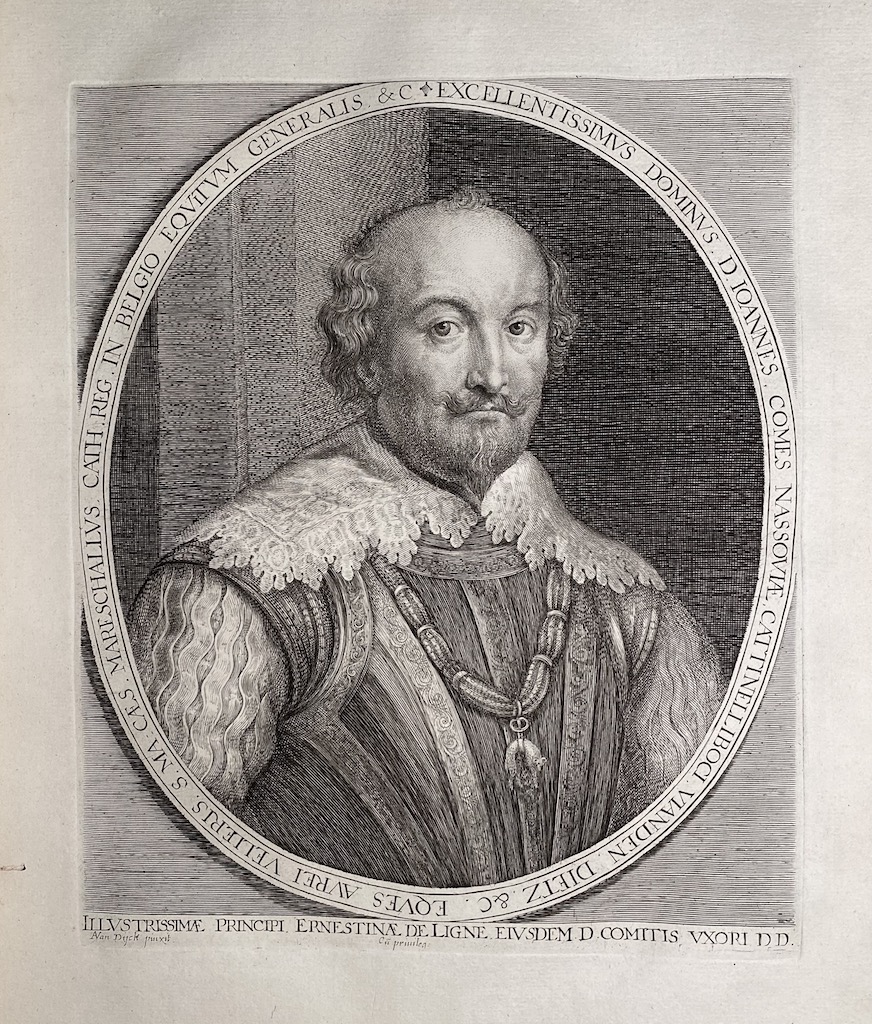
15. Johannes [John VIII], Count of Nassau-Siegen (German, 1583 – 1638); engraved by Lucas Vorsterman I (Flemish, 1595 – 1675). Inscription: in the oval around the portrait “EXCELLENTISSIMVS DOMINVS: D. IOANNES, COMES NASSAOVIÆ, CATTNELLIBOCI: VIANDEN, DIETZ, &C. EQVES AVREI VELLERIS. S. MA: CÆS, MARESCHALIVS, CATH. REG. IN BELGIO. EQVITVM GENERALIS. &C”, in lower margin: “ILLVSTRISSIMÆ PRINCIPI ERNESTINÆ DE LIGNE EIVSDEM D. COMITIS VXORI DD.”, and “AVan Dÿck pinxit.” <–> “Cu Priuleg”. Fourth state with Vorsterman’s address burnished. [For the third state with “Lucas Vorsterman exc” present see № 55]. 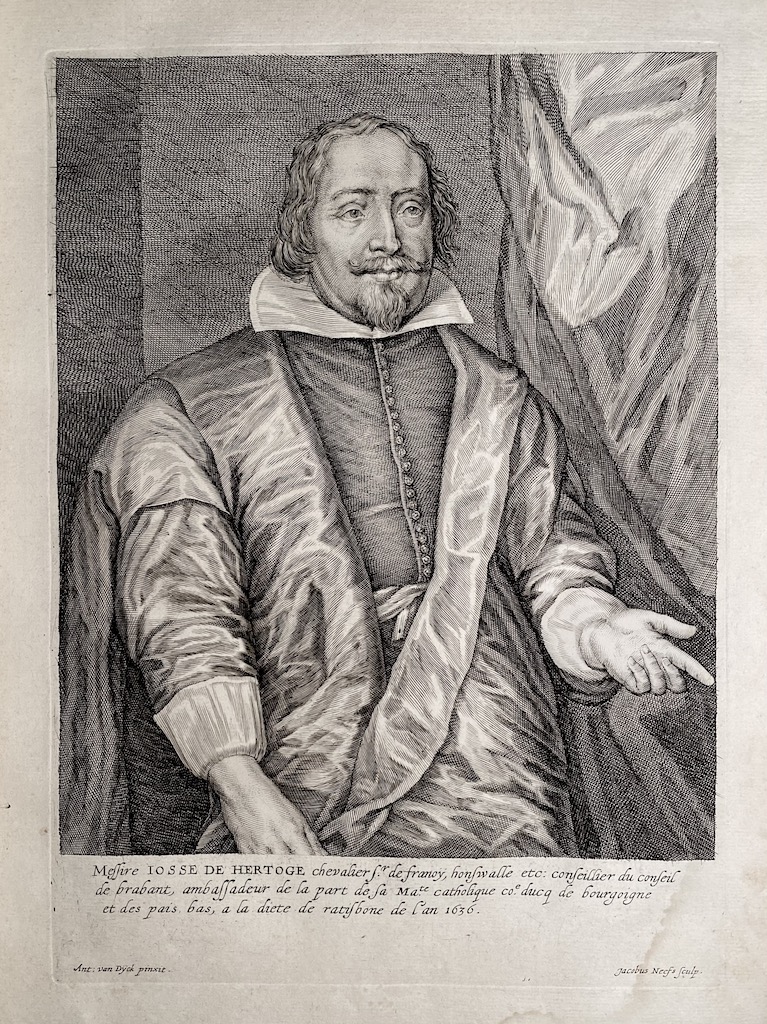
16. Joost de Hertoghe (Flemish, ? –1638); engraved by Jacobus Neefs. Inscription: "Me∫∫ire IOSSE DE HERTOGE chevalier ∫.r de franoÿ, hon∫walle etc: con∫eillier du conseil | de brabant, amba∫∫adeur de la part de ∫a Ma.te catholique co.e ducq de bourgoigne | et des pais bas, a la diete de rati∫bone de l'an 1636." In Lower margine: "Ant: van Dÿck pinxit.", <–>"Jacobus Neefs ∫culp.". Second, lettered state with the title and production details added. 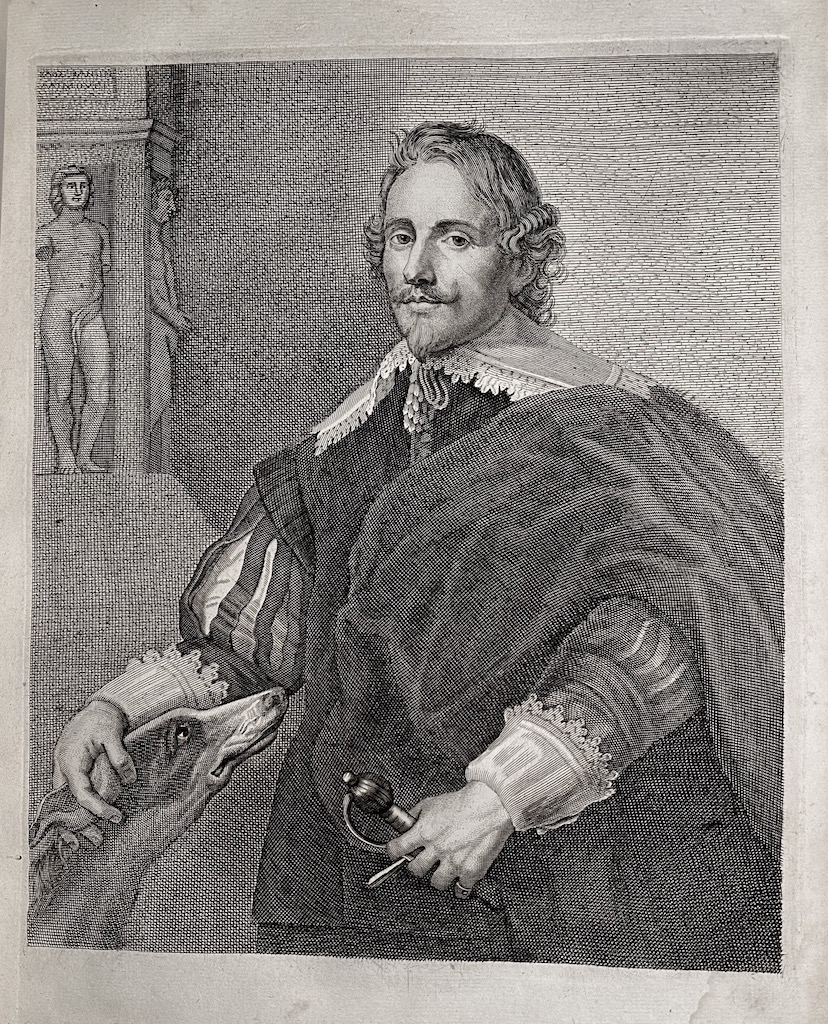
17. Philippe Le Roy (Flemish, 1596 – 1679). No inscription. The printmaker is unidentified but is possibly Adriaen Lommelin. The print is a copy of the print by Vorsterman and Pontius. 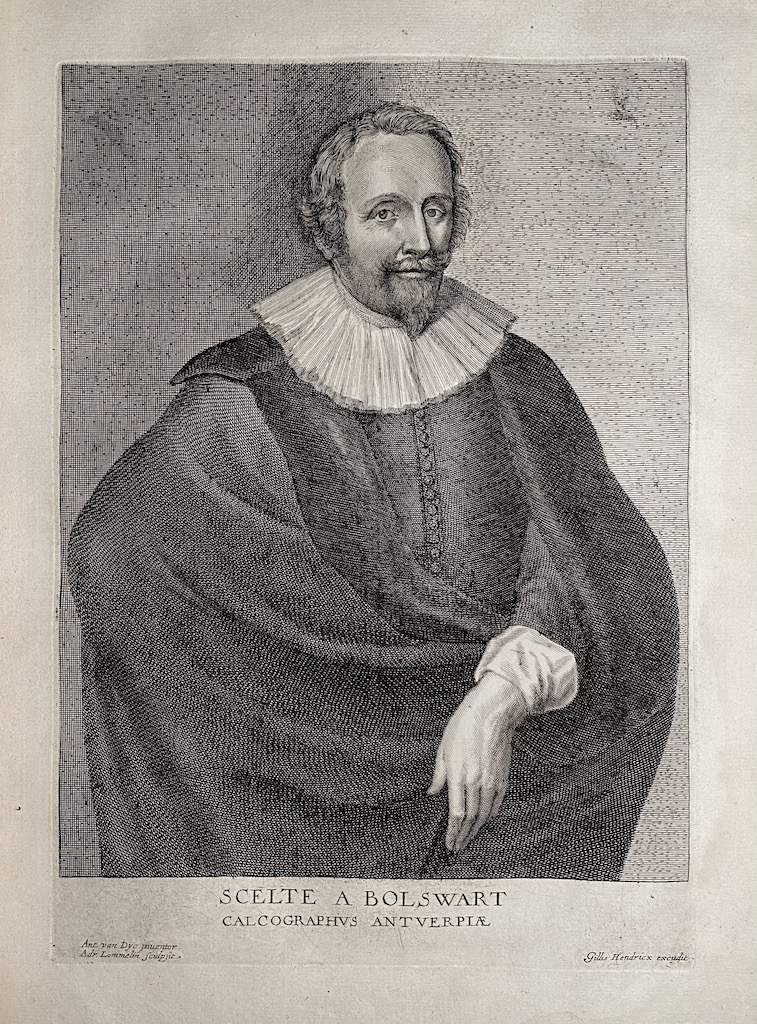
18. Schelte Adamsz. Bolswert (Flemish, c. 1586 – 1659); engraved by Adriaen Lommelin, published by Gillis Hendricx. Inscription: “SCELTE A BOLSWART | CALCOGRAPHVS ANTVERPIÆ”. In lower margin: “Ant. van Dÿc inuentor | Adr. Lommelin sculpsit” <–> “Gillis Hendricx excudit”. Third state with an entirely different head, title and production details added. 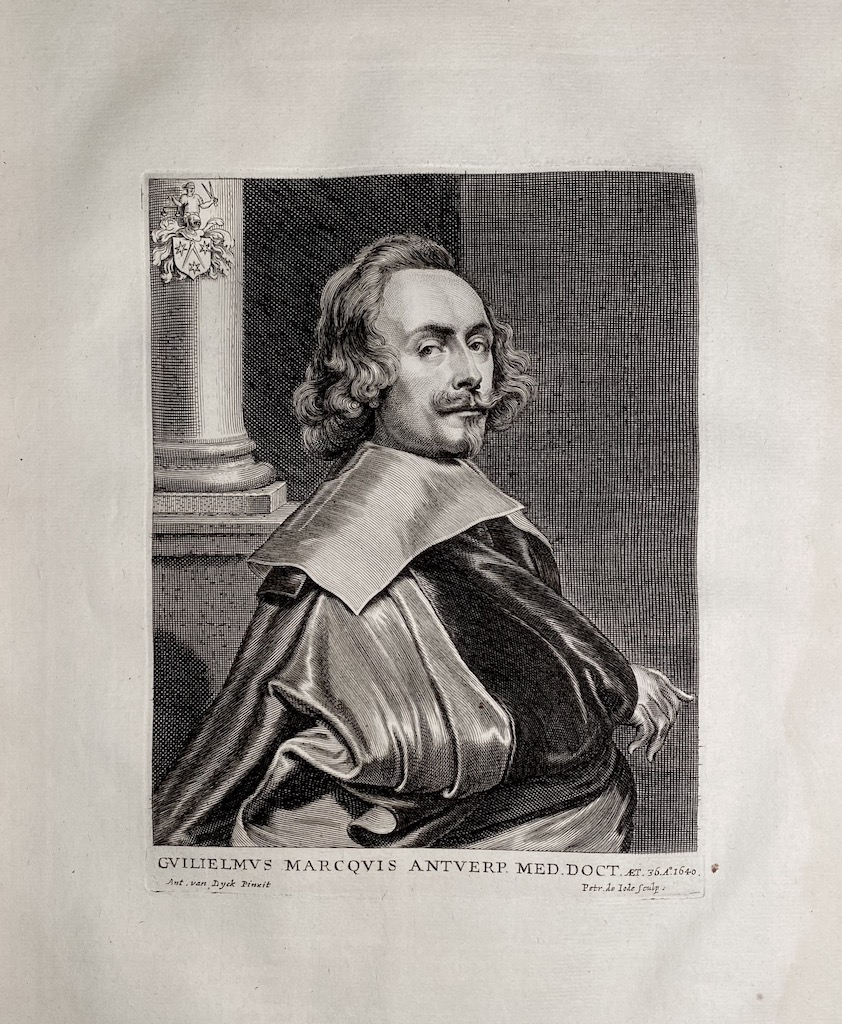
19. Willem Marquis (Flemish, 1604 – 1640); engraved by Pieter de Jode II. Inscription: “GVILIELMVS MARCQUIS ANTVERP. MED. DOCT. ÆT. 36.A.O 1640.” In lower margin: “Ant. van Dyck Pinxit” <–> “Petr. de Iode sculp.”. Second, lettered state with Borreken’s name burnished and replaced by Van Dyck’s. 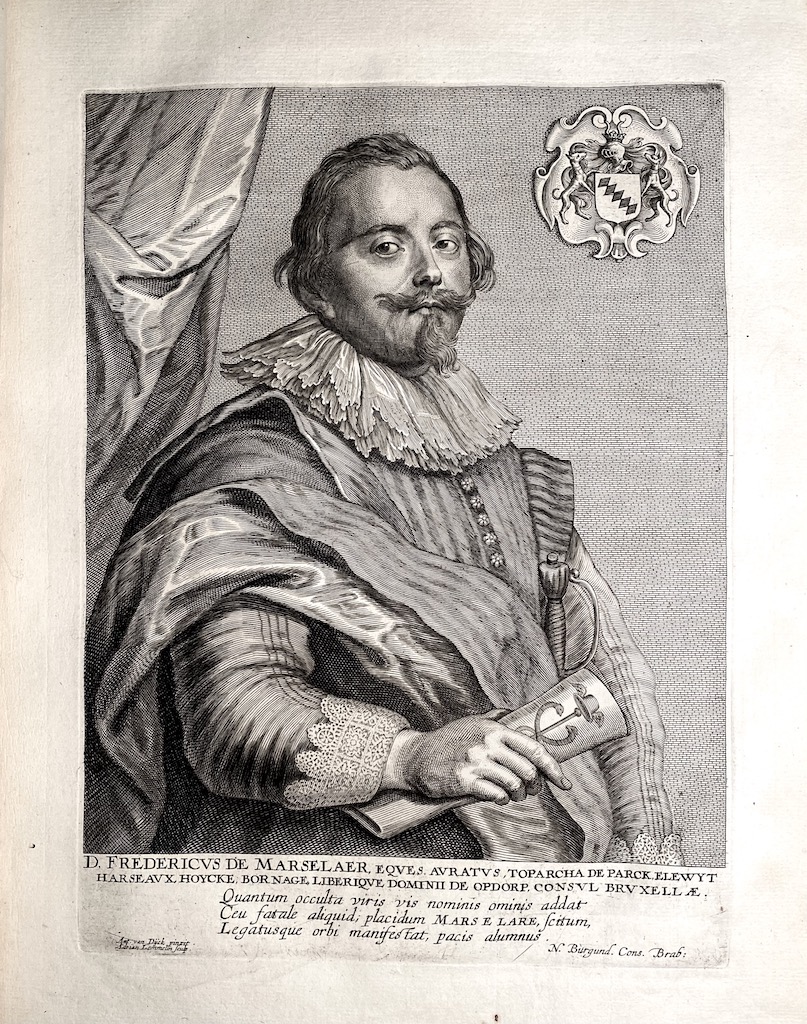
20. Frederik de Marselaer (Flemish, 1584 – 1670); engraved by Adriaen Lommelin. Inscription: “D. FREDERICVS DE MARSELAER, EQVES AVRATVS, TOPARCHA DE PARCK, ELEWYT | HARSEAVX, HOYCKE, BORNAGE, LIBERIQUE DOMINII DE OPDORP, CONSVL BRVXELLÆ.” Three lines of verse below: “Quantum occulta viris vis nominis ominis addat | Ceu fatale aliuid; placidum Mars E Lare, scitum, | Legatusue orbi manifestat, pacis alumnus.”. In lower margin: “Ant. van Dÿck pinxit | Adrian Lommelin sculpsit” <–> “N. Burgund. Cons. Brab:”. Third state with the roll of paper rounded. 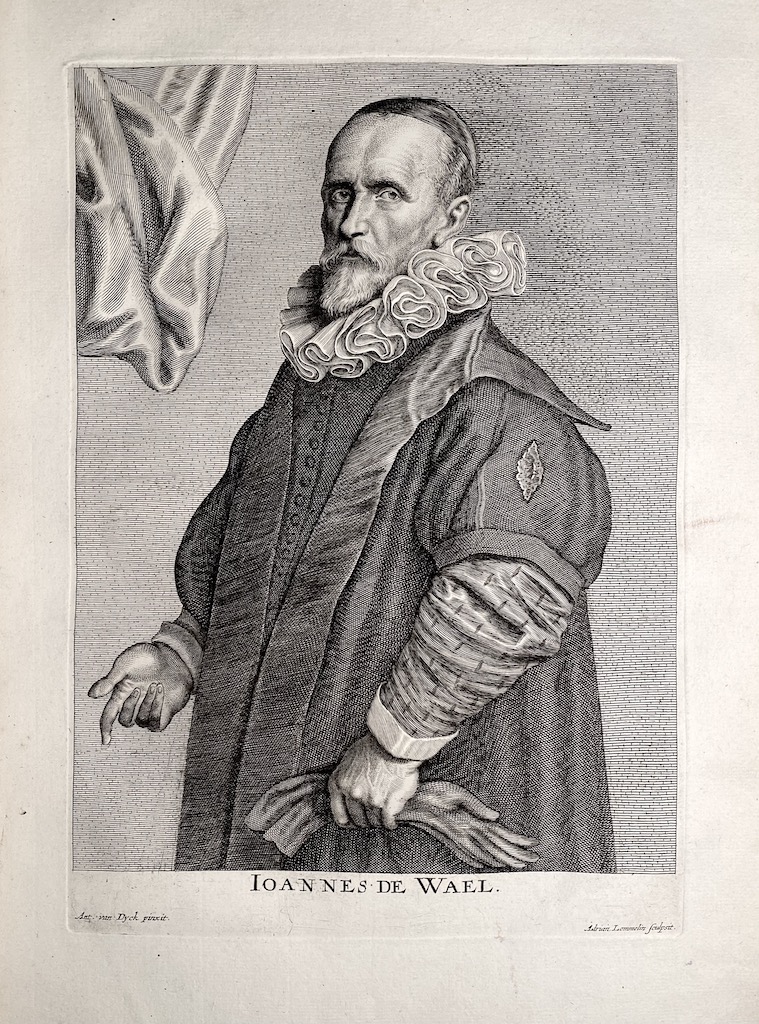
21. Jan Baptist de Wael I (Flemish, 1558 – 1633); engraved by Adriaen Lommelin. Inscription: “IOANNES DE WAEL.”. In lower margin: “Ant. van Dyck pinxit.”<–> and “Adrian Lommelin sculpsit.”. Second, lettered state with the title and production details. British Museum № 1872,1012.4168. 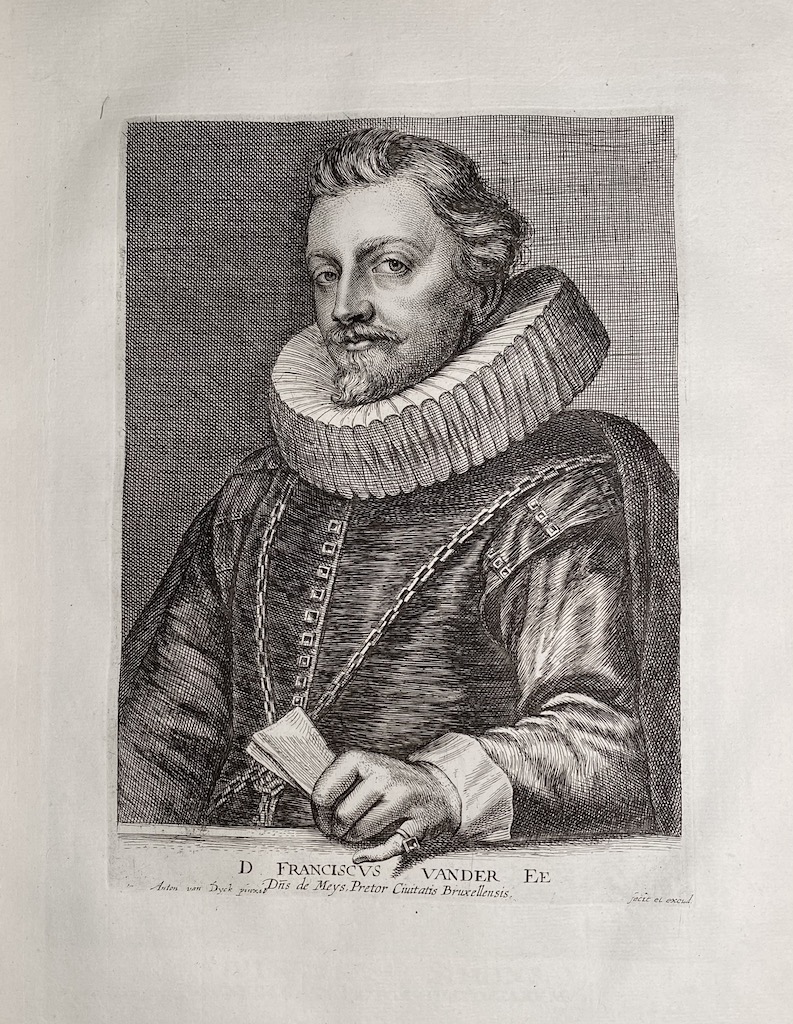
22. François van der Ee (Flemish, ? – 1645); engraved and published by Johannes Meyssens. Inscription: “D . FRANCISCVS VANDER EE | Dñs de Meys, Pretor Ciuitatis Bruxellensis”. In lower margin: “Anton van Dyck pinxit”, and “fecit et excud.”. Fourth, lettered state, finished with the burin, with second line added to the title, with address “Ioannes Meyssens” almost completely burnished. 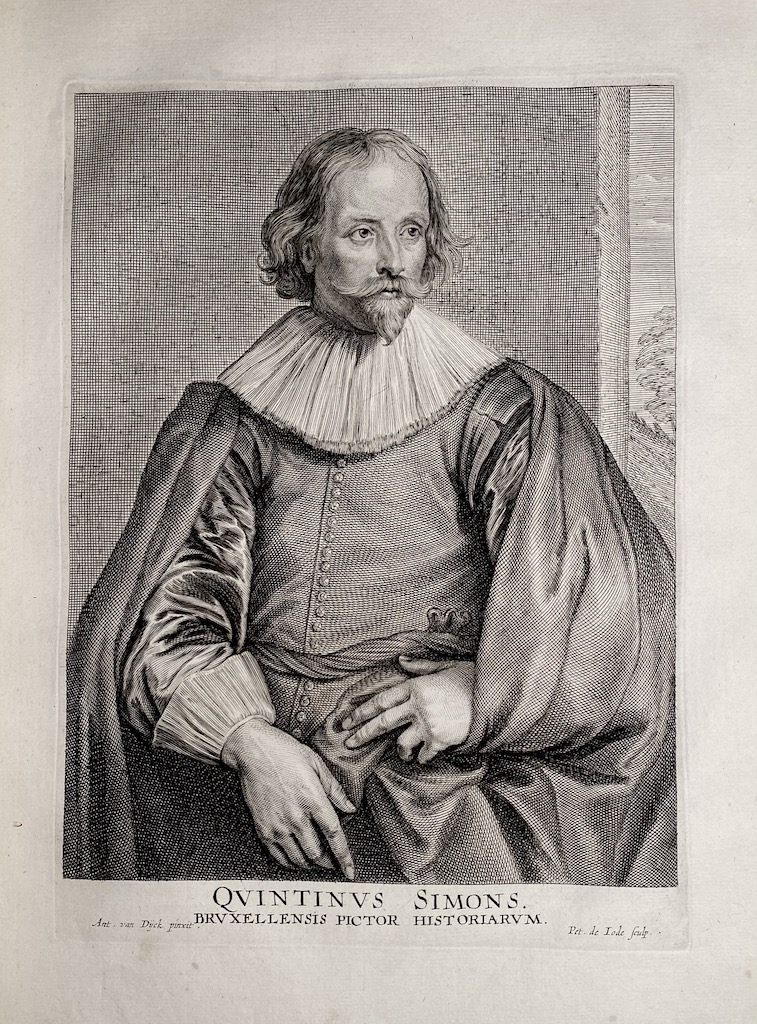
23. Quintijn Simons (Flemish, 1592 – after 1634); engraved by Pieter de Jode II. Inscription: “QVINTINVS SIMONIS. | BRVXELLENSIS PICTOR HISTORIARVM.”. In lower margin: “Ant. van Dijck pinxit.” <–> “Pet. de Iode sculp.”. Third state with second line of title added. 
24. Adriaan Stevens (Flemish, 1561 – 1640); engraved by Adriaen Lommelin. Inscription: "INTEGERRIMVS VIR ADRIANVS STEVENS / S.P.Q. ANTVERP. AB ELEMOSYNIS.". In lower margin:"Ant van Dÿc pinxit." <–> "A. Lommelin sculp.". British Museum # R,1b.20. 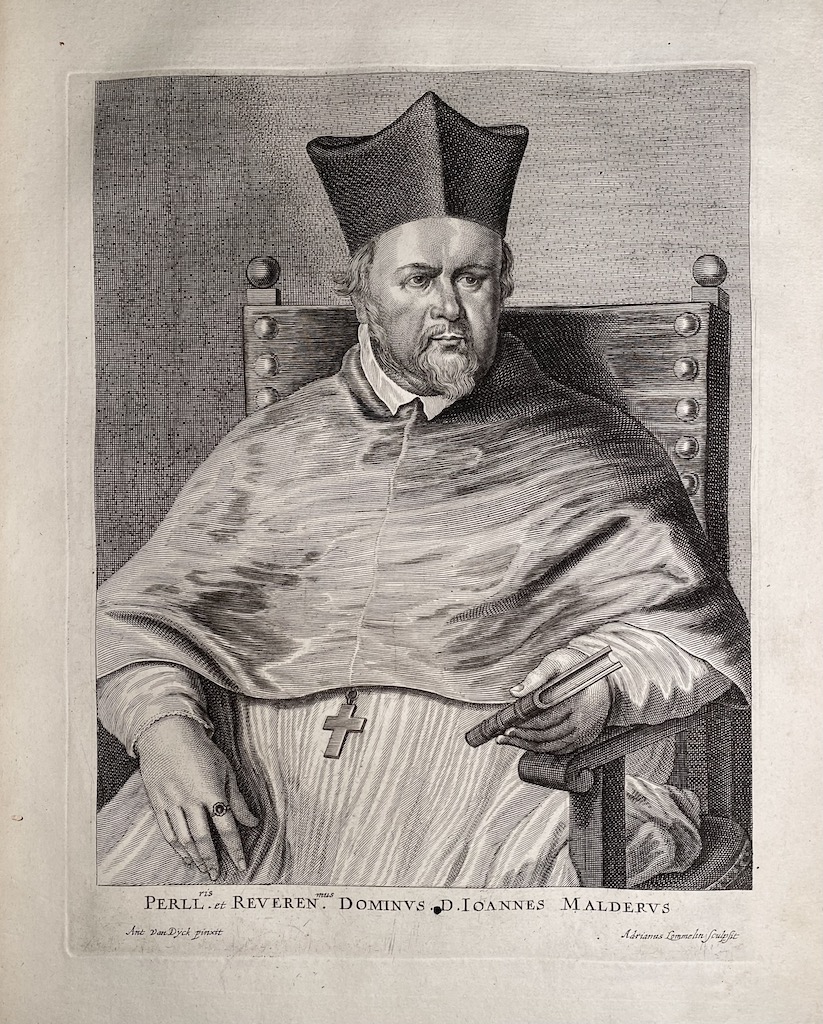
25. Jan van Malderus (Flemish, 1563 – 1633); engraved by Adriaen Lommelin. Inscription: “PERLL.ris et REVEREN.mus DOMINVS. D. IOANNES MALDERVS”. In lower margin: “Ant Van Dÿck pinxit” <–> “Adrianus Lommelin sculpsit”. 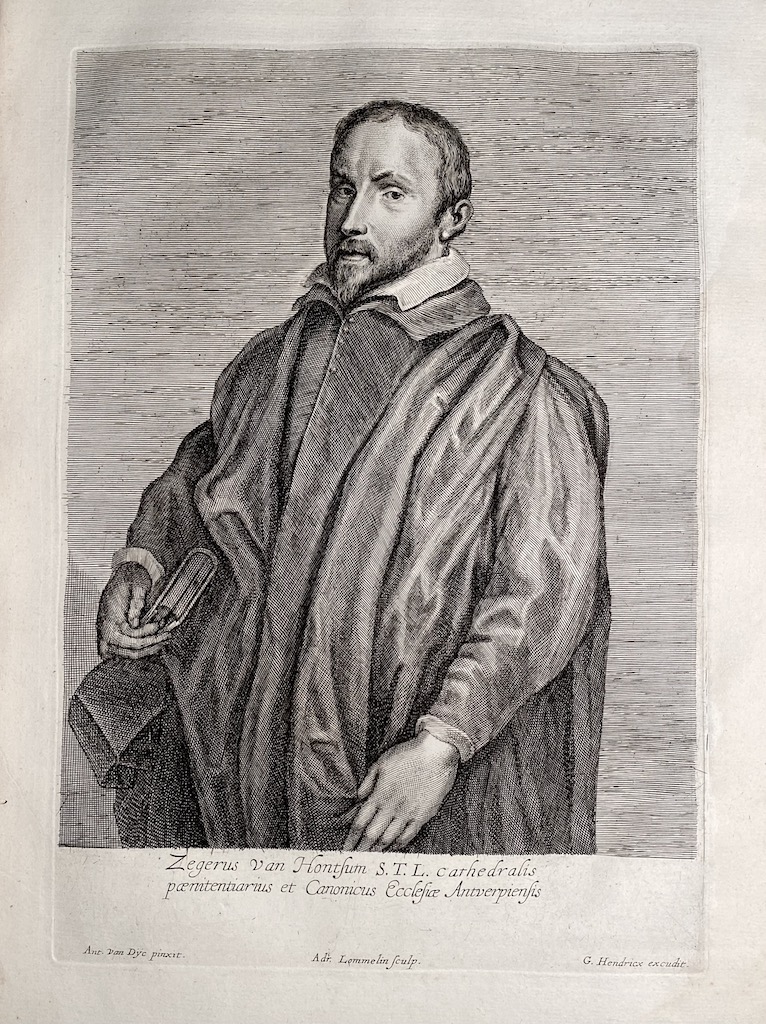
26. Zeger van Hontsum (Flemish, ? – -1643). Engraved by Adriaen Lommelin, published by Gillis Hendricx. Inscription: “Zegerus van Hontsum S.T.L. cathedralis | pænitentiarius et Canonicus Ecclesiæ Antuerpiensis”. In lower margin: “Ant. van Dÿc pinxit” <–> “Adr. Lommelin sculp.” <–> “G. Hendricx excudit”. 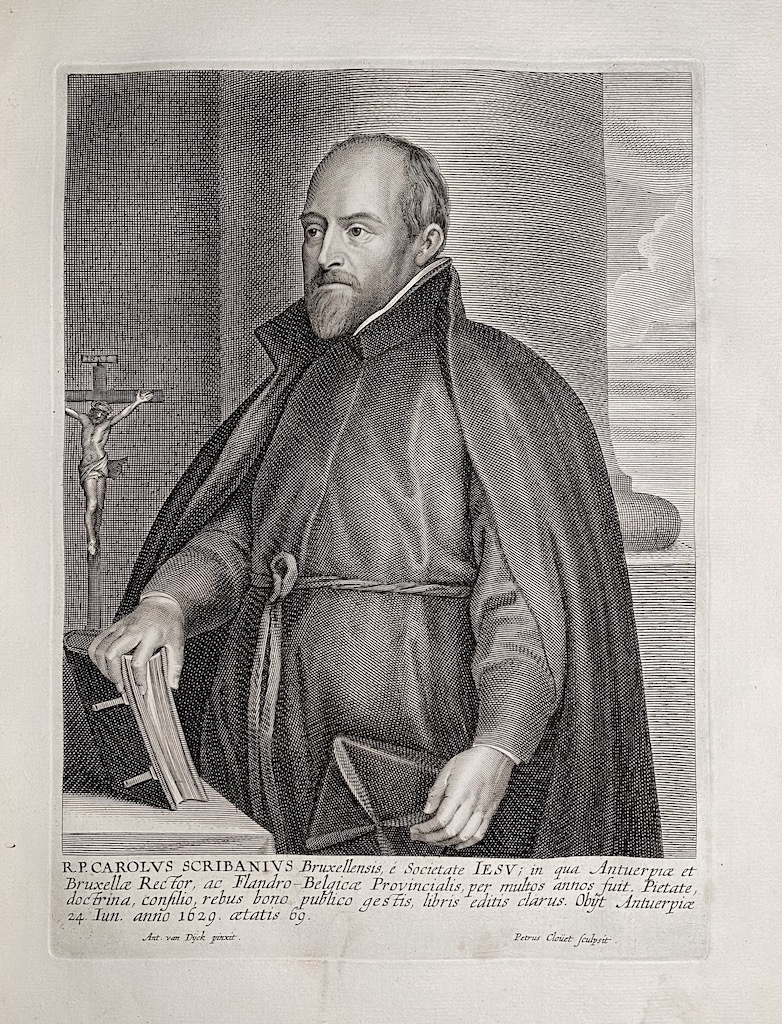
27. Carolus Scribani (Flemish, 1561 – 1629); engraved by Pieter Clouwet. Inscription: “R. P. CAROLVS SCRIBANIVS Bruxellensis, é Societate IESV; in qua Antuerpiæ et I Bruxellæ Rector, ac Flandro-Belgicæ Provincialis, per multos annos fuit. Pietate, | doctrina, consilio, rebus bono publico gestis, libris editis clarus. Obijt Antverpiæ | 24. Iun. anno 1629. ætatis 69.”. In lower margin: “Antonius van Dÿck pinxit.” <–> “Petrus Cloüet Sculpsit.”. Second, lettered state with the title and production details. 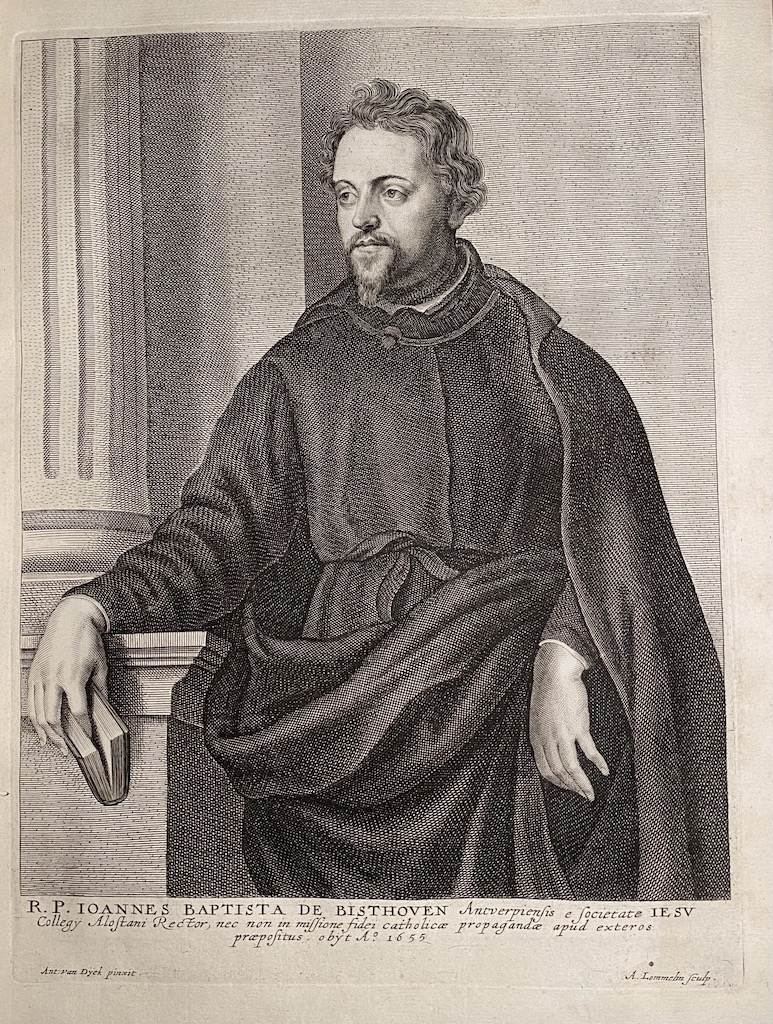
28. Jan Baptist van Bisthoven (Flemish, 1602 – 1655); engraved by Adriaen Lommelin. Inscription: “R.P. IOANNES BAPTISTA DE BISTHOVEN Antverpiensis e societate IESV | Collegÿ Alostani Rector, nec non in missione fidei catholicæ propagandæ apud exteros | præpositus obÿt A.o 1655”. In lower margin: “Ant:van Dÿck pinxit”, and “A. Lommelin sculp”. Second, lettered state with the title and production details. 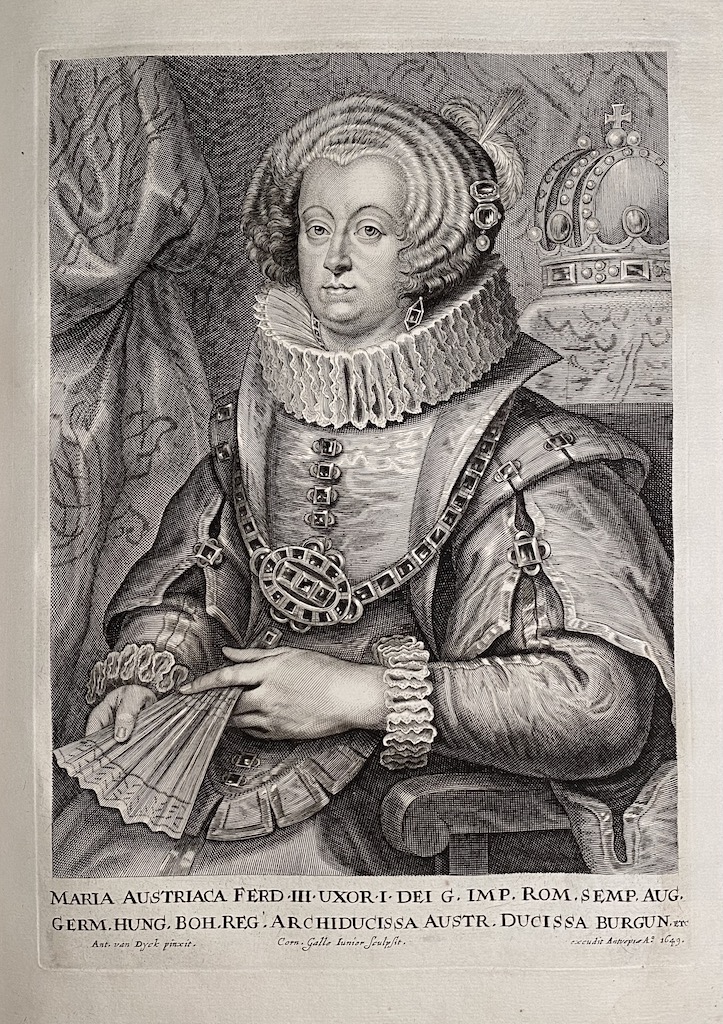
29. Maria of Austria (Spanish, 1606 – 1646); engraved by Cornelis Galle the Younger, published by Johannes Meyssens. Inscription: “MARIA AUSTRIACA FERD. III. UXOR. I. DEI G. IMP. ROM. SEMP. AUG. | GERM. HUNG. BOH. REG. ARCHIDUCISSA AUTR. DUCISSA BURGUN. ETC”. In lower margin: “Ant. van Dyck pinxit.” <–> “Corn. Galle Iunior sculpsit.” <–> “...excudit Antuerpiæ A.o 1649”. Third, lettered state with Meyssens’ name burnished badly. 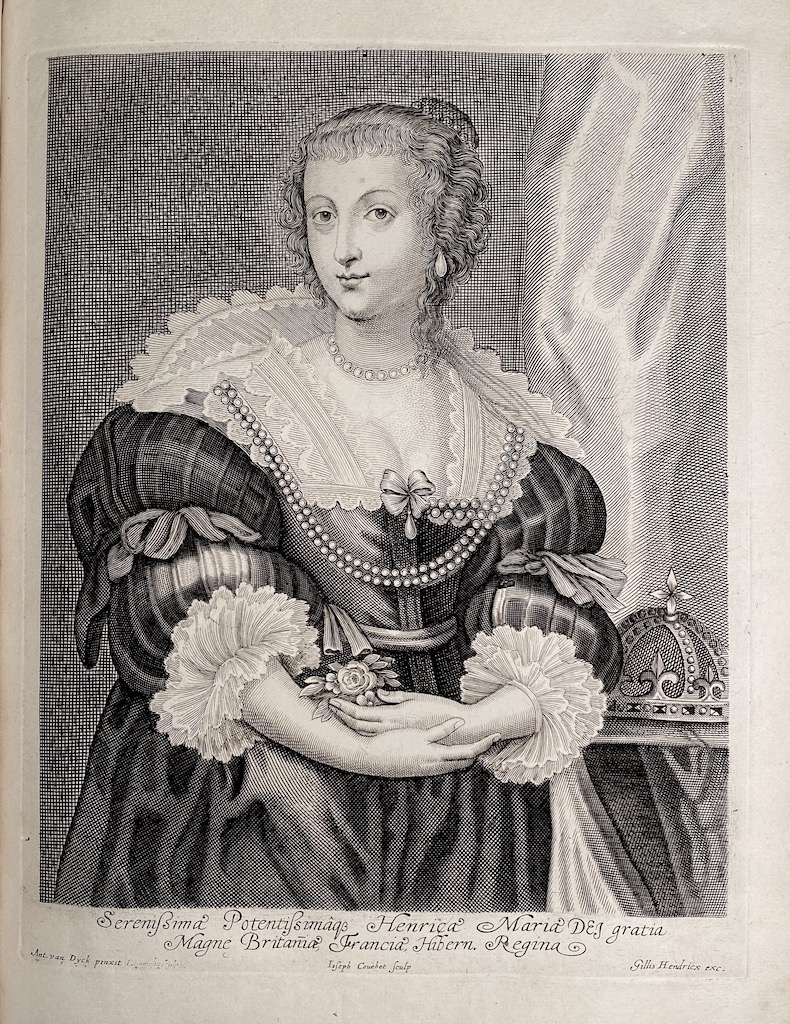
30. Henriette Marie de Bourbon, Queen of Charles I (French, 1609 – 1669); engraved by Antoine Couchet and Adriaen Lommelin, published by Gillis Hendricx. Inscription: “Serenißima Potenti∫simâq Henrica Maria Dei gratia | Magne Britaniæ, Franciæ, Hibern. Regina”. In lower margin: “Ant. van Dyck pinxit” <–> “Ioseph Couchet sculp” <–> “Gillis Hendricx exc.”. State with “Lommelin sculp.” right after “Ant. van Dyck pinxit” burnished, but still legible. 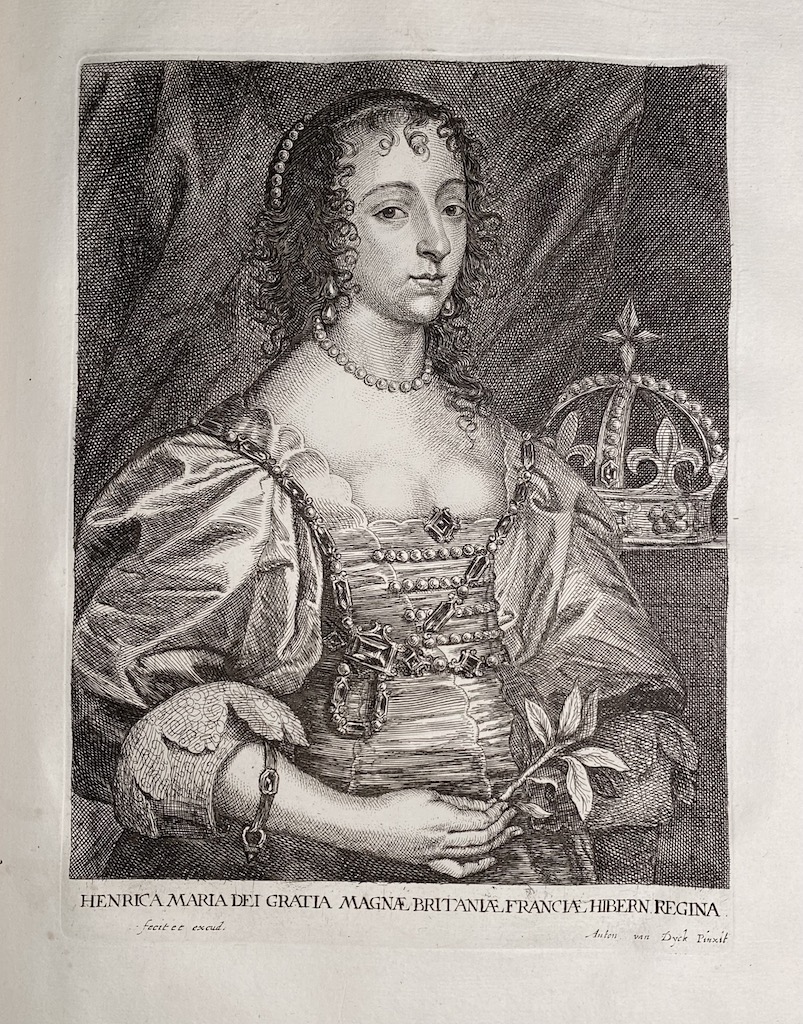
31. Henriette Marie de Bourbon, engraved and published by Ioannes Meyssens. Inscription: “HENRICA MARIA DEI GRATIA MAGNÆ BRITANIÆ FRANCIAÆ HIBERN. REGINA.”. In lower margin: “fecit et excud.” <–> “Anton van Dyck Pinxit”. Third state, finished with a burin; with Meyssens’ name burnished. [Similar to print №62 which has "Ioan. Mey∫ens" signature present]. 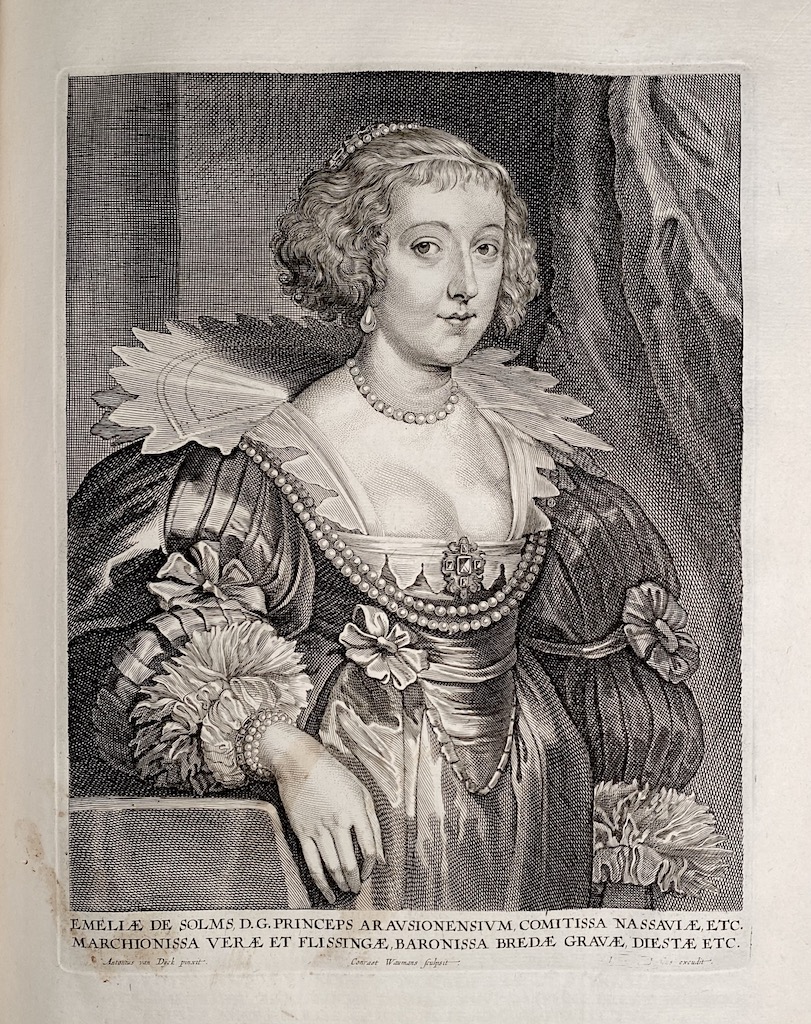
32. Amalia van Solms, Princess of Orange (German, 1602 – 1675), engraved by Conraad Waumans and published by Johannes Meyssens. Inscription: “EMELIÆ DE SOLMS, D. G. PRINCPES ARAVSIONENSIVM, COMITISSA NASSAUVIÆ, ETC. | MARCHIONISSA VERÆ ET FLISSINGÆ, BARONISSA BREDÆ, GRAVÆ, DIESTÆ ETC.”. In lower margin: “Antonius van Dijck pinxit.” <–> “Conraet Waumans sculpsit.” <–> “… excudit”. First, lettered state with the title and production details, with Meyssens’ name burnished. [Similar to №66, which has Ioannes Meysens name present]. 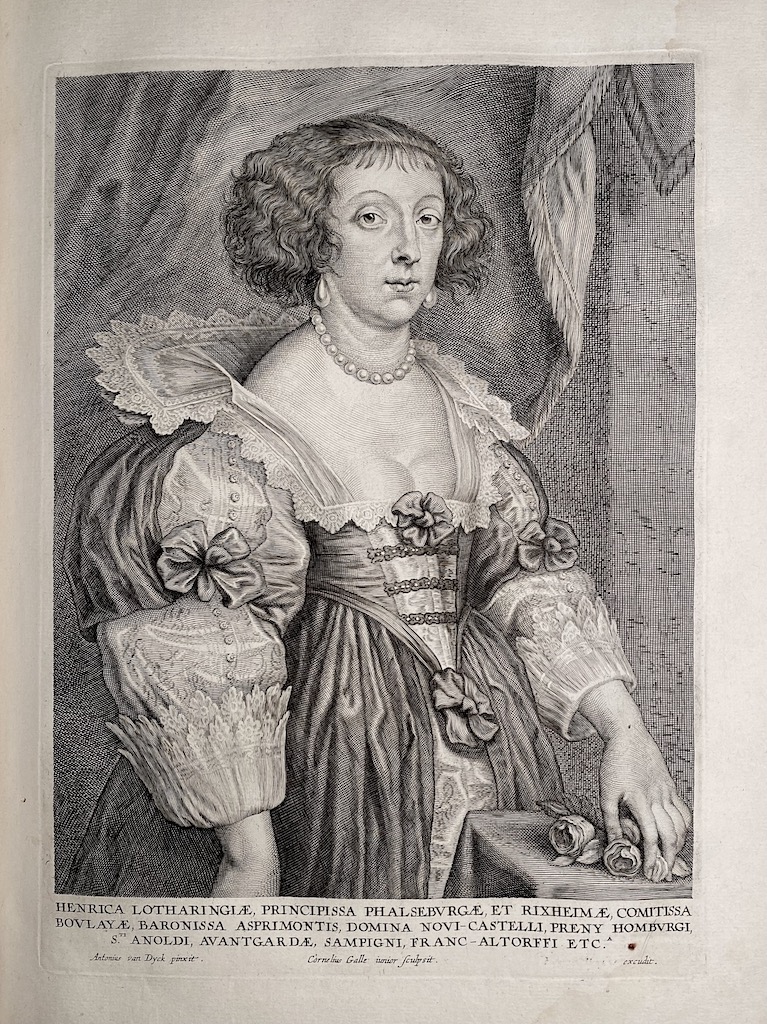
33. Henriette de Lorraine, Princess of Phalsbourg (or Pfalzburg) (French, 1605 – 1660); engraved by Cornelis Galle the Younger, published by Ioannes Meyssens. Inscription: “HENRICA LOTHARINGIÆ, PRINCIPISSA PHALSEBVRGÆ, ET RIXHEIMÆ, COMITISSA | BOVLAYÆ, BARONISSA ASPIRIMONTIS, DOMINA NOVI-CASTELLI, PRENY | HOMBVRGI, S.TI ANOLDI, AVANTGARDÆ, SAMPIGNI, FRANC-ALTORFFI ETC.A”. In lower margin: “Antonius van Dyck pinxit.” <–> “Cornelius Galle iunior sculpsit.” <–> “… excudit.”. First state with the title and production details, with Ioannes Meyssens’ name burnished. British Museum # R,1a.248. 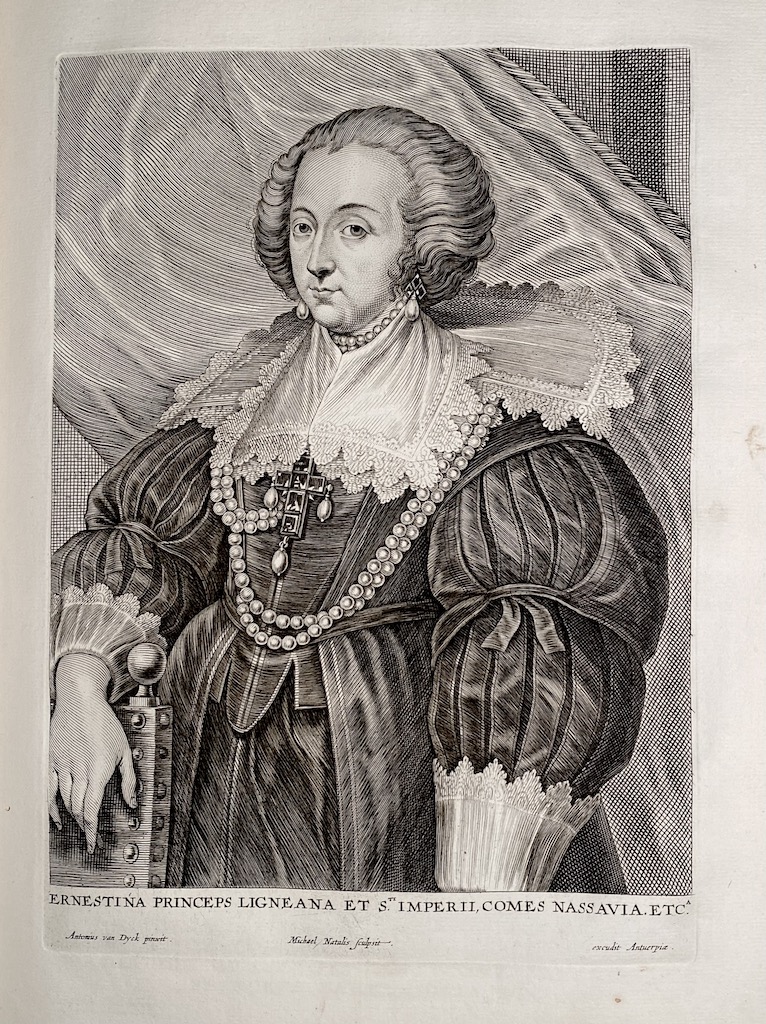
34. Ernestine Yolande de Ligne, Countess of Nassau-Siegen (Flemish, 1594 – 1668); engraved by Michiel Natalis, published by Jan Meyssens. Inscription: “ERNESTINA PRINCEPS LIGNEANA ET S.TI IMPERII, COMES NASSAVI. ETC.A”. In lower margin: “Antonius van Dyck pinxit.” <–> “Michael Natalis sculpsit.” <–> “…excudit Antuerpiæ.”. Second state with the initials of Ioannes Meyssens erased. 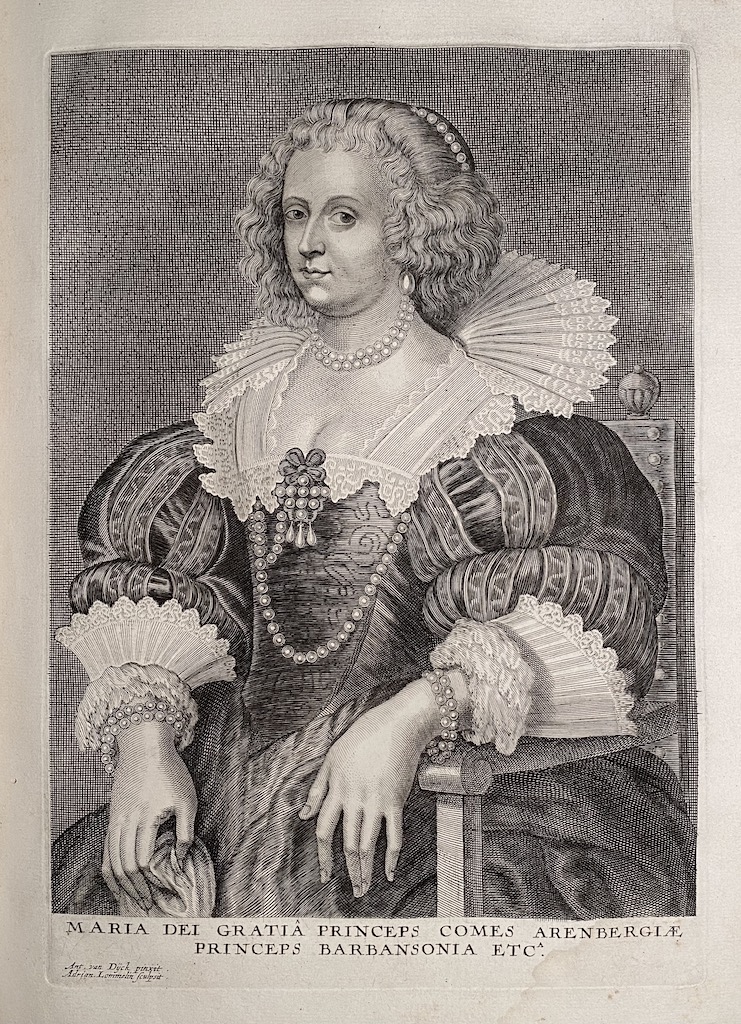
35. Marie de Barbançon, Princess of Arenberg (1602 – 1675); engraved by Adriaen Lommelin. Inscription: “MARIA DEI GRATIÂ PRINCEPS COMES ARENBERGIÆ | PRINCEPS BARBASONIA ETC.A”. In lower margin: “Ant. van Dÿck pinxit. | Adrian. Lommelin sculpsit.”. Second, lettered state with title and production details and adjustments made in the face. British Museum # 1876,1014.181 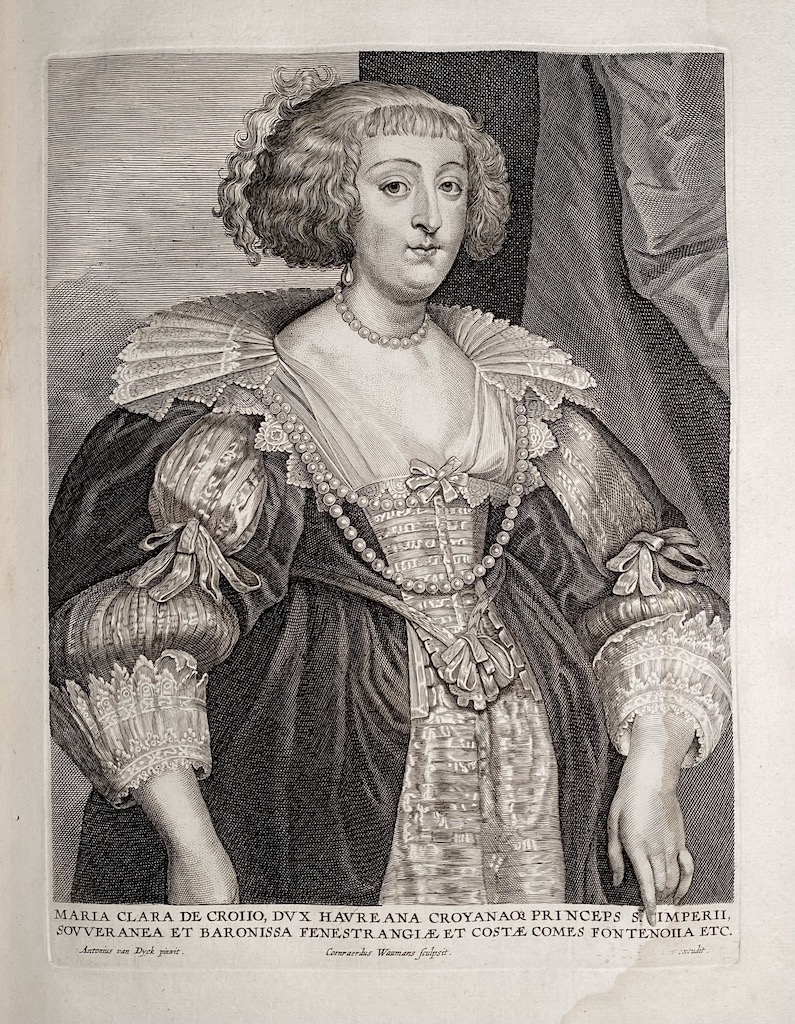
36. Marie-Claire de Croy, Duchess of Havré (Flemish, 1605 – 1664); engraved by Conraad Waumans, published by Ioannes Meyssens. Inscription: “MARIA CLARA DE CROIIO, DVX HAVREANA CROYANAQ3 PRINCEPS STE. IMPERII, | SOVVERANEA ET BARONISSA FENESTRANGIÆ ET COSTÆ COMES FONTENOIIA ETC.”. In lower margin: “Antonius van Dyck pinxit.” <–> “Coenraerdus Waumans sculpsit.” <–> “…excudit.”. Third state with Ioannes Meyssens’ name burnished. British Museum # 1891,1015.21. [Similar to №64, which has Ioannes Meysens’ name present]. 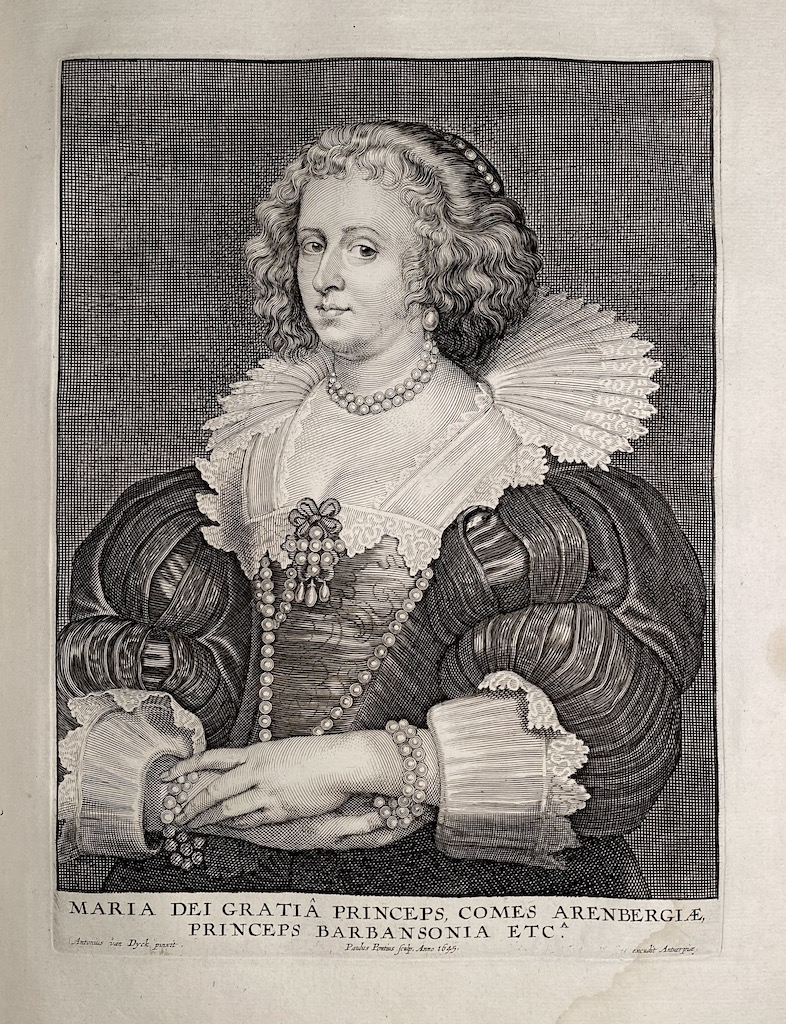
37. Marie de Barbançon, Princess of Arenberg (1602 – 1675); engraved by Paulus Pontius, published by Ioannes Meyssens. Inscription: “MARIA DEI GRATIÂ PRINCEPS COMES ARENBERGIÆ, | PRINCEPS BARBASONIA ETC.A”. In lower margin: “Antonius van Dyck pinxit. | Paulus Pontius sculp. Anno 1645.” <–> “… excudit Antuerpiæ”. Second state with a thick borderline, title and production details added, Ioannes Meyssens’s name burnished. 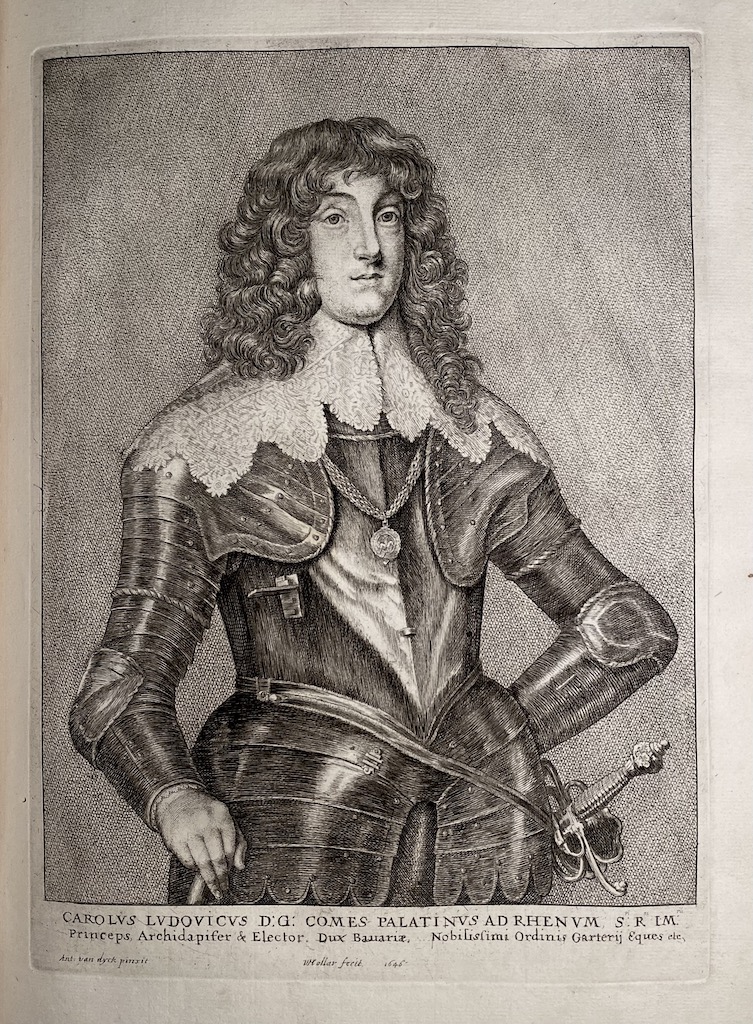
38. Karl I Ludwig, Elector Palatine (German, 1617 – 1680); engraved by Wenceslaus Hollar (Bohemian, 1607 – 1677). Inscription: “CAROLVS LVDOVICVS D:G: COMES PALATINVS AD RHENVM, S:ri R.ni IM:rii | Princeps, Archidapifer & Elector, Dux Bauariæ, …Nobilissimi Ordinis Garterij Eques etc.”. Below: “Ant: van Dyck pinxit” <–> “WHollar fecit,” <–> “1646”. First, lettered state with the title and production details, without “H: van de Borcht excu:”. British Museum # 1867,1012.598. Hendrik van der Borcht II (Dutch, 1614 – c. 1690) 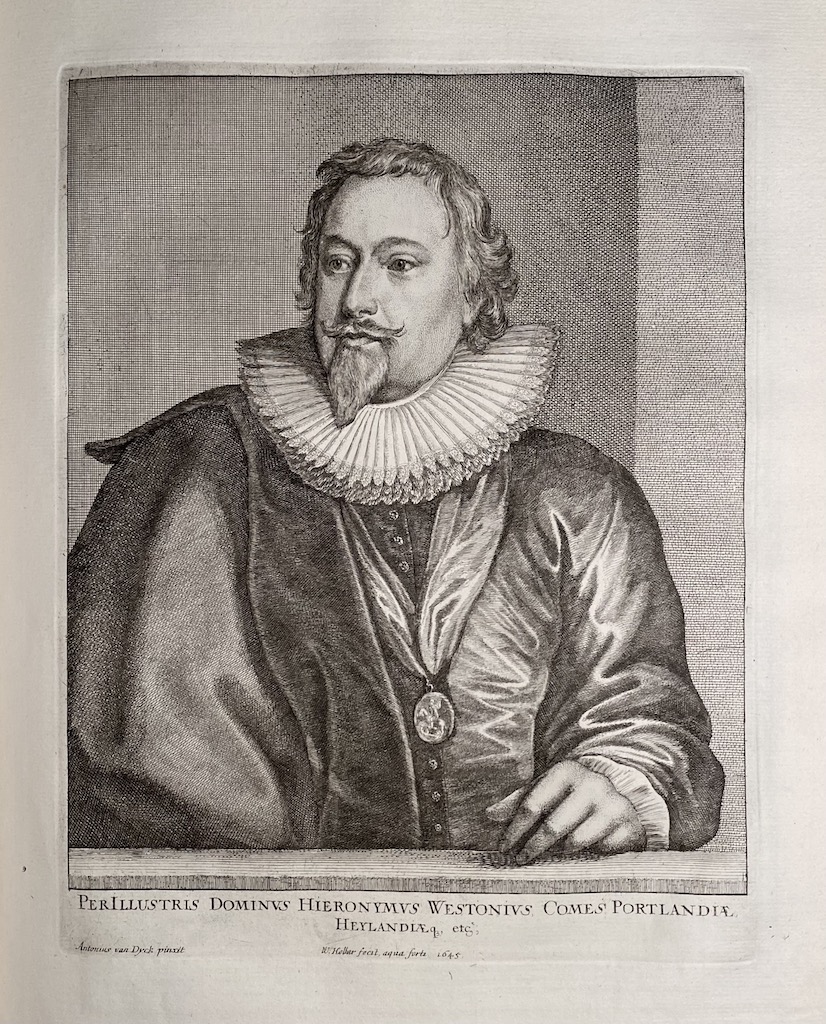
39. Richard Weston, 1st Earl of Portland (British, 1577 – 1635); engraved by Wenceslaus Hollar, published by Ioannes Meyssens. Inscription: “PERILLUSTRIS DOMINVS HIERONYMVS WESTONIVS, COMES PORTLANDIÆ, | HEYLANDÆq3, etc’,”. Below: “Antonius van Dyck pinxit”<–> “W: Hollar fecit, aqua forte. 1645”. Ioannes Meyssens’s name completely burnished. 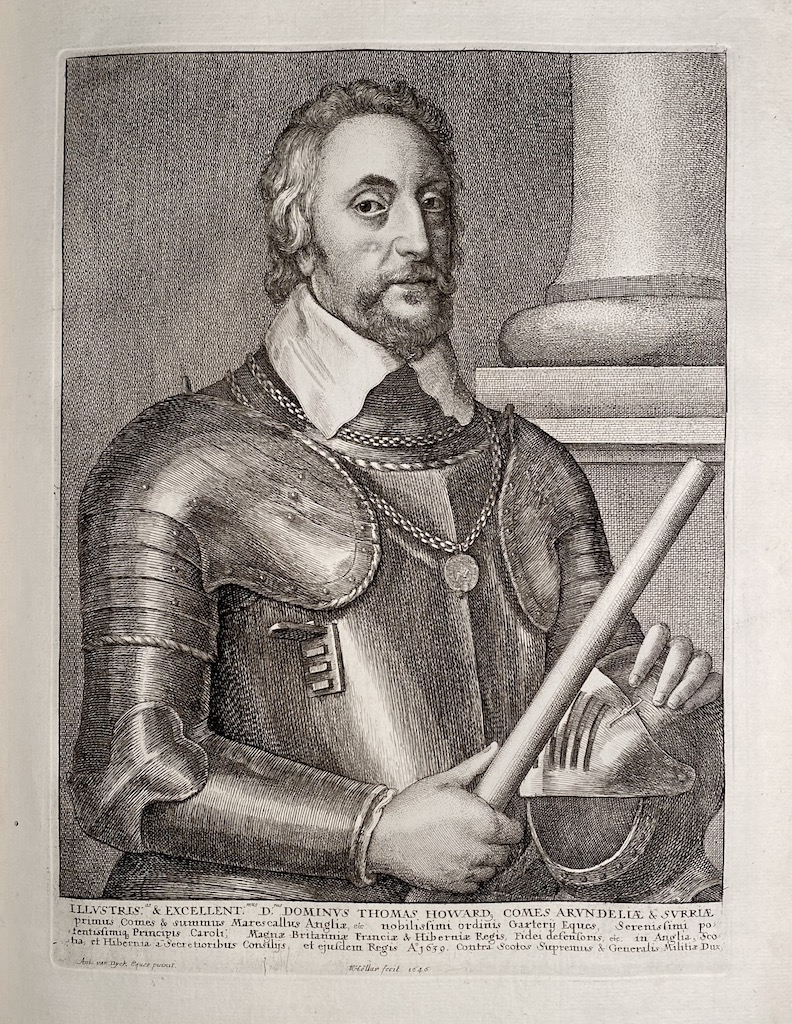
40. Thomas Howard, 14th Earl of Arundel (British, 1585 – 1646); engraved by Wenceslaus Hollar, published by Ioannes Meyssens. Inscription: "ILLVSTRIS:us & EXCELLENT:mus D:nus. DOMINVS THOMAS HOWARD, COMES ARXNDELIÆ & SVRRIÆ | primus Comes & summus Marescallus Angliæ, etc nobilisimi ordiuis Garterÿ Eques, Serenis∫imi po: | tentis∫imq3 Principis Caroli: Magnæ Britanniæ & Hiberniæ Regis, Fidei defen∫oris, etc. in Anglia, Sco | tia et Hibernia a Secretioribus Consilijs, et eju∫dem Regis Ao1639. Contra | Scotos Supremus & Generalis Militiæ Dux,”. In lower margin: “Ant: van Dyck Eques pinxit” <–> “WHollar fecit 1646”. Second state with Ioannes Meyssens’s name completely burnished. 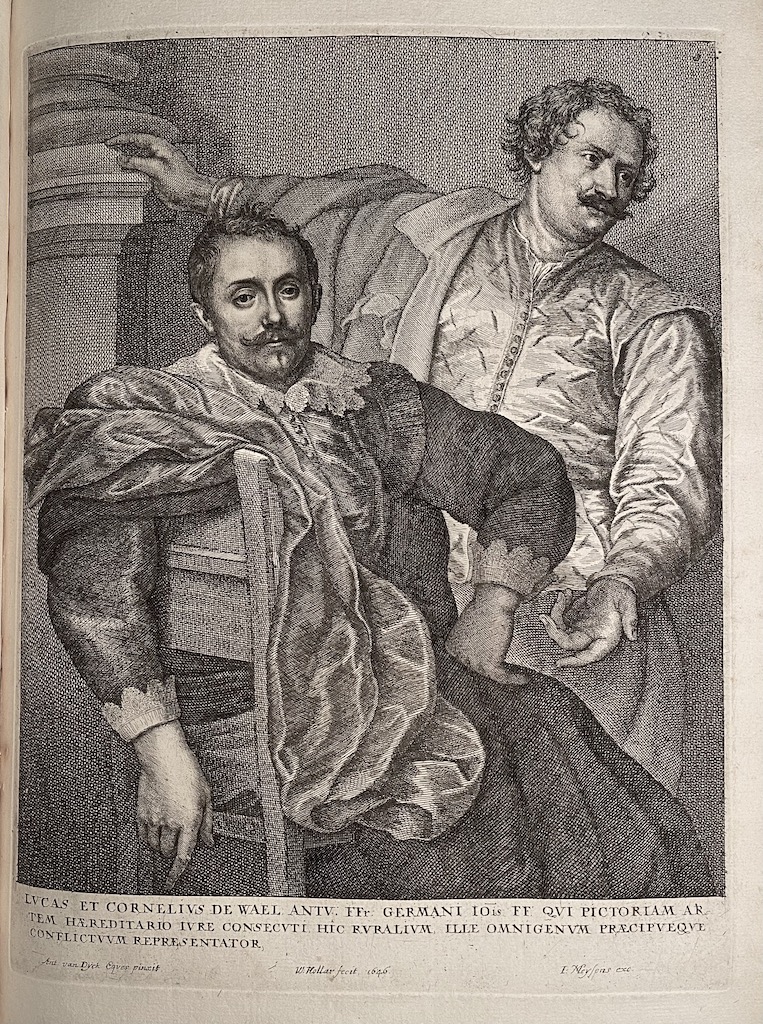
41. Lucas de Wael (Flemish, 1591 – 1661) and Cornelis de Wael (Flemish, 1592 – 1667); engraved by Wenceslaus Hollar, published by Ioannes Meyssens. Inscription: “LVCAS ET CORNELIVS DE WAEL ANTV: FFr. GERMANI IOis QUI PICTORIAM AR | TEM HÆREDITARIO IVRE CONSECVTI HIC RVRALIVM, ILLE OMNIGENVM PRÆCIPVEQVE / CONFLICTVVM REPRÆSENTATOR.”. In lower margin: “Ant. van Dyck Eques pinxit.” <–> “W: Hollar fecit, 1646.” <–> “I: Meysens exc”. First, lettered state with the title and production details. 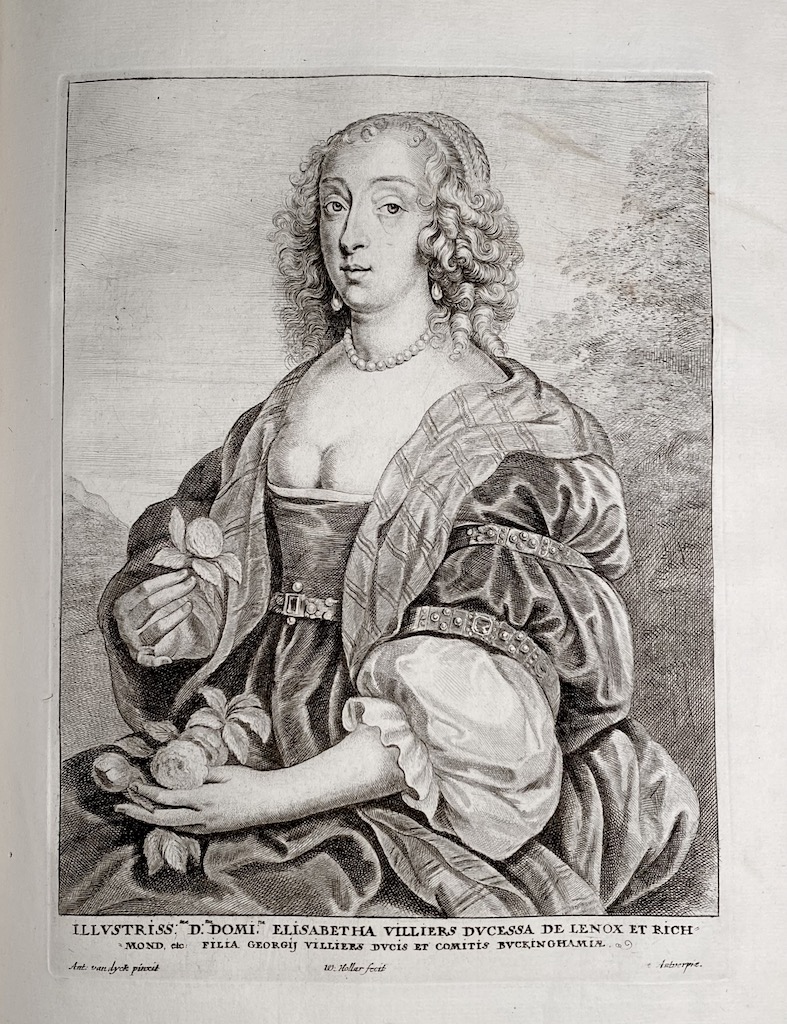
42. Mary (Elisabetha ) Villiers, Duchess of Lennox and Richmond (British, 1622 – 1685); engraved by Wenceslaus Hollar, published by Ioannes Meyssens. Inscription: “ILLUSTRISS: ma D:ma DOMI.na ELISABETHA VILLIERS DVCESSA DE LENOX ET RICH | MOND. etc: FILIA GEORGIJ VILLIERS DVCIS ET COMITIS BVCKINGHAMIÆ.”. In lower margin: “Ant: van dyck pinxit” <–> “W:Hollar fecit” <–> “… Antverpiæ.”. Ioannes Meyssens’ name completely burnished. First state with the title and production details. 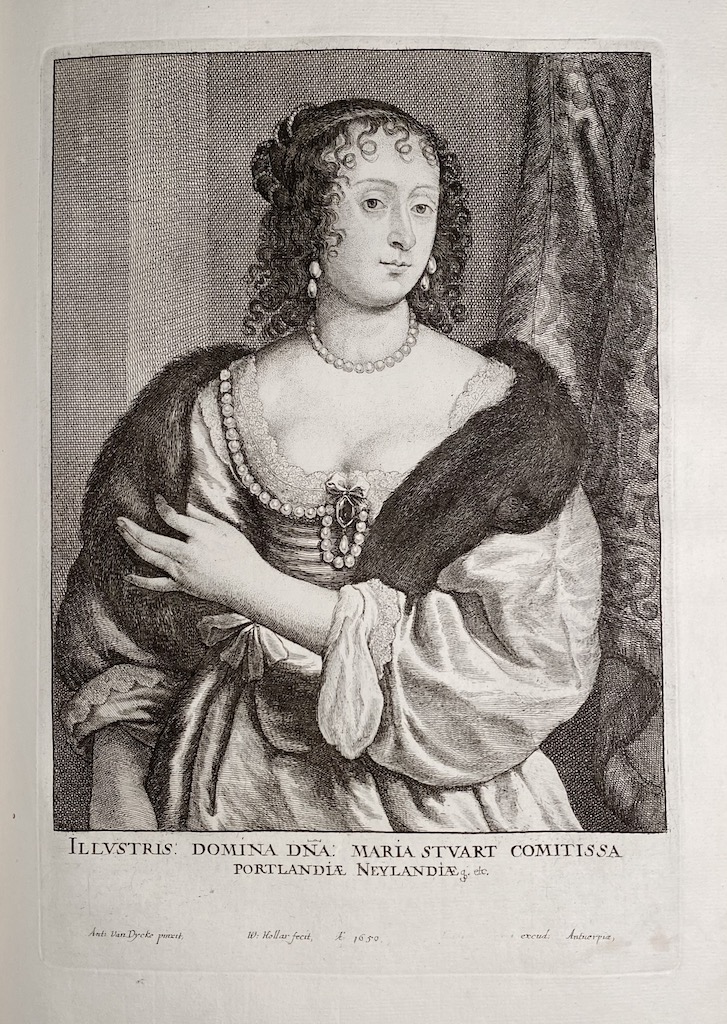
43. Frances (Maria) Stuart, Countess of Portland (British, 1617 – 1694); engraved by Wenceslaus Hollar, published by Ioannes Meyssens. Inscription: “ILLVSTRIS: DOMINA DNA: MARIA STVART COMITISSA | PORTLANDIÆ NEYLANDIÆ, etc.”. Below: “Ant: Van Dycke pinxit,” <–> “W: Hollar fecit, A:o 1650,”, “...excud: Antuerpiæ,”. Second state with Meyssens’ name burnished. British Museum # 1853,0112.1761 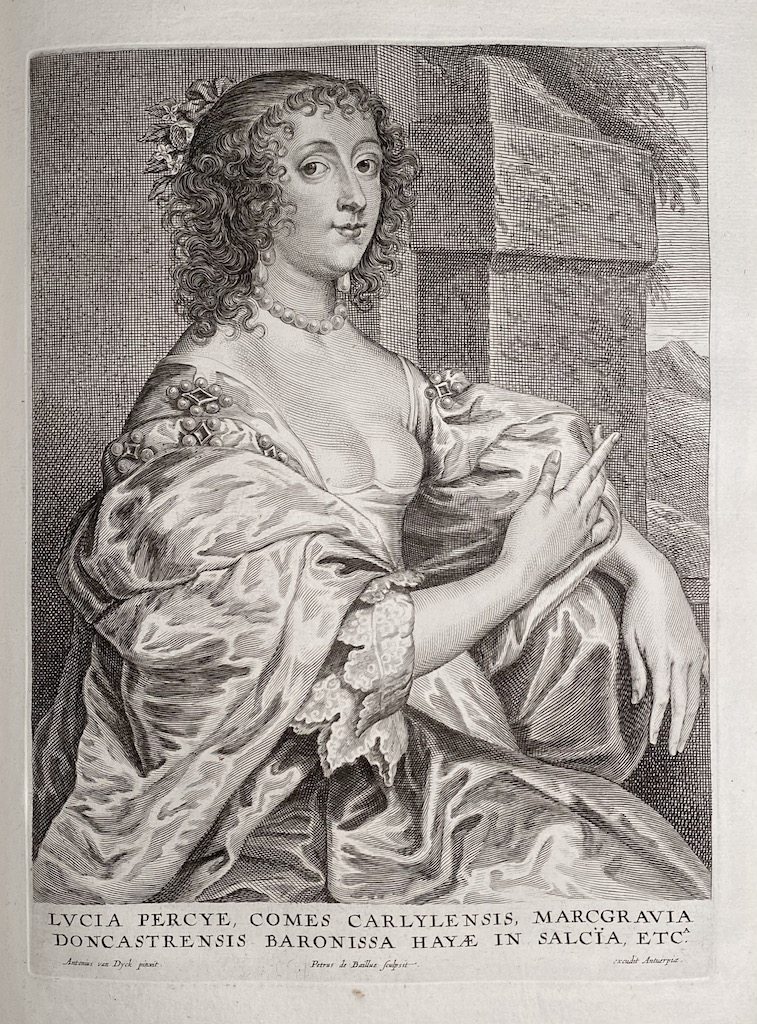
44. Lucy Percy, Countess of Carlisle (British, 1599 – 1660); engraved by Pieter de Bailliu, published by Ioannes Meyssens. Inscription: “LVCIA PERCYE, COMES CARLYLENSIS, MARCGRAVIA | DONCASTRENSIS BARONISSA HAYÆ IN SALCÏA, ETC.A”. In lower margin: “Antonius van Dyck pinxit.” <–> “Petrus de Baillue sculpsit.” <–> “...excudit Antuerpia.”. Third, lettered state with Joannes Meyssens’ name burnished. 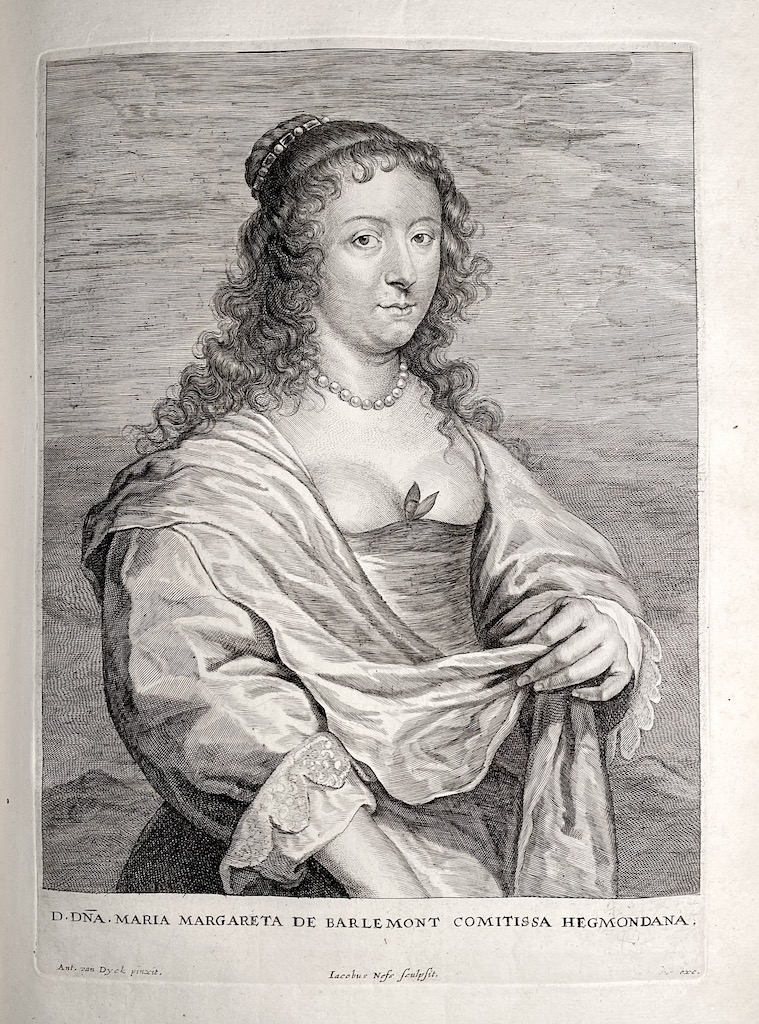
45. Marie-Marguerite de Berlaymont ( ? – 1654); engraved by Jacobus Neeffs, published by Ioannes Meyssens. Inscription: “D.DNA. MARIA MARGARETA DE BARLEMONT COMITISSA HEGMONDANA.” In lower margin: “Ant. van Dyck pinxit.” <–> “Iacobus Nefs sculpsit.”<–> “...exc.”. Fourth state with Ioannes Meyssens’ name erased. British Museum # 1876,1014.206. [Similar to №67, which has Ioannes Meysens name present]. 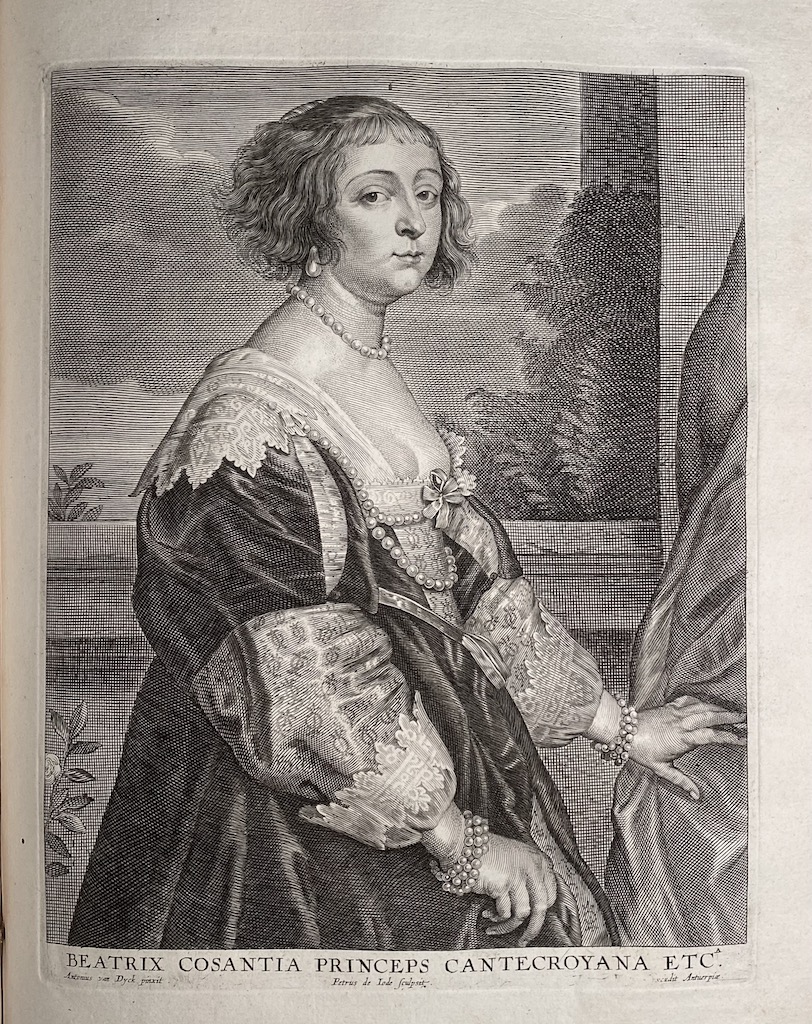
46. Béatrix Constance de Cussance, Princess of Cantecroix (French, 1614 – 1663); engraved by Pieter de Jode II, published by Ioannes Meyssens. Inscription: “BEATRIX COSANTIA PRINCEPS CANTECROYANA ETC.A”. In lower margin: “Antonius van Dyck pinxit” <–>“Petrus de Iode sculpsit.” <–> “… excudit Antuerpiæ.”. Second, lettered state with Meyssens’ name burnished. 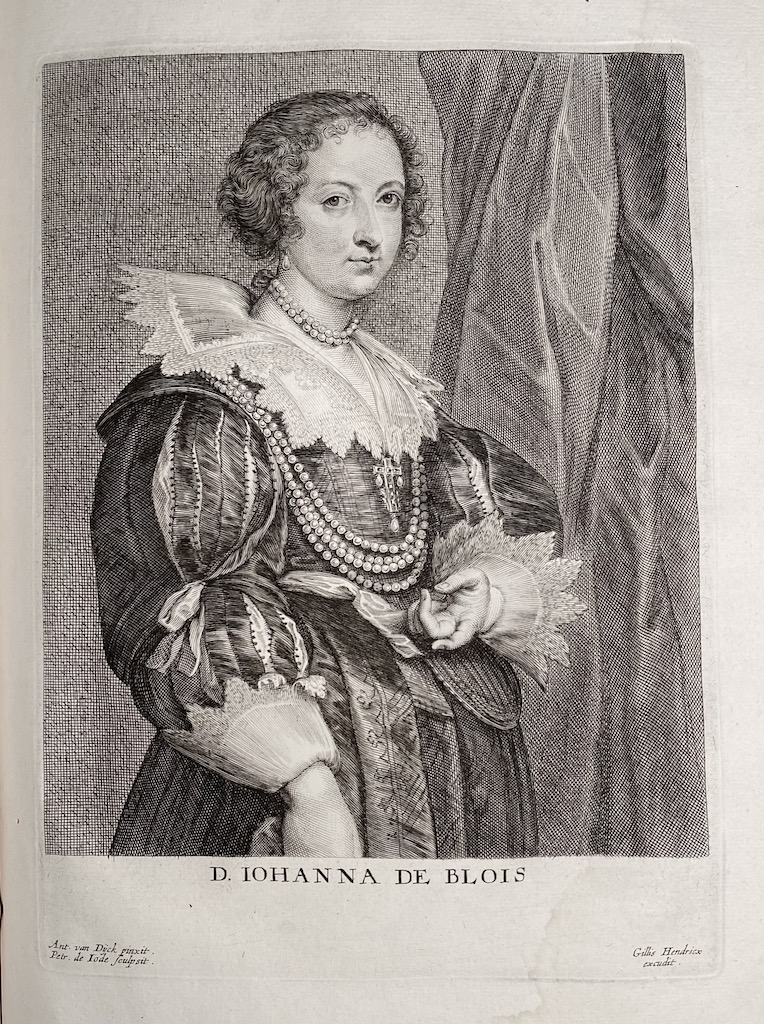
47. Johanna de Blois; engraved by Pieter de Jode II, published by Gillis Hendricx. Inscription: “D. IOHANNA DE BLOIS”. In the lower margin: “Ant. van Dÿck pinxit | Petr. de Iode sculpsit” <–> “Gillis Hendricx | excudit.”. British Museum # 1876,1014.189. 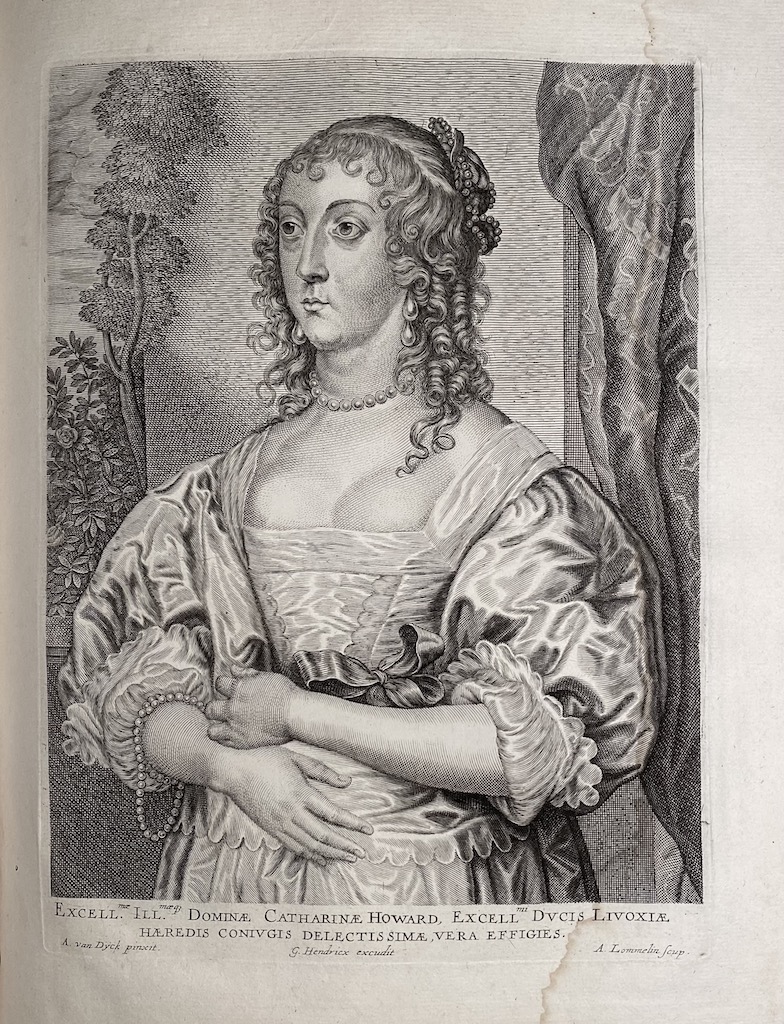
48. Katherine Howard, Countess of Newburgh, Lady d’Aubigny (British, ? – 1650); engraved by Adriaen Lommelin, published by Gillis Hendricx. Inscription: “EXCELLmæ ILL.mæq3 DOMINÆ CATHARINÆ HOWARD, EXCELLmi DUCIS LIVOXIÆ | HÆREDIS CONIUGIS DELECTISSIMÆ, VERA EFFIGIES.” In lower margin: “A. van Dÿck pinxit.” <–> “G. Hendricx excudit” <–> “A. Lommelin scup.”. British Museum # P,3.326 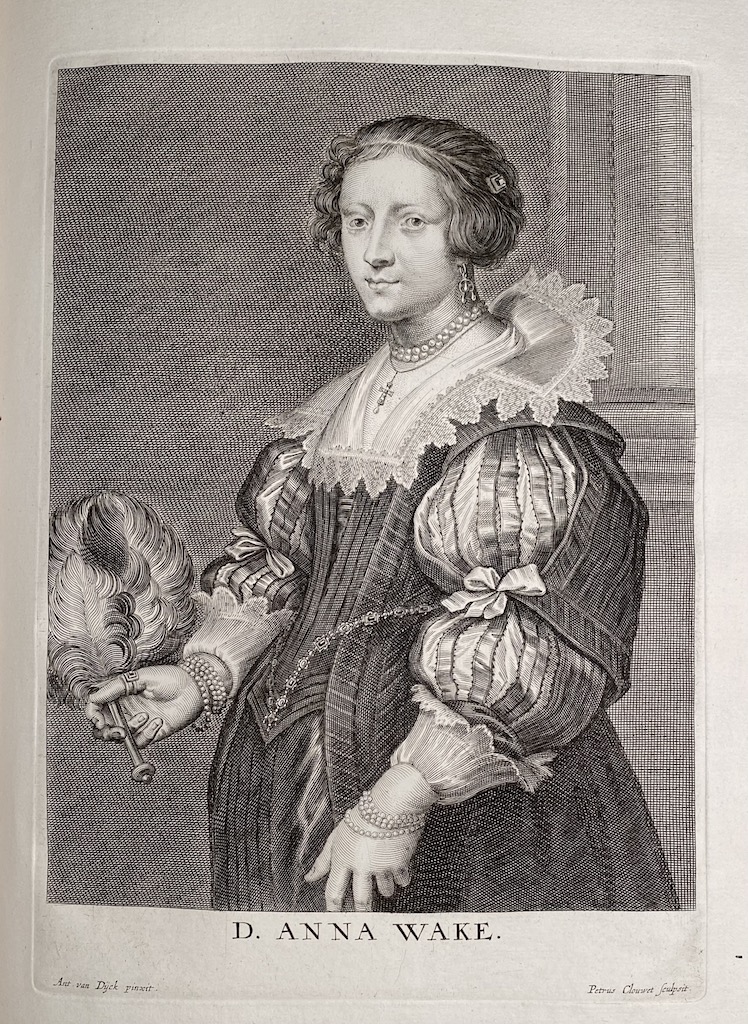
49. Anna Wake (Flemish, 1606 – 1680); engraved by Pieter Clouwet. Inscription: “D. ANNA WAKE.”. In lower margin: “Ant. van Dÿck pinxit.” <–> “Petrus Clouwet sculpsit”. 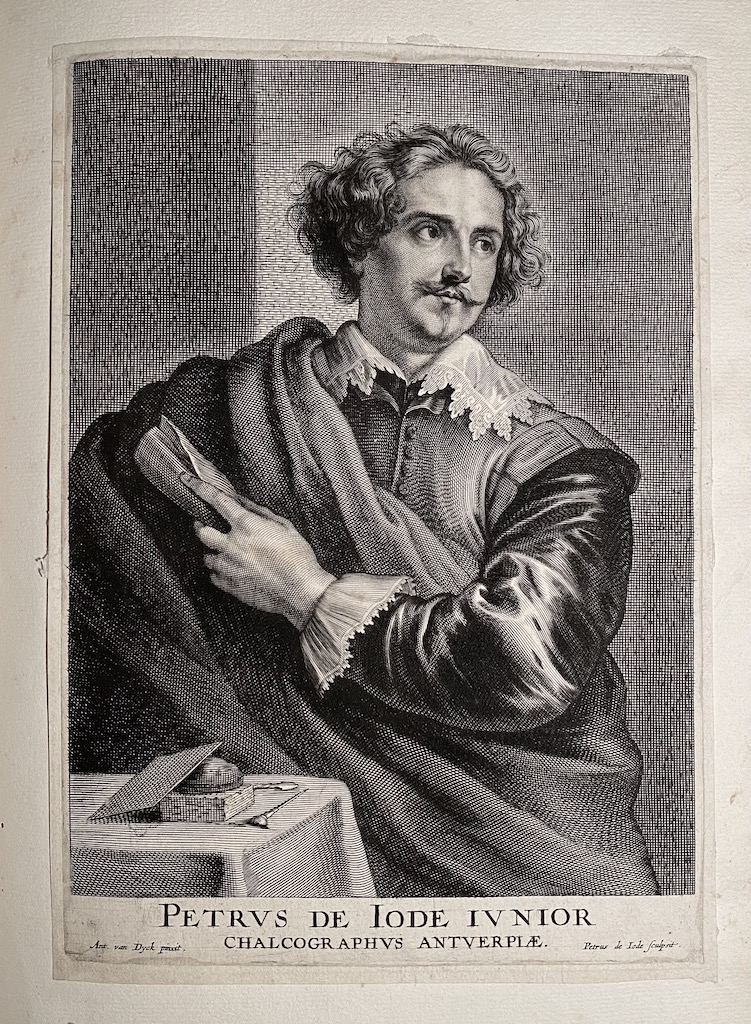
50. Pieter de Jode II (Flemish, 1606-1670/74); engraved by Pieter de Jode II. Inscription: “PETRVS DE IODE IVNIOR / CHALCOGRAPHVS ANTVERPIÆ.”. In lower margin: “Ant. van Dyck pinxit.”<–> “Petrus de Iode sculpsit.”. Third state (before the initials G.H. (of Gillis Hendricx) added. The print with cut off margins pasted to the bound-in leaf. 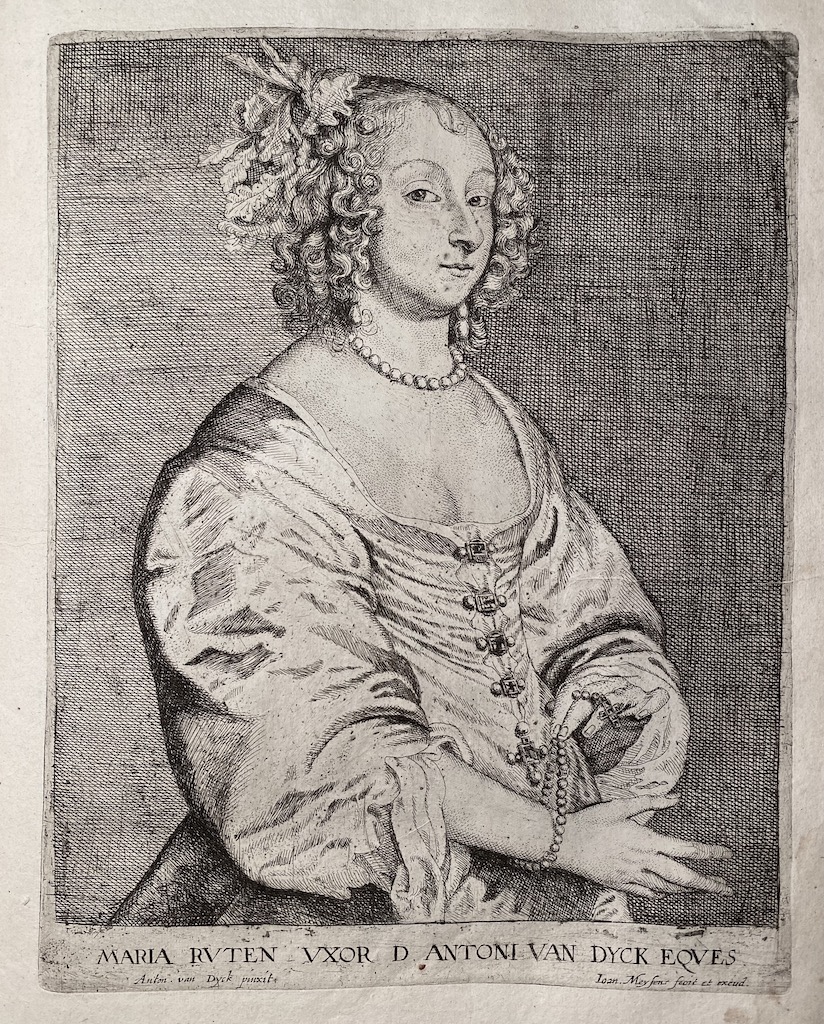
51. Mary Ruthven, Lady van Dyck (Scottish, c. 1622 – 1645); engraved and published by Ioannes Meyssens. Inscription: “MARIA RVTEN VXOR D. ANTONI VAN DYCK EQVES”. In lower margin: “Anton.van Dyck pinxit” <–> “Ioan. Meysens fecit et excud.”. First, lettered state with the title and production details. Tired plate. British Museum # 1863,0725.747. Van Dyck's wife. 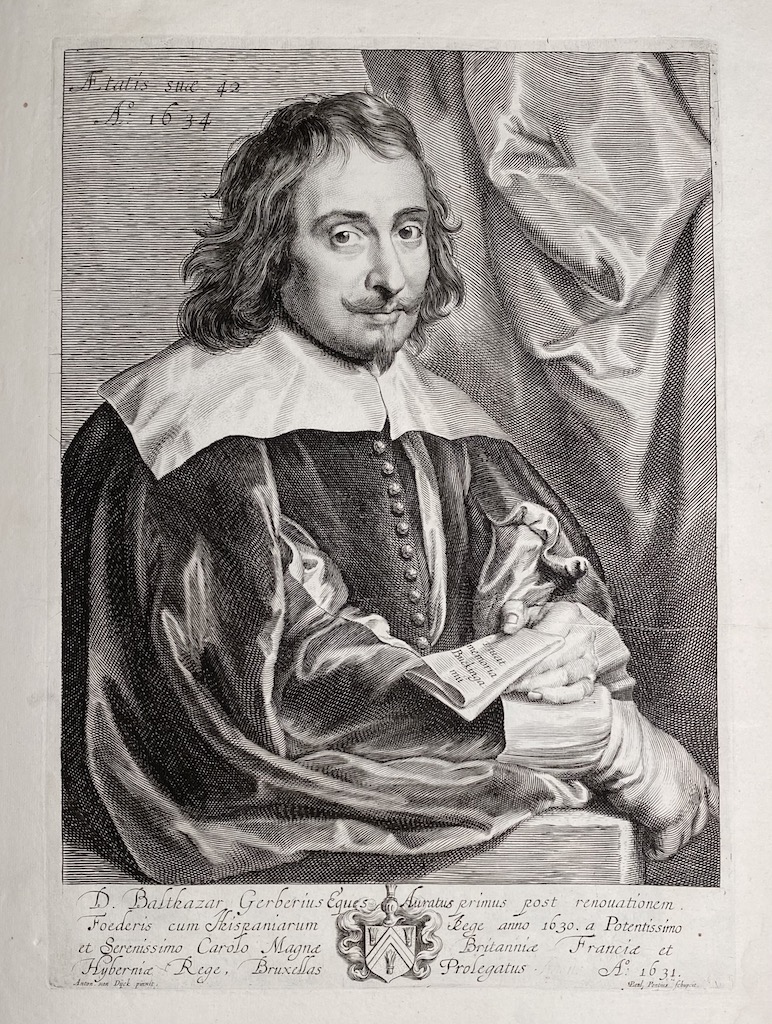
52. Sir Balthazar Gerbier (British, Flemish, 1592 – 1663); engraved by Paulus Pontius. Inscription: “D. Balthazar Gerberius Eques Auratus primus post renouationem. | Foederis cum Hispaniarum Rege anno 1630. A Potentissimo | et Serenissimo Carolo Magnæ Britanniæ Franciæ et Hiberniæ. Rege, Bruxellas Prolegatus. A:o 1631”. Below “Anton van Dyck pinxit”<–> “Paul Pontius schupcit.”. Top left corner: “Ætatis suæ 42 | A.o 1634”. The paper in Gerbier’s hand is lettered “viuat | memoria | Buckinga: | mii”. 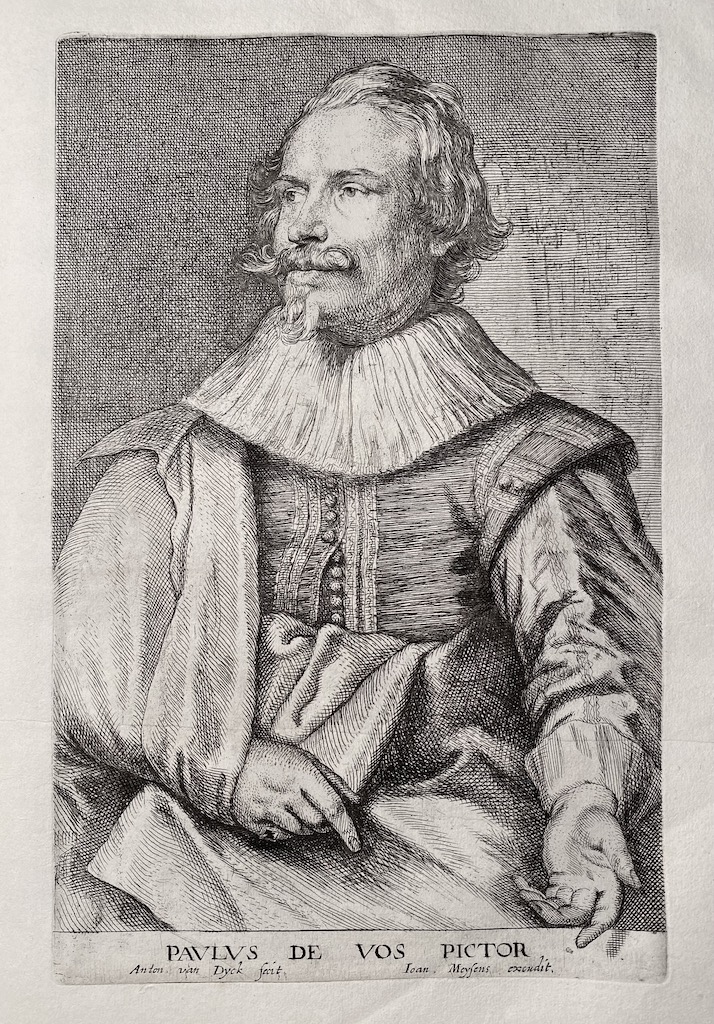
53. Paul de Vos (Flemish, 1596 – 1678); printed by Ioannes Meyssens, face and collar engraved by Anthony van Dyck, the body engraved by Ioannes Meyssens. Second, lettered state. Inscription: PAVLVS DE VOS PICTOR”. In lower margin: “Anton. van Dyck pinxit fecit.”, and “Ioan. Meysens excudit.”. British Museum # R,1b.95. [Look s very much alike №68, but with a one-line inscription and engraved by Meyssens instead of Bolswert]. 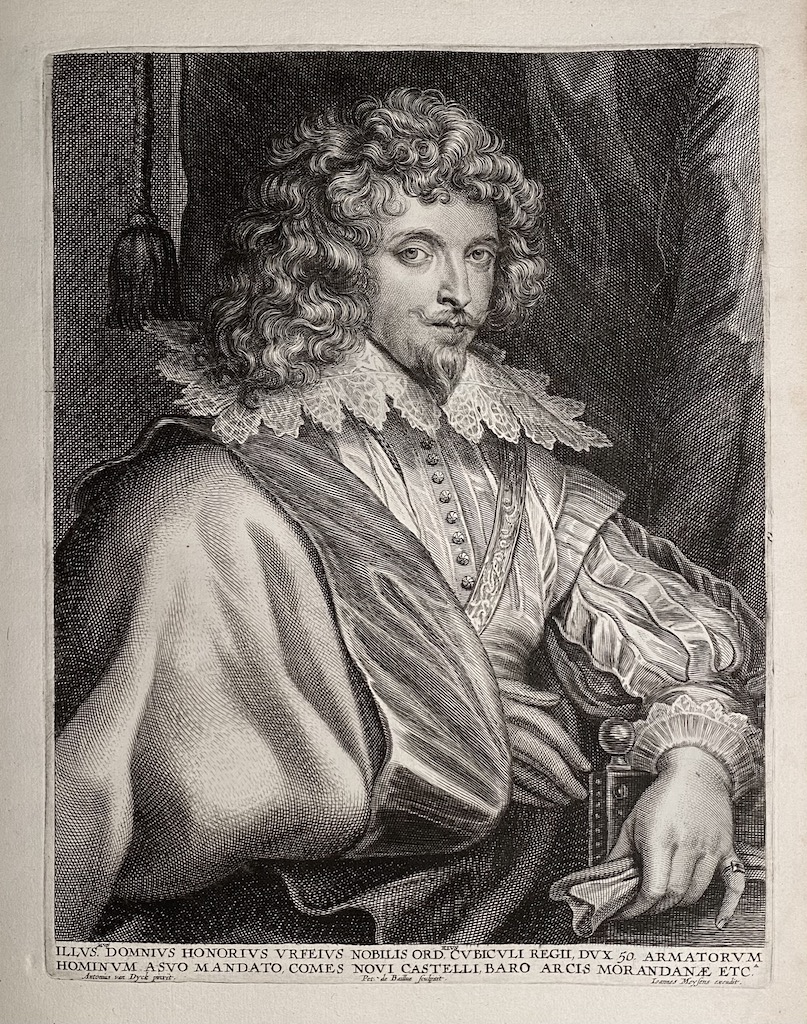
54. Honoré d’Urfé, marquis de Valromey, comte de Châteauneuf (French, 1568 – 1625); engraved by Pieter de Bailliu (Flemish, 1613 – 1660). Inscription: “ILLVS.MVS DOMNIVS HONORIVS VRFEIVS NOBILIS ORD.RIVS CVBICVLI REGII, DVX 50. ARMATORVM | HOMINVM A SVO MANDATO, COMES NOVI CASTELLI, BARO ARCIS MORANDANÆ ETC.A”. Below: “Antonius van Dyck pinxit” <–> “Pet. de Bailliue sculpsit.” <–> “Ioanes Meysens excudit.”. Second lettered state with title and production details. [Similar to №14, but with Ioanes Meysens name in place]. 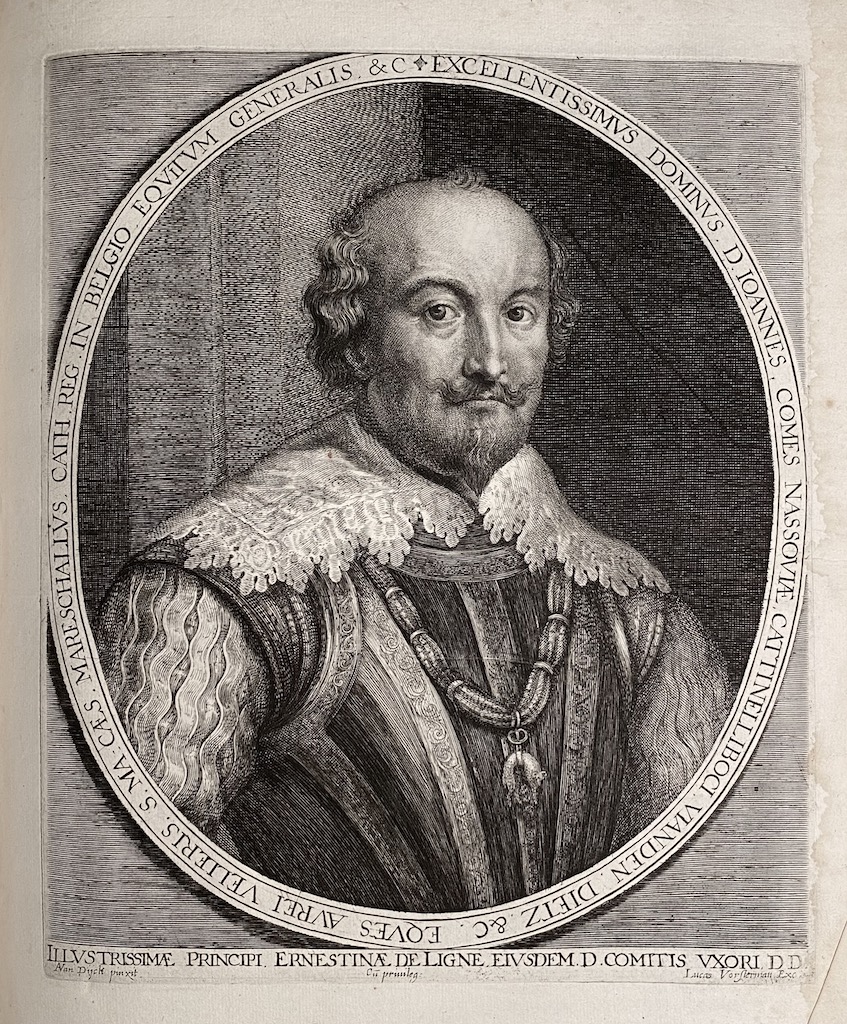
55. Johannes [John VIII], Count of Nassau-Siegen (German, 1583 – 1638); engraved by Lucas Vorsterman I (Flemish, 1595 – 1675). Inscription: in the oval around the portrait “EXCELLENTISSIMVS DOMINVS: D. IOANNES, COMES NASSAOVIÆ, CATTNELLIBOCI: VIANDEN, DIETZ, &C. EQVES AVREI VELLERIS. S. MA: CÆS, MARESCHALIVS, CATH. REG. IN BELGIO. EQVITVM GENERALIS. &C”, in lower margin: “ILLVSTRISSIMÆ PRINCIPI ERNESTINÆ DE LIGNE EIVSDEM D. COMITIS VXORI DD.”. Below: “AVan Dÿck pinxit.” <–> “Cū Priuleg” <–> “Lucas Vorsterman exc”. Third state. [For the fourth state with Lucas “Vorsterman exc” burnished see № 15]. 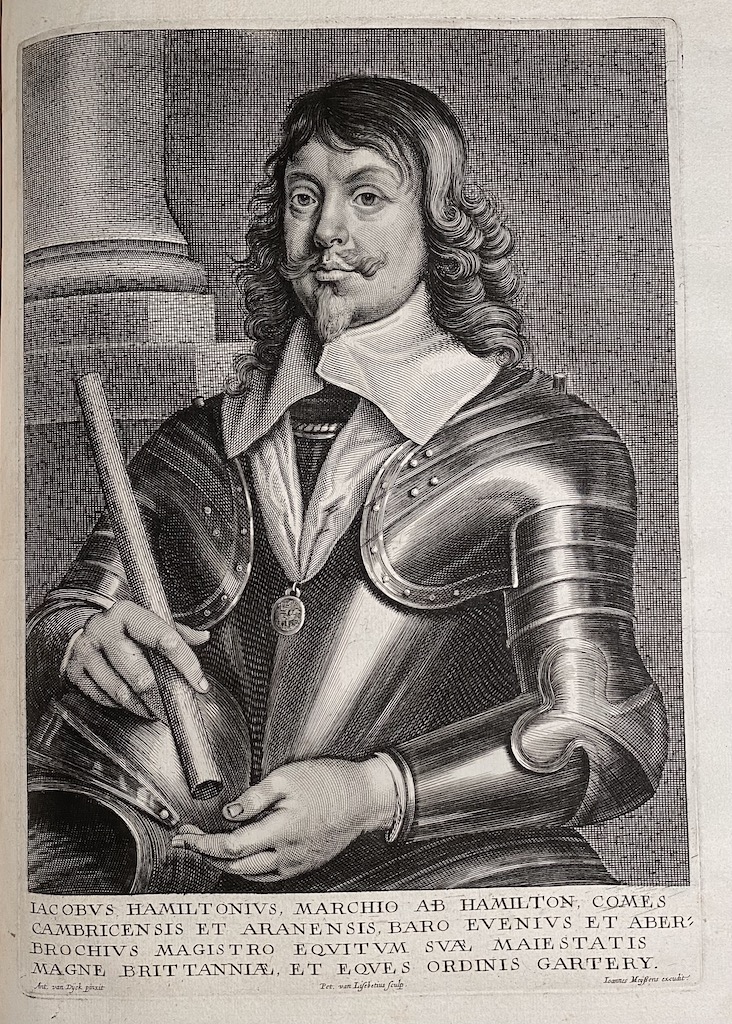
56. James Hamilton, 1st Duke of Hamilton (British, 1606 – 1649); engraved by Peeter van Lisebetten (Flemish,(1630 – 1678), published by Ioannes Meysens. Inscription: “IACOBVS HAMILTONIVS, MARCHIO AB HAMILTON, COMES | CAMBRICENSIS ET ARANENSIS, BARO EVENIVS ET ABER: | BROCHIVS MAGISTRO EQVITVM SVÆ MAIESTATIS | MAGNE BRITTANIÆ, ET EQUES ORDINIS GARTERY.”.In lower margin: “Ant. van Dÿck pinxit” <–> “Pet. van Lisebetius sculp.”<–> “Ioannes Meÿssens excudit.”. Second state with title and signatures. British Museum # P,2.208. 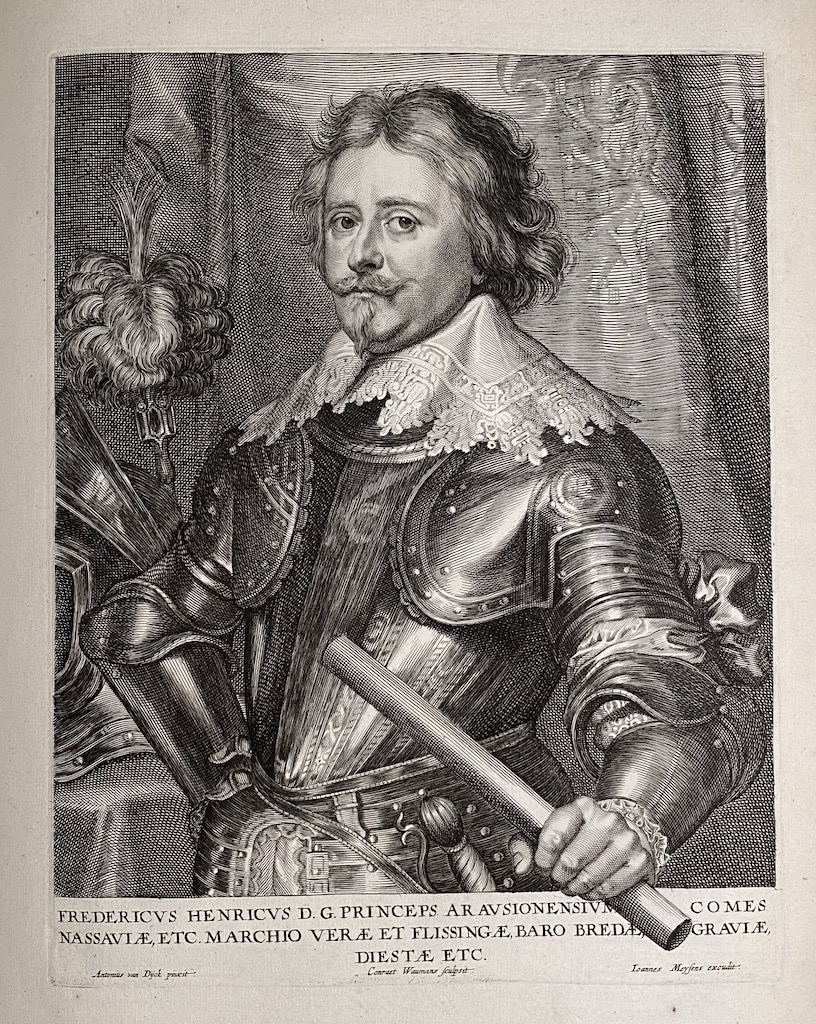
57. Frederick Henry, Prince of Orange, Count of Nassau (Dutch, 1584 – 1647); engraved by Conrad Waumans [Woumans] (Flemish, 1619 – after 1675). Inscription: “FREDERICVS HENRICVS, D.G. PRINCEPS ARAVSIONENSIVM, COMES | NASSAVIÆ, ETC. | MARCHIO VERÆ ET FLISSINGÆ, BARO BREDÆ GRAVÆ, | DIESTÆ ETC.”. Below: “Antonius van Dÿck pinxit” <–> “Conraet Waumans sculpsit” <–> “Ioannes Meyssens excudit.” First, lettered state with title and production details. [Similar to №5, but this one with Ioannes Meyssens name present]. 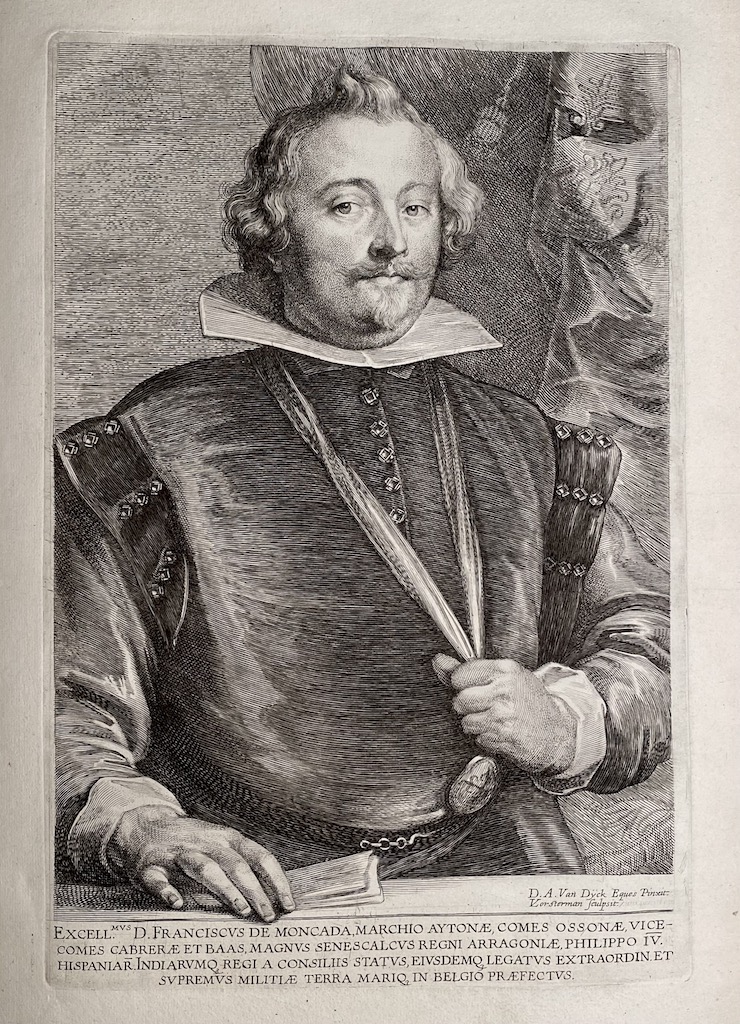
58. Francisco de Moncada, Count d’Osuna (Spanish, 1568 – 1635); engraved by Lucas Vorsterman I. Inscription: “EXCELL.MVS D. FRANCISCVS DE MONCADA MARCHIO AYTONÆ, COMES OSSONÆ VICE– | COMES CABRERÆ ET BAAS, MAGNVS SENESCALCVS REGNI ARRAGONIÆ, PHILIPPO IV. | HISPANIAR.INDIARVMQ3 REGI A CONSILIIS STATVS, EIVSDEMQ3 LEGATVS EXTRAORDIN,ET | SVPREMVS MILITIÆ TERRA MARIQ3 IN BELGIO PRÆFECTVS". Above within portrait frame, to the right: “D.A.van Dÿck pinxit. | LVorsterman sculpsit.”. 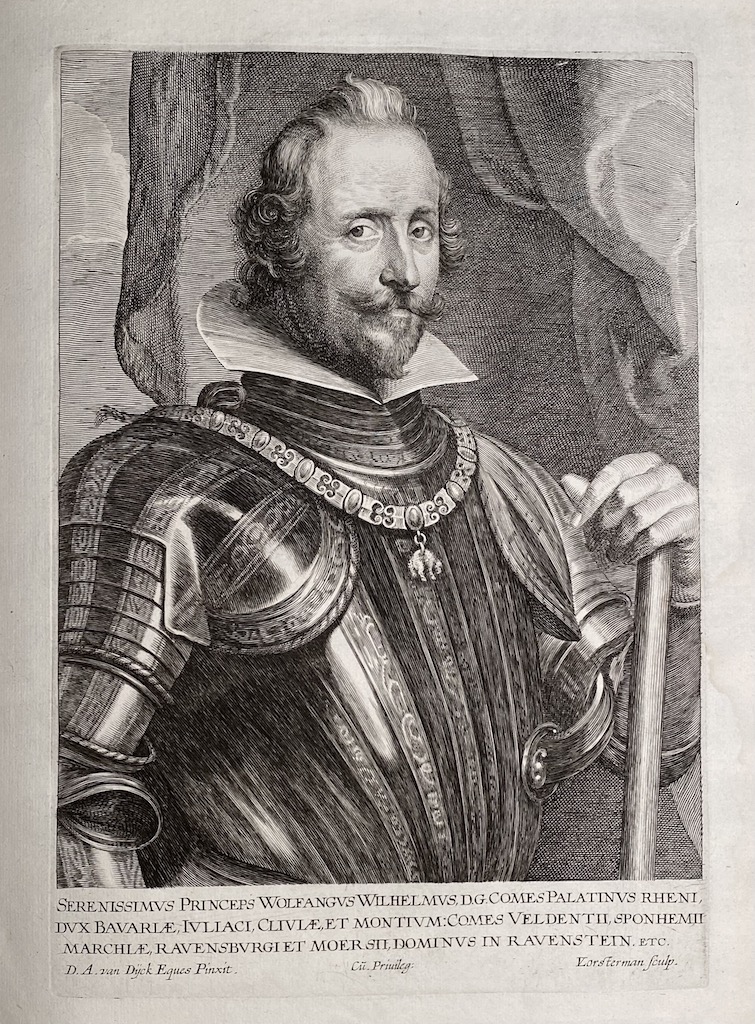
59. Wolfgang Wilhelm, Count of Pfalz-Neuburg and Duke of Jülich (German, 1578 – 1653); engraved by Lucas Vorsterman I. Inscription: "SERENISSIMVS PRINCEPS WOLFGANGVS WILHELMVS, D.G. COMES PALATINVS RHENI, | DVX BAVARIÆ, IVLIACÆ, ET MONTIVM :COMES VELDENTII, SPONHEMII | MARCHIÆ, RAVENSBVRGI ET MOERSII, DOMINVS IN RAVENSTEIN. ETC." In lower margin: "D. A. van Dÿck Eques Pinxit." <–> "Cū. Priuileg:" <–> "LVorsterman sculp.". Fifth state with initials of Gillis Hendricx burnished. British Museum # 1863,0509.825. 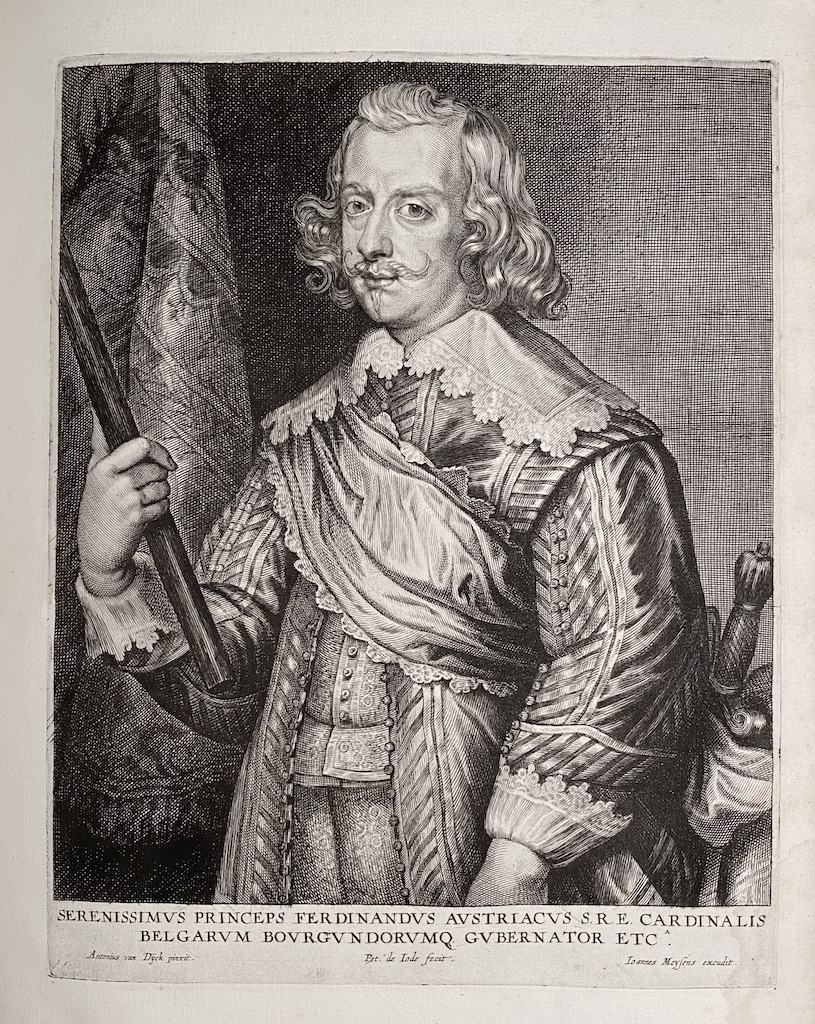
60. Ferdinand, Cardinal Infante of Spain and Archduke of Austria (Spanish, 1609 – 1641); engraved by Pieter de Jode II, published by Ioannes Meyssens. Inscription: “SERENISSIMVS PRINCEPS FERDINANDVS AVSTRIACVS S.R.E CARDINALIS | BELGARVM BORGVNDIORVMQ3 GVBERNATOR ETC.A”. In lower margin: “Antonius van Dÿck pinxit” <–> “Pet. de Iode fecit” <–> “Ioannes Meysens excudit”. Third, lettered state with title and production details. British Museum # R,1a.28. 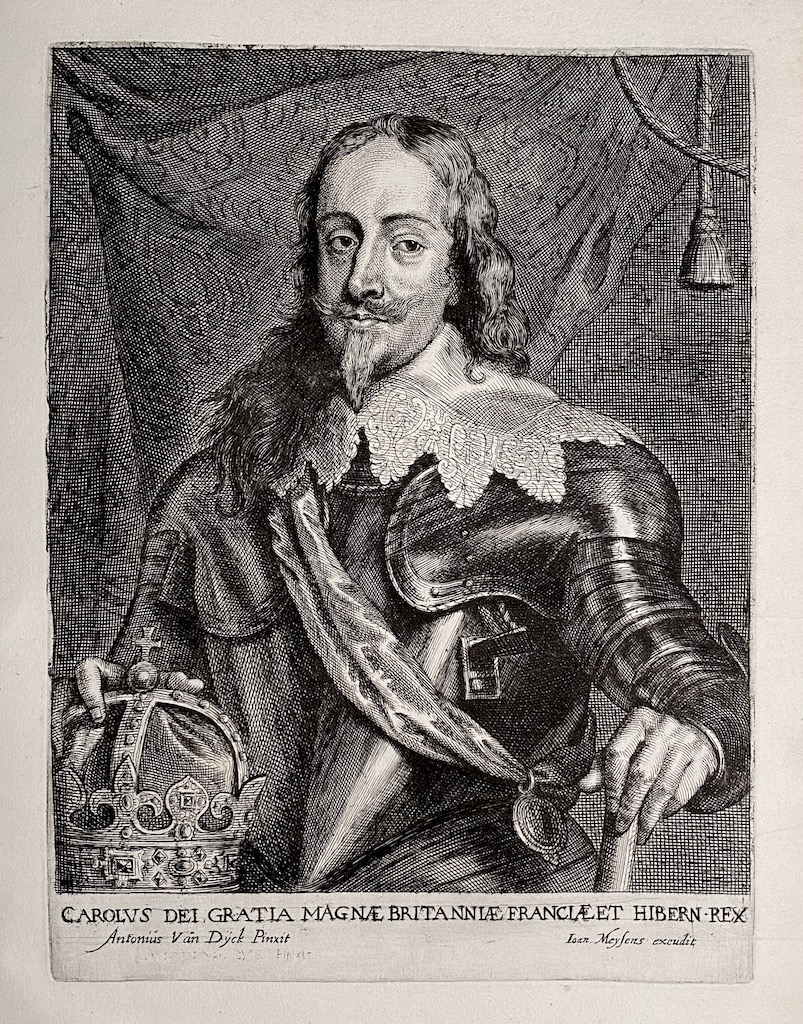
61. Charles I, King of England, Scotland, and Ireland (British, 1600 – 1649); engraved by Johannes [Jan] Meyssens (Flemish, 1612 – 1670). Inscription: “CAROLVS DEI GRATIA MAGNÆ BRITANNIÆ, FRANCIÆ ET HIBERNIÆ REX”. Below: “Antonius Van Dÿck eques pinxit” <–> “Ioan. Meysens excudit”. [Similar to №4, but with Ioannes Meysens name present]. 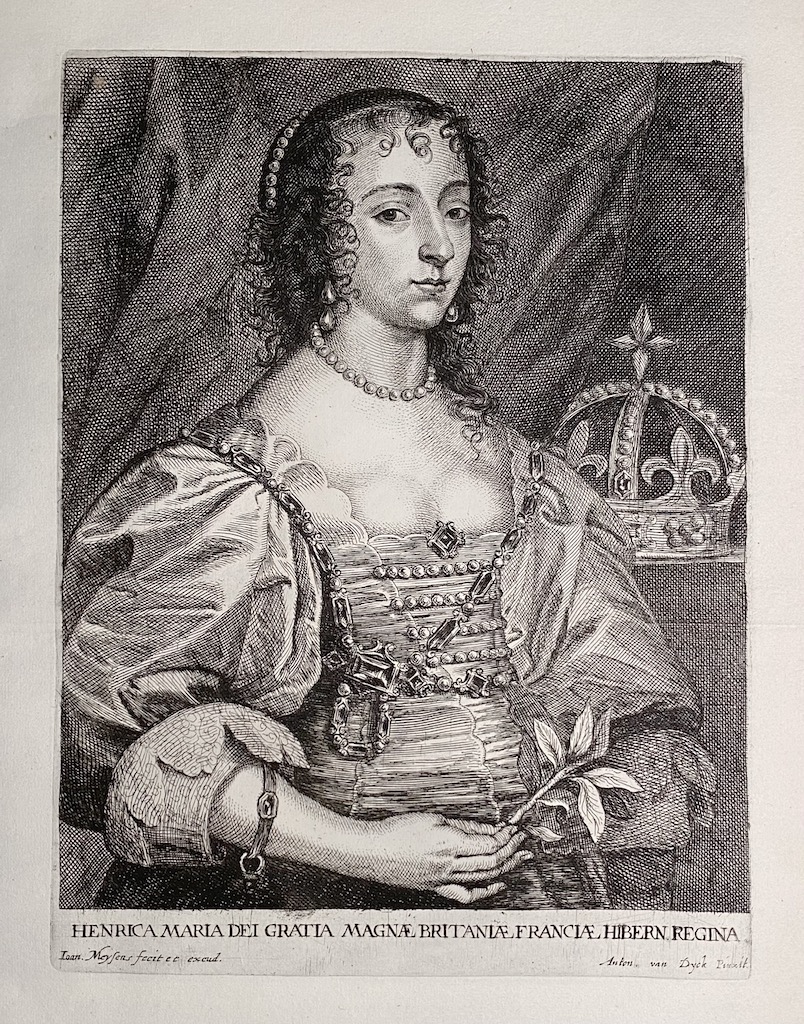
62. Henriette Marie de Bourbon, engraved and published by Ioannes Meyssens. Inscription: “HENRICA MARIA DEI GRATIA MAGNÆ BRITANIÆ FRANCIAÆ HIBERN. REGINA.” Lettered with production details in lower margin: “Ioan. Meysens fecit et excud.” <–> “Anton van Dyck Pinxit”. Third state, finished with a burin. [Similar to print №31, but this one with Ioan. Mey∫ens signature present]. 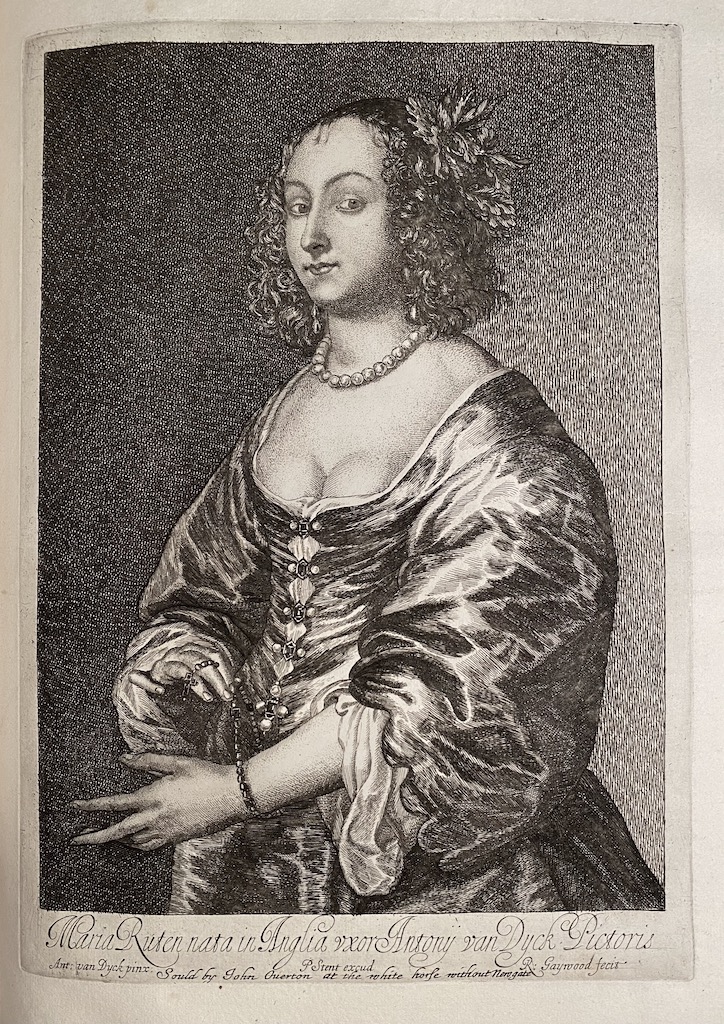
63. Mary Ruthven, Lady van Dyck (Scottish, c. 1622 – 1645); copy in reverse by Richard Gaywood after Bolswert (see also №51 by Meyssens) published by Peter Stent. Inscription: “Maria Ruten nata in Anglia vxor Antonÿ van Dyck Pictoris”. Below: “Ant: van Dyck pinx:”, “P Stent excud”, “R: Gaywood fecit”. Below centre: “Sould by John Ouerton at the white horse without New gate”. John Overton, publisher (British, 1639/40 – 1713); Richard Gaywood (British, fl. c. 1644 – 1677). Peter Stent (British, fl. c. 1637 – 1665). See BM # P,3.351. 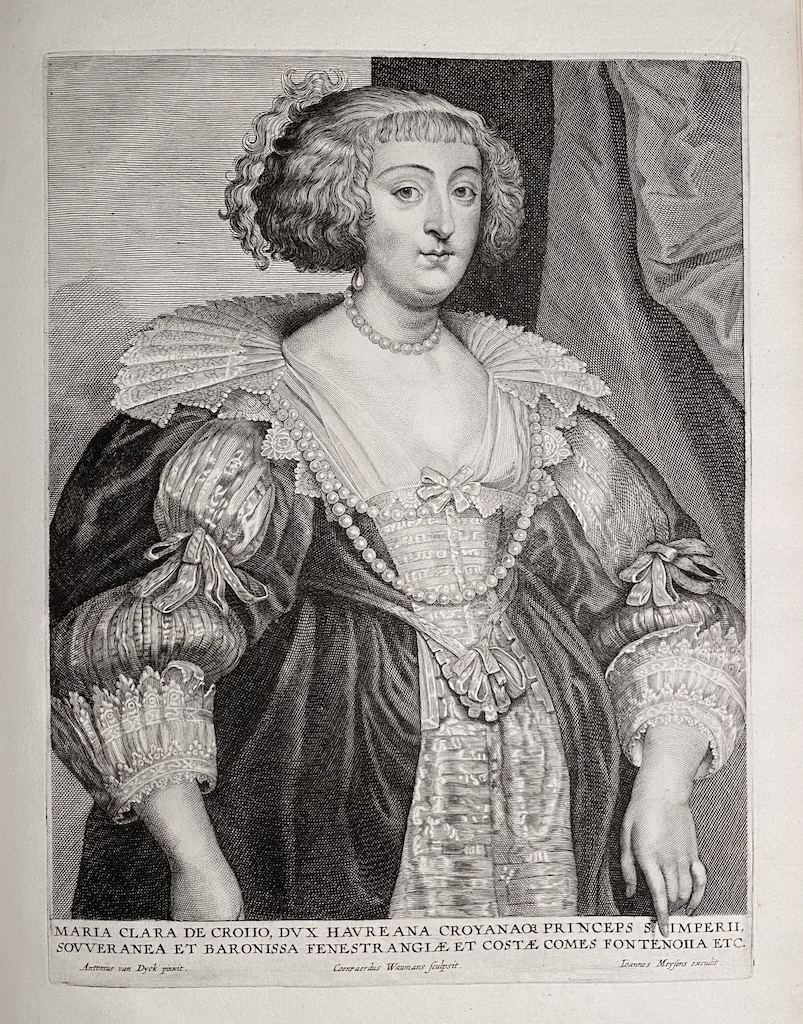
64. Marie-Claire de Croy, Duchess of Havré (Flemish, 1605 – 1664); engraved by Conraad Waumans, published by Ioannes Meyssens. Inscription: “MARIA CLARA DE CROIIO, DVX HAVREANA CROYANAQ3 PRINCEPS STE. IMPERII, | SOVVERANEA ET BARONISSA FENESTRANGIÆ ET COSTÆ COMES FONTENOIIA ETC”. In lower margin: “Antonius van Dyck pinxit.” <–> “Coenraerdus Waumans sculpsit.” <–> “Ioannes Meysens excudit.”. Second state. British Museum # R,1a.188. [Similar to №36, but this one with Ioannes Meysens name present]. 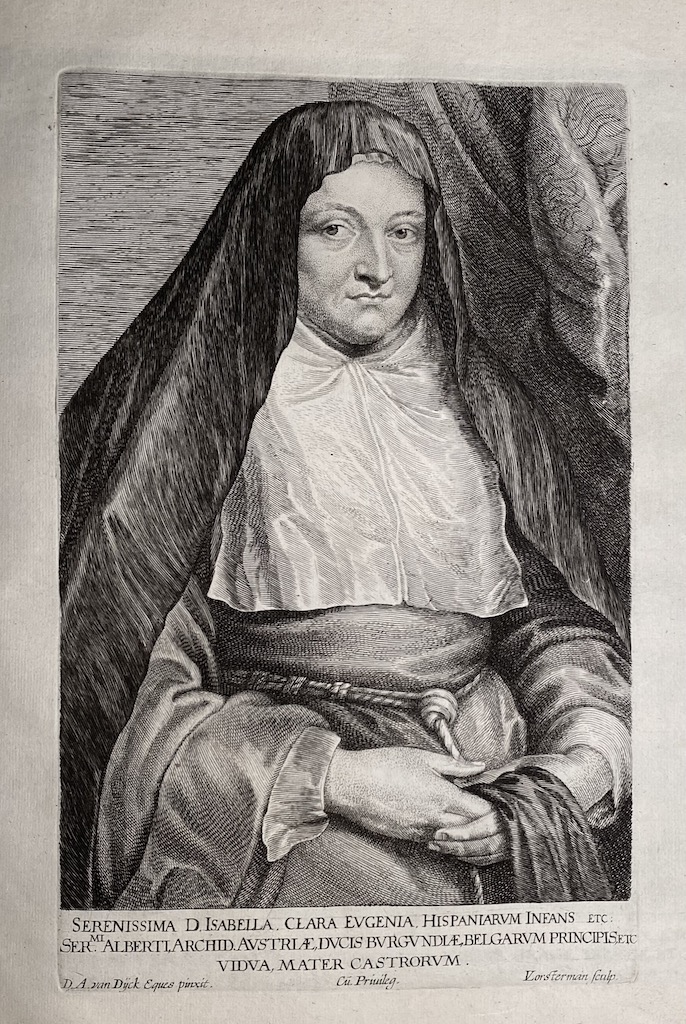
65. Isabel Clara Eugenia, ruler of the Spanish Netherlands (Spanish, 1566 – 1633); engraved by Lucas Vorsterman I. “SERENISSIMA D. ISABELLA. CLARA. EVGENIA. HISPANIARVM INFANS ETC. | SER.MI ALBERTI. ARCHID. AVSTRIÆ, DVCIS BVRGVNDIÆ, BELGARVM PRINCIPIS, ETC. | VIDVA, MATER CASTRORVM.” In lower margin: “D. A.van Dÿck Eques pinxit.” <–> “Cū Priuileg.” <–> “LVorsterman sculp.”. Fourth state with initials of Gillis Hendricx burnished. British Museum # 1863,0509.820. 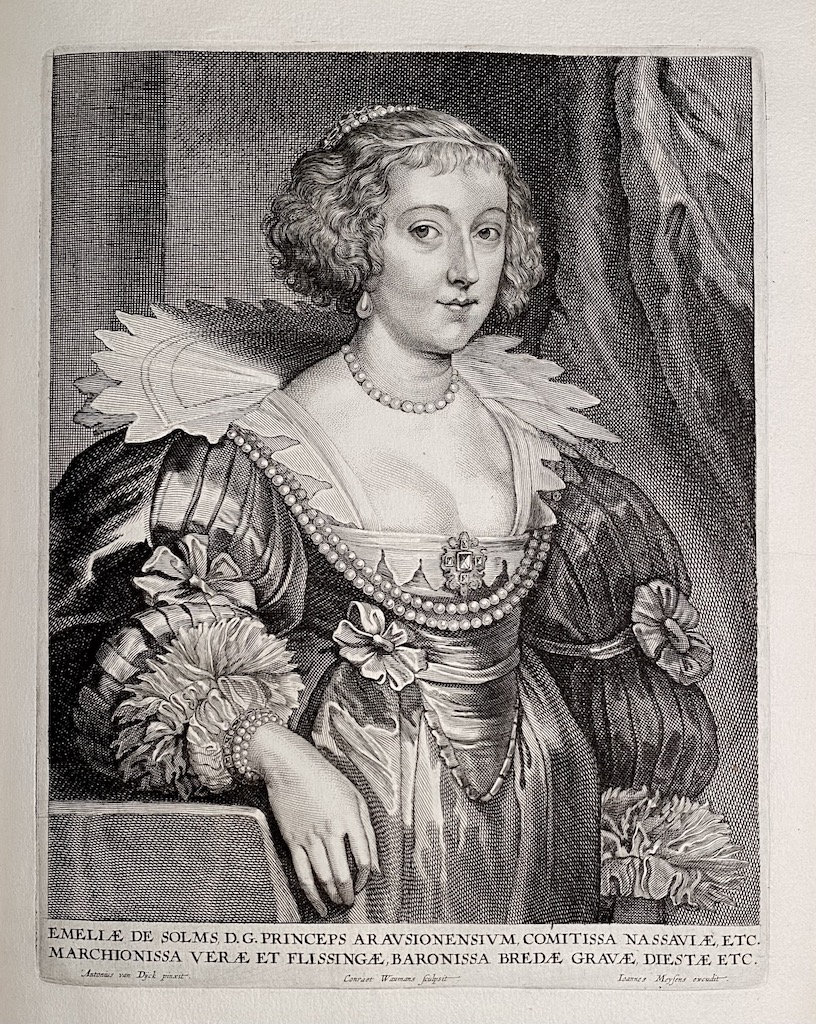
66. Amalia van Solms, Princess of Orange (German, 1602 – 1675), engraved by Conraad Waumans and published by Johannes Meyssens. Inscription: “EMELIÆ DE SOLMS, D. G. PRINCPES ARAVSIONENSIVM, COMITISSA NASSAUVIÆ, ETC. | MARCHIONISSA VERÆ ET FLISSINGÆ, BARONISSA BREDÆ, GRAVÆ, DIESTÆ ETC.” In lower margin: “Antonius van Dijck pinxit.”, “Conraet Waumans sculpsit.” and “Ioannes Meysens excudit.”. First, lettered state with the title and production details lettered. [Similar to №32, but this one with Ioannes Meysens name present]. 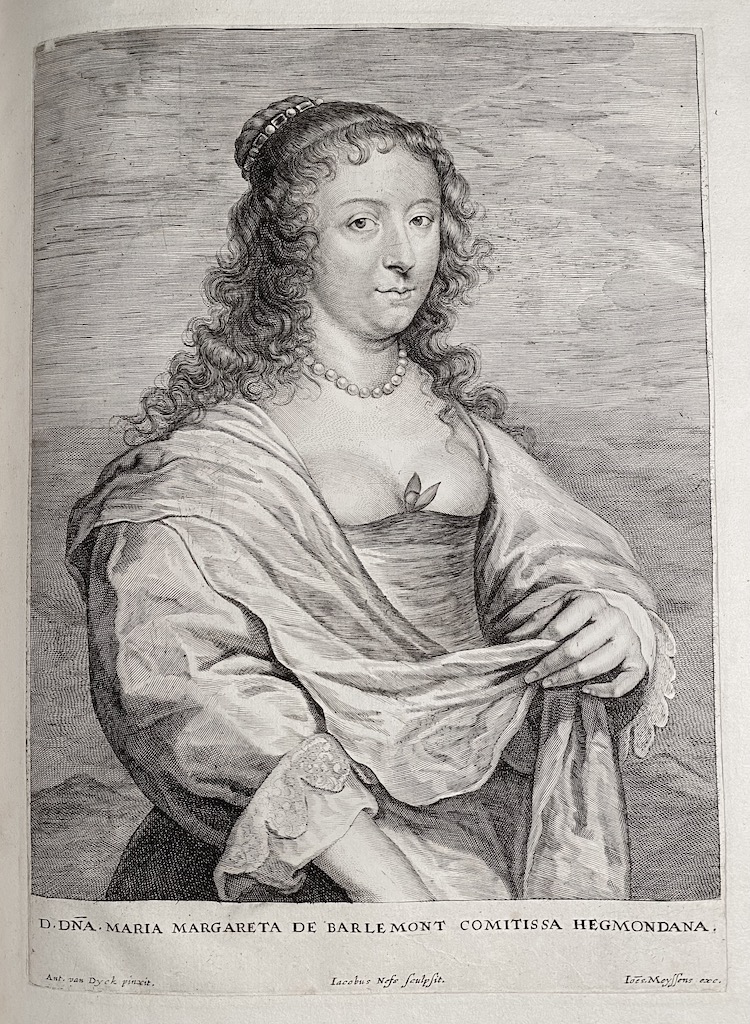
67. Marie-Marguerite de Berlaymont ( ? – 1654); engraved by Jacobus Neeffs, published by Ioannes Meyssens. Inscription: “D.DNA. MARIA MARGARETA DE BARLEMONT COMITISSA HEGMONDANA.” In lower margin: “Ant. van Dyck pinxit.” <–> “Iacobus Nefs sculpsit.” <–> “Ioes Meyssens exc.”. Fourth state. [Similar to №45, but this one with Ioannes Meysens name present]. 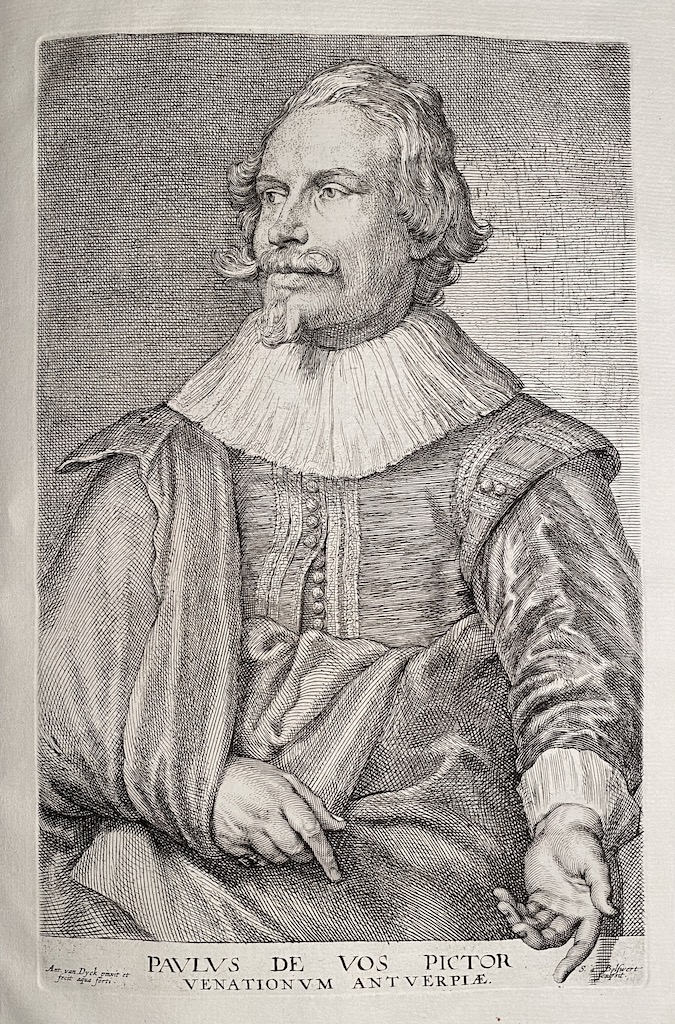
68. Paul de Vos (Flemich, 1596-1678); engraved and etched by Anthony van Dyck and by Schelte Adamsz. Bolswert, published by Gillis Hendricx. Eighth state with the initials of Gillis Hendricx burnished. Inscription: PAVLVS DE VOS PICTOR | VENATIONVM ANTVERPIÆ.”. “Ant. van Dyck pinxit et | fecit aqua forti.” <–> “S. à Bol∫wert | sculpsit. ”. [Look s very much alike №53, but with a two-line inscription and engraved by Bolswert instead of Meyssens, etc.]. 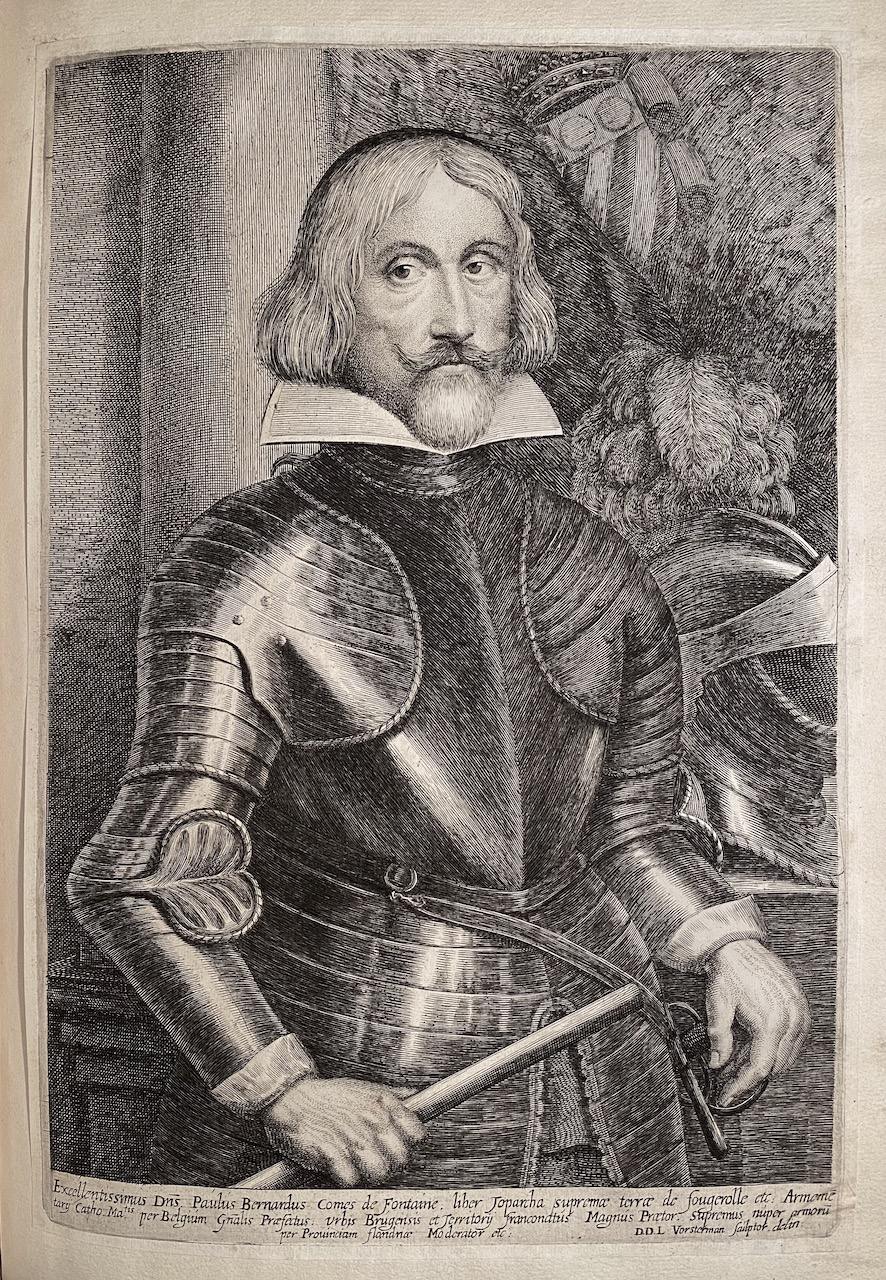
69. Paul-Bernard de Fontaines (French, 1566 – 1643) delineated and engraved by Lucas Vorsterman I (Flemish, 1595 – 1675) in 1615–75. Inscription: “Excellentissimus Dns. Paulus Bernardus Comes de Fontaine. liber Toparcha supremae terrae de fougerolle etc: Armeme tarij Catho. Matis. per Belgium Gnalis Praefectus: Vrbis Brugensis et Territorij fraconatus Magnus Praetor. Supremus nuper armpru Prouinciam flandriae Moderator etc: D.D.L Vorsterman sculptor. delin”. Cut without margins and pasted to inbound leaf. See: MET: Accession Number: 51.501.1332 -
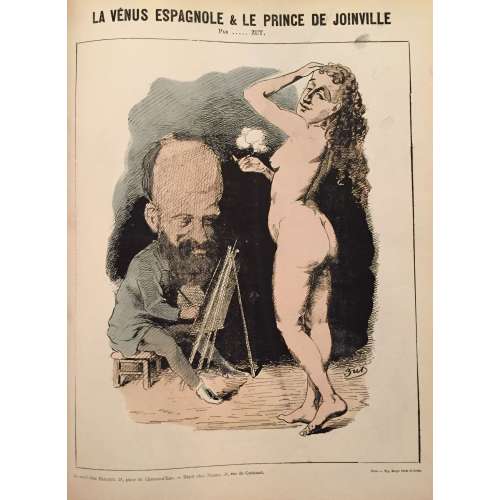 La vénus espagnole et le prince de Joinville par Zut [The Spanish Venus and the Prince of Joinville, by Zut]. Empress Eugénie poses naked for the Prince de Joinville holding a cigarette in her hand. He stares at her intently from his easel.
La vénus espagnole et le prince de Joinville par Zut [The Spanish Venus and the Prince of Joinville, by Zut]. Empress Eugénie poses naked for the Prince de Joinville holding a cigarette in her hand. He stares at her intently from his easel. -
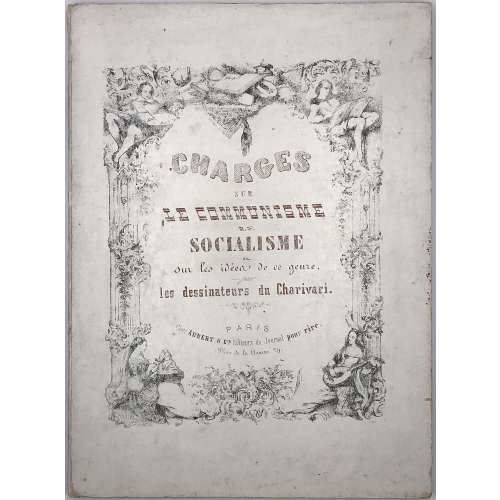 Charges sur le Communisme, le socialisme et sur les idées de ce genre par les dessinateurs du Charivari. Binding: original cardboard. Catalogue raisonée: Hazard & Delteil 1904 / Catalogue raisonné de l'oeuvre lithographié de Honoré Daumier [LIB-2176.2019 in this collection], p. 267: 20 illustrations by Daumier, Cham, Vernier, Ed. de Beaumont. Sticker: Vendu par Francois, Grande-Rue №33, à Rouen. Bought in Paris, seller claimed 1848, first edition. Similar title here : #31. Charges sur le communisme Le socialisme et sur les idées de ce genre par les dessinateurs. Paris, Chez Aubert & Cie., Éditeurs du Journal pour rire, sans date (vers 1865). Relié, plein cartonnage vert décoré et illustré de l'éditeur, in-folio (34,5 x 26 cm) de 20 planches lithographiées. 250 €. Caricatures par Cham (11), Gustave Janet (1), ADC (1), sans nom (3), Daumier (1), Lorentz-Jean-Paul Laurens (3). Nous trouvons pour ce même cartonnage des recueils différents à diverses périodes ; le nôtre doit dater des années 1865-67, moment où Jean-Pierre Laurens fut condamné par la justice du Second Empire pour son anticléricalisme.
Charges sur le Communisme, le socialisme et sur les idées de ce genre par les dessinateurs du Charivari. Binding: original cardboard. Catalogue raisonée: Hazard & Delteil 1904 / Catalogue raisonné de l'oeuvre lithographié de Honoré Daumier [LIB-2176.2019 in this collection], p. 267: 20 illustrations by Daumier, Cham, Vernier, Ed. de Beaumont. Sticker: Vendu par Francois, Grande-Rue №33, à Rouen. Bought in Paris, seller claimed 1848, first edition. Similar title here : #31. Charges sur le communisme Le socialisme et sur les idées de ce genre par les dessinateurs. Paris, Chez Aubert & Cie., Éditeurs du Journal pour rire, sans date (vers 1865). Relié, plein cartonnage vert décoré et illustré de l'éditeur, in-folio (34,5 x 26 cm) de 20 planches lithographiées. 250 €. Caricatures par Cham (11), Gustave Janet (1), ADC (1), sans nom (3), Daumier (1), Lorentz-Jean-Paul Laurens (3). Nous trouvons pour ce même cartonnage des recueils différents à diverses périodes ; le nôtre doit dater des années 1865-67, moment où Jean-Pierre Laurens fut condamné par la justice du Second Empire pour son anticléricalisme. -
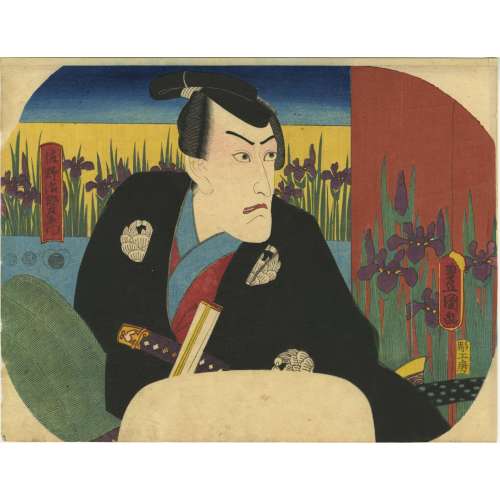 Artist: Utagawa Kunisada [歌川 国貞]; a.k.a. Utagawa Toyokuni III [三代歌川豊国] (Japanese, 1786 – 1865). Signed: Toyokuni ga [豊国 画] in a red toshidama cartouche. Publisher: Ibaya Senzaburō [伊場屋仙三郎] (Japanese, fl. C. 1845 – 1847), seal: San [三] (Marks 11-001 | 127c). Block carver: Matsushima Fusajirō [松嶋房次郎] (Japanese, fl. 1843 – 1850); seal [彫工房] – Hori kō Fusa. Double nanushi censor seal: Kunigasa & Watanabe (1849-50). Actor: Ichikawa Danjūrō VII [市川団十郎] (Japanese, 1791 – 1859); other names: Ichikawa Ebizō V [市川海老蔵], Ichikawa Hakuen II, Ichikawa Shinnosuke I. Play: Yukari no Hana Iro mo Yoshiwara [紫花色吉原], performed at the Kawarazaki Theater (Edo) from the 5th day of the 5th lunar month of Kaei 3 (1850) (see Kabuki Playbill at MFA (Boston) № 11.27996).
Artist: Utagawa Kunisada [歌川 国貞]; a.k.a. Utagawa Toyokuni III [三代歌川豊国] (Japanese, 1786 – 1865). Signed: Toyokuni ga [豊国 画] in a red toshidama cartouche. Publisher: Ibaya Senzaburō [伊場屋仙三郎] (Japanese, fl. C. 1845 – 1847), seal: San [三] (Marks 11-001 | 127c). Block carver: Matsushima Fusajirō [松嶋房次郎] (Japanese, fl. 1843 – 1850); seal [彫工房] – Hori kō Fusa. Double nanushi censor seal: Kunigasa & Watanabe (1849-50). Actor: Ichikawa Danjūrō VII [市川団十郎] (Japanese, 1791 – 1859); other names: Ichikawa Ebizō V [市川海老蔵], Ichikawa Hakuen II, Ichikawa Shinnosuke I. Play: Yukari no Hana Iro mo Yoshiwara [紫花色吉原], performed at the Kawarazaki Theater (Edo) from the 5th day of the 5th lunar month of Kaei 3 (1850) (see Kabuki Playbill at MFA (Boston) № 11.27996). Sano Jirōzaemon [佐野次郎左衛門] – provincial commoner who killed a famous Yoshiwara courtesan named ManjiyaYatsuhashi [万字屋 八ツ橋] (on the second sheet of the pair):
Sano Jirōzaemon [佐野次郎左衛門] – provincial commoner who killed a famous Yoshiwara courtesan named ManjiyaYatsuhashi [万字屋 八ツ橋] (on the second sheet of the pair):
Another Kunisada's print with the same characters in the same play and same performance can be seen at MFA (Boston) № 11.40190.
SVJP-0298.2019: Ichikawa Ebizō V as Sano Jirōzaemon.

SVJP-0297.2019: Iwai Kumesaburō III as Manjiya Yatsuhashi
 One more example can be seen at the two upper images in Waseda University Cultural Resources Database, № 006-2707:
One more example can be seen at the two upper images in Waseda University Cultural Resources Database, № 006-2707:

-
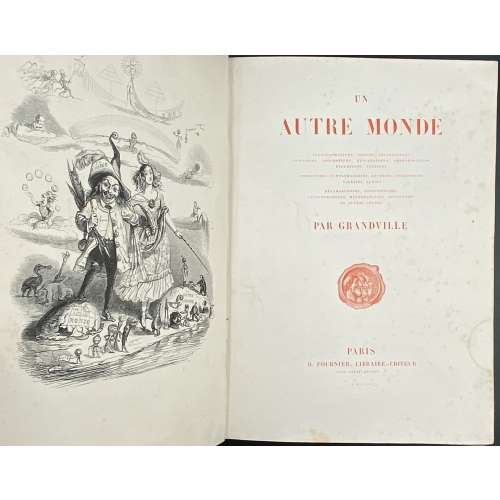 Description: One volume, collated 4t0, 27.3 x 20 cm, bound in contemporary quarter black chagrin, gilt ornaments and lettering to spine (reliure à l'époque romantique), marbled end-papers; printed on wove paper (vélin fort). Title-page (red): UN | AUTRE MONDE | TRANSFORMATIONS, VISIONS, INCARNATIONS | ASCENSIONS, LOCOMOTIONS, EXPLORATIONS, PÉRÉGRINATIONS | EXCURSIONS, STATIONS || COSMOGONIES, FANTASMAGORIES, RÈVERIES, FOLATRERIES | FACÉCIES, LUBIES || MÉTAMORPHOSES, ZOOMORPHOSES | LITHOMORPHOSES, MÉTEMPSYCHOSES, APOTHÉOSES | ET AUTRES CHOSES | PAR GRANDVILLE | [device] | PARIS | H. FOURNIER, LIBRAIRE-ÉDITEUR | RUE SAINT-BENOIT, 7 | M DCCC XLIV Pagination: ff, [2] half-title in red / imprim., [2] blank / frontis. in black, [2] title page in red / blank, [1] 2-295, [1] explication and erratum, bf, illustrations. Collation: 4to, (1)-(37)4 with frontispiece, 133 woodcut vignettes, 15 full-page black woodcuts, and 36 hand-coloured plates. Catalogue raisonné: Carteret (p. 285) describes the book as 'in-8', but the collation is actually in quarto (in-4, or 4to) with series signed in Arabic numerals. Ray (French): p. 275-7. The publication is anonymous, however, Grandville reveals the author's name (that's Taxile Delord) on the vignette on p. 292 at the bottom of the plate (under ICI).
Description: One volume, collated 4t0, 27.3 x 20 cm, bound in contemporary quarter black chagrin, gilt ornaments and lettering to spine (reliure à l'époque romantique), marbled end-papers; printed on wove paper (vélin fort). Title-page (red): UN | AUTRE MONDE | TRANSFORMATIONS, VISIONS, INCARNATIONS | ASCENSIONS, LOCOMOTIONS, EXPLORATIONS, PÉRÉGRINATIONS | EXCURSIONS, STATIONS || COSMOGONIES, FANTASMAGORIES, RÈVERIES, FOLATRERIES | FACÉCIES, LUBIES || MÉTAMORPHOSES, ZOOMORPHOSES | LITHOMORPHOSES, MÉTEMPSYCHOSES, APOTHÉOSES | ET AUTRES CHOSES | PAR GRANDVILLE | [device] | PARIS | H. FOURNIER, LIBRAIRE-ÉDITEUR | RUE SAINT-BENOIT, 7 | M DCCC XLIV Pagination: ff, [2] half-title in red / imprim., [2] blank / frontis. in black, [2] title page in red / blank, [1] 2-295, [1] explication and erratum, bf, illustrations. Collation: 4to, (1)-(37)4 with frontispiece, 133 woodcut vignettes, 15 full-page black woodcuts, and 36 hand-coloured plates. Catalogue raisonné: Carteret (p. 285) describes the book as 'in-8', but the collation is actually in quarto (in-4, or 4to) with series signed in Arabic numerals. Ray (French): p. 275-7. The publication is anonymous, however, Grandville reveals the author's name (that's Taxile Delord) on the vignette on p. 292 at the bottom of the plate (under ICI).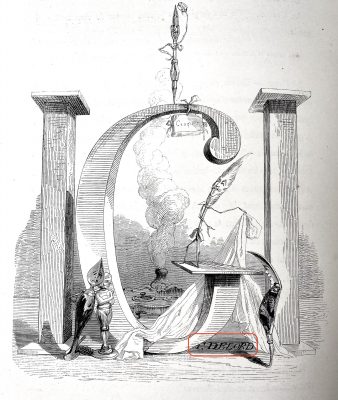
-
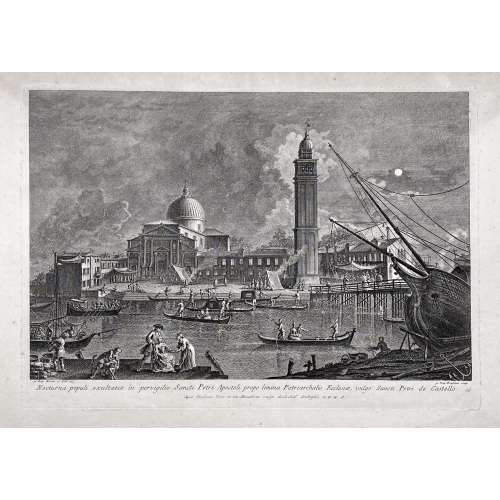
From the series of prints 'Prospectum Ædium Viarumque Insigniorum Urbis Venetiarum'. Inscribed below image left: "Jo. Bap. Moretti et Filii del. e Pinx."; right: "Jo. Baptista Brustoloni sculp."; in lower margin centre: "Nocturna populi exultatio in pervigilio Sancti Petri Apostoli prope limina Patriarchalis Ecclesiæ, vulgò Sancti Petri de Castello. / Apud Ludovicum Furlanetto supra Pontem vulgo dictum dei Baretteri C.P.E.S.". The third state, published by Teodoro Viero; the numbering on plate lower right, next to the inscription in Latin is cancelled as indicated by bibliography.
The subject is taken from a drawing by Giovanni Battista Moretti (Italian, active Venice, 1748-75) which in turn derives from a Canaletto painting. The print comes from the most important of Brustolon’s series, Prospectuum Aedium Viarumque Insignorum Urbis Venetiarum, dedicated to the Doge Marco Foscarini, from drawings by Canaletto, Moretti and sons and others, published for the first time by Ludovico Furlanetto in 1763 and later by Teodoro Viero. Giambattista Brustolon (1712–1796) was a famous Venetian engraver, a pupil of Joseph Wagner; whose talent is best displayed in his famous nocturnals: ‘riesce a dare il meglio di sé … nei famosi notturni’ (Succi).
Plate: 324 × 458 mm Sheet: 350 × 471 cm
References: The British Museum 1944,1014.209.48; The Metropolitan Museum of Art 60.611.29(4) (first state); Dario Succi, Da Carlevaris ai Tiepolo, 1983, pp.81-93, n. 55; William George Constable, J. G. Links, Canaletto: Giovanni Antonio Canal. 1697–1768. Oxford, 1989, vol. II, cat. no. 10, p. 674.
Condition: a very slight central fold, slight foxing and a very slight stain to the top, four small pinholes in corners, not affecting the engraving; else a well-margined copy in good condition.
-
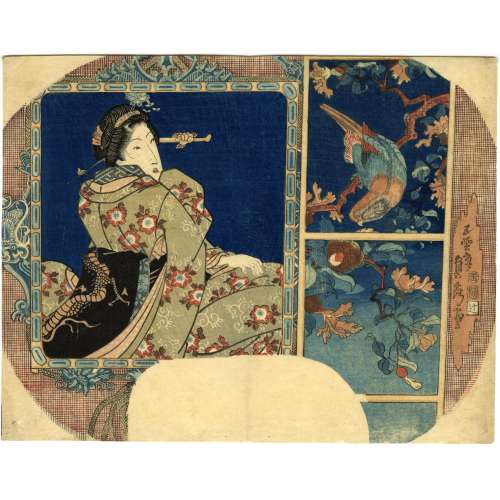 Artist: Utagawa Sadahide [歌川 貞秀], a.k.a. Gountei Sadahide [五雲亭 貞秀] (1807 – c. 1878/9). Publisher: Iseya Ichiemon [伊勢屋市右衛門] (Japanese, fl. c 1823 – 1864), seal name Kaku-Tsuji [角辻]. Signed: Gountei Sadahide ga [五雲亭貞秀画] Censor's seal: kiwame, date seal: Tenpō 3 (1832). Size: Uncut fan print (uchiwa-e); 218 x 282 mm. Portrait of a young woman dressed in a green kimono decorated with arabesque (karakusa) and flowers, her black obi adorned with a dragon, in a western-style frame, on a blue background; and a painting of a parrot on a pomegranate tree. A similar design was used by Sadahide in 1860, described in detail by Sebastian Izzard in his Japanese Prints of the Mid-Nineteenth Century: 1830–1865, September 20–October 24, 2006 exhibition: Picture of a Curio Shop in Yokohama: reverse painting on glass of a crimson parrot, coloured copperplate engraving of a mother and child (Yokohama urimono mise no zu: gyokuban abura-e, doban-e saishiki). Colour woodblock print: oban tate-e, 143/8 x 93/4 in. (36.5 x 24.8 cm.); Man-en I/3 (3/1860) Series: Picture of Goods for Sale in Yokohama (Yokohama urimono zue no uchi) Signature: Gountei Sadahide ga, double toshidama seal Publisher: Daikokuya Kinnosuke.
Artist: Utagawa Sadahide [歌川 貞秀], a.k.a. Gountei Sadahide [五雲亭 貞秀] (1807 – c. 1878/9). Publisher: Iseya Ichiemon [伊勢屋市右衛門] (Japanese, fl. c 1823 – 1864), seal name Kaku-Tsuji [角辻]. Signed: Gountei Sadahide ga [五雲亭貞秀画] Censor's seal: kiwame, date seal: Tenpō 3 (1832). Size: Uncut fan print (uchiwa-e); 218 x 282 mm. Portrait of a young woman dressed in a green kimono decorated with arabesque (karakusa) and flowers, her black obi adorned with a dragon, in a western-style frame, on a blue background; and a painting of a parrot on a pomegranate tree. A similar design was used by Sadahide in 1860, described in detail by Sebastian Izzard in his Japanese Prints of the Mid-Nineteenth Century: 1830–1865, September 20–October 24, 2006 exhibition: Picture of a Curio Shop in Yokohama: reverse painting on glass of a crimson parrot, coloured copperplate engraving of a mother and child (Yokohama urimono mise no zu: gyokuban abura-e, doban-e saishiki). Colour woodblock print: oban tate-e, 143/8 x 93/4 in. (36.5 x 24.8 cm.); Man-en I/3 (3/1860) Series: Picture of Goods for Sale in Yokohama (Yokohama urimono zue no uchi) Signature: Gountei Sadahide ga, double toshidama seal Publisher: Daikokuya Kinnosuke.
-
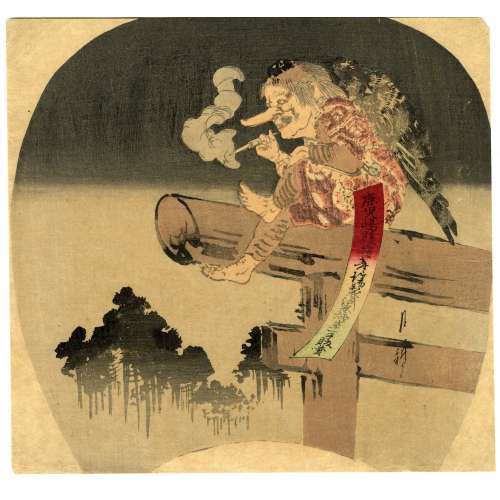 Ogata Gekkō [尾形月耕] (Japanese, 1859 – 1920). An uchiwa-e (fan-print) of advertisement of tobacco of Kagoshima Prefecture, c. 1890 (Meiji Period). Barefoot Tengu* is sitting on a torii (entrance to a Shinto shrine), smoking a cigarette through a mouthpiece. _______ * Tengu [天狗] (heavenly dog) is a type of legendary creature found in Japanese folk religion and are also considered a type of Shinto god (kami) or yōkai (supernatural beings).
Ogata Gekkō [尾形月耕] (Japanese, 1859 – 1920). An uchiwa-e (fan-print) of advertisement of tobacco of Kagoshima Prefecture, c. 1890 (Meiji Period). Barefoot Tengu* is sitting on a torii (entrance to a Shinto shrine), smoking a cigarette through a mouthpiece. _______ * Tengu [天狗] (heavenly dog) is a type of legendary creature found in Japanese folk religion and are also considered a type of Shinto god (kami) or yōkai (supernatural beings). -
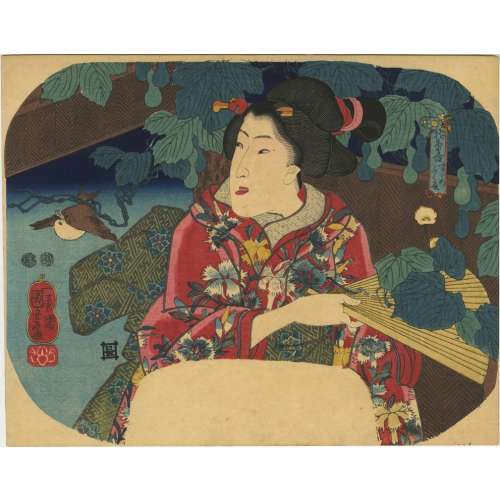 Artist: Utagawa Kuniyoshi [歌川 國芳] (Japanese, 1798 – 1861).
Artist: Utagawa Kuniyoshi [歌川 國芳] (Japanese, 1798 – 1861).Title: Suzume fukube [美人団扇絵] (Sparrow and gourds).
Series: Kacho awase [花鳥合] (Collection of flowers and birds).
Publisher: Aritaya Seiemon [有田屋 清右衛門] (Japanese, fl. c. 1830 – 1862); Seal: Marks 17-011 | 014d.Signed: Ichiyosai Kuniyoshi ga in a red cartouche and sealed with paulownia crest (kiri mon).
Size: Uchiwa-e (untrimmed fan print) 296 x 230 mm.
Double nanushi censor seals: Kinugasa & Watanabe, Kaei 2-3 (1849–50).
Ref.: Kuniyoshi Project. -
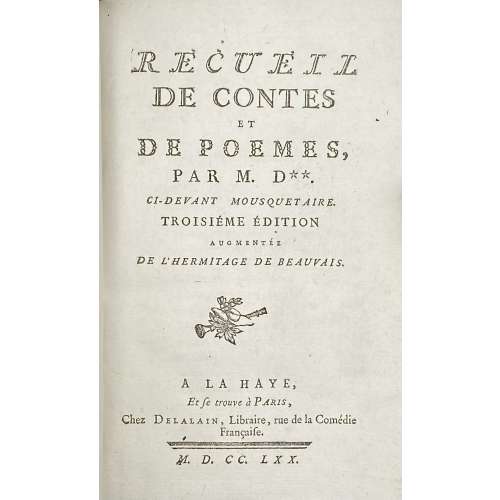 Title page: RECUEIL | DE CONTES | ET | DE POEMES, | PAR M. D**. | CI-DEVANT MOUSQUETAIRE. | TROSIÉME ÉDITION | AUGUMENTÉE | DE L'HERMITAGE DE BEAUVAIS. | [device] | A LA HAYE, | Et se trouve à Paris, | Chez Delalain, Libraire, rue de la Comédie | Française. | — | M. D. CC. LXX. IRZA | ET MARSIS , | POËME, includes: L'isle merveilleuse, Poëme, Chant 1re et Chant 2nd, Invocation a La Fontaine, and Alphonse, Conte – Cohen and De Ricci (#317) describe 2nd edition by the same publisher, 1769, 77 p., with similar illustrations after Charles Eisen: (1) engraved title by Louis Claude Legrand (2) L’Isle 1er: Frontispiece by Joseph de Longueil, (3) headpiece and (4) tailpiece by Emmanuel de Ghendt, and (5) L’Isle 2nd: Frontispiece by Jean Massard, (6) headpiece by Emmanuel de Ghendt + (7) tailpiece unsigned. Les Cerises et la Méprise, Contes en vers – Cohen and De Ricci (#311) also describe the 2nd edition of 1769, with the same (8) frontispiece by De Longueil after Eisen. Sélim et Sélima, Poeme imité de l'allemand; L'hermitage de beauvais, Conte –Cohen and De Ricci (#322) describe edition of 1769 by Sébastien Jorry, with the same (9) frontispiece by Emmanuel de Ghendt after Eisen. Size: 18.6 x 12.3 cm, small 8vo. Binding: polished, multi-coloured stained calf with gilt triple fillet border to boards; gilt floral arabesque and gilt lettering to flat spine: "Oeuvres de Dorat | Contes"; all edges gilt; blue-and-white marbled endpapers. Pagination: ffl, [2] IRZA ET MARSIS engraved half-title / blank, [1-2] - RECUEIL title page / blank, 3-8 (avis sur cette édition); [1 - L'Isle...] 2-184, bfl; Illustrations (copperplate engravings): 5 plates, 2 headpieces and 2 tailpieces. Collation: Octavo; a8 (title and avis sur cette édition); A-L8, M4. Author of the text: Claude Joseph Dorat, (French, 1734 – 1780) Artist: Charles-Dominique-JosephEisen (French, 1720 – 1778) Engravers: Emmanuel Jean Nepomucène de Ghendt (French, 1738 – 1815) Louis Claude Legrand (French, 1723 – 1807) Joseph de Longueil (French, 1730 – 1792) Jean Massard (French, 1740 – 1822)
Title page: RECUEIL | DE CONTES | ET | DE POEMES, | PAR M. D**. | CI-DEVANT MOUSQUETAIRE. | TROSIÉME ÉDITION | AUGUMENTÉE | DE L'HERMITAGE DE BEAUVAIS. | [device] | A LA HAYE, | Et se trouve à Paris, | Chez Delalain, Libraire, rue de la Comédie | Française. | — | M. D. CC. LXX. IRZA | ET MARSIS , | POËME, includes: L'isle merveilleuse, Poëme, Chant 1re et Chant 2nd, Invocation a La Fontaine, and Alphonse, Conte – Cohen and De Ricci (#317) describe 2nd edition by the same publisher, 1769, 77 p., with similar illustrations after Charles Eisen: (1) engraved title by Louis Claude Legrand (2) L’Isle 1er: Frontispiece by Joseph de Longueil, (3) headpiece and (4) tailpiece by Emmanuel de Ghendt, and (5) L’Isle 2nd: Frontispiece by Jean Massard, (6) headpiece by Emmanuel de Ghendt + (7) tailpiece unsigned. Les Cerises et la Méprise, Contes en vers – Cohen and De Ricci (#311) also describe the 2nd edition of 1769, with the same (8) frontispiece by De Longueil after Eisen. Sélim et Sélima, Poeme imité de l'allemand; L'hermitage de beauvais, Conte –Cohen and De Ricci (#322) describe edition of 1769 by Sébastien Jorry, with the same (9) frontispiece by Emmanuel de Ghendt after Eisen. Size: 18.6 x 12.3 cm, small 8vo. Binding: polished, multi-coloured stained calf with gilt triple fillet border to boards; gilt floral arabesque and gilt lettering to flat spine: "Oeuvres de Dorat | Contes"; all edges gilt; blue-and-white marbled endpapers. Pagination: ffl, [2] IRZA ET MARSIS engraved half-title / blank, [1-2] - RECUEIL title page / blank, 3-8 (avis sur cette édition); [1 - L'Isle...] 2-184, bfl; Illustrations (copperplate engravings): 5 plates, 2 headpieces and 2 tailpieces. Collation: Octavo; a8 (title and avis sur cette édition); A-L8, M4. Author of the text: Claude Joseph Dorat, (French, 1734 – 1780) Artist: Charles-Dominique-JosephEisen (French, 1720 – 1778) Engravers: Emmanuel Jean Nepomucène de Ghendt (French, 1738 – 1815) Louis Claude Legrand (French, 1723 – 1807) Joseph de Longueil (French, 1730 – 1792) Jean Massard (French, 1740 – 1822) -
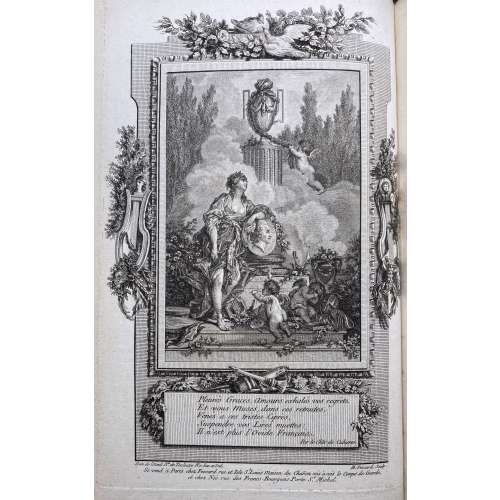 Title page: LES | BAISERS , | PRÉCÉDES | DU MOIS DE MAI, | POËME. | [vignette] | A LA HAYE , | Et se trouve à Paris | Chez Lambert , Imprimeur, rue de la Harpe. | Et Delalain , rue de la Comédie Françoise. | M. DCC. LXX Size: 8vo; 24.5 x 15.5 cm; Binding by Hippolyte Duru – stamp at the back of the front end paper DURU, 1855; full red calf, boards decorated in gilt, raised bands and gilt decorations in compartments, gilt lettering, AEG, peacock marbled end papers, text and illustrations printed on Holland paper. Collation: 2 ffls, engraved half-title by N. Ponce after Ch. Eisen, frontispiece by Etienne Fessard after Claude-Jean-Baptiste Hoin (French, 1750 – 1817) w/guard tissue, t.p. by J. Aliamet after Ch. Eisen, Réflexions préliminaires: A8, B4; 'Le Mois de Mai' half-title, imprim. note on verso, frontispice by De Longueil after Ch. Eisen w/guard tissue, A4 C-F(8) H4; 2bfls. Frontispiece by Etienne Fessard is unique in this edition. Pagination: [2] 3-24, [27]/28, 5/6, 31/32 31/34 11/12 37-119 [120], 22 head-pieces after Ch. Eisen and 22 end-pieces after Marillier, engraved by Baquoy, Binet, Delaunay, Lingée, De Longueil, Masquelier, Massard, and Née. Mistakes in pagination likely confirms first printing first edition. Catalogue raisonné: Cohen, De Ricci (1912): 308-311). Artists: Charles Eisen (French, 1720–1778); Clément Pierre Marillier (French, 1740–1808), and Claude-Jean-Baptiste Hoin (French, 1750–1817). Engravers: Jacques Aliamet (French, 1726–1788); Jean Charles Baquoy (French, 1721–1777); Louis Binet (French, 1744–about 1800); Nicolas Delaunay (French, 1739–1792); Etienne Fessard (French, 1714–1777); Charles Louis Lingée (French, 1748–1819); Joseph de Longueil (French, 1730–1792); Louis Joseph Masquelier (French, 1741–1811); Jean Massard (1740–1822); François Denis Née (French, 1735–1818); Nicholas Ponce (French, 1746–1831).
Title page: LES | BAISERS , | PRÉCÉDES | DU MOIS DE MAI, | POËME. | [vignette] | A LA HAYE , | Et se trouve à Paris | Chez Lambert , Imprimeur, rue de la Harpe. | Et Delalain , rue de la Comédie Françoise. | M. DCC. LXX Size: 8vo; 24.5 x 15.5 cm; Binding by Hippolyte Duru – stamp at the back of the front end paper DURU, 1855; full red calf, boards decorated in gilt, raised bands and gilt decorations in compartments, gilt lettering, AEG, peacock marbled end papers, text and illustrations printed on Holland paper. Collation: 2 ffls, engraved half-title by N. Ponce after Ch. Eisen, frontispiece by Etienne Fessard after Claude-Jean-Baptiste Hoin (French, 1750 – 1817) w/guard tissue, t.p. by J. Aliamet after Ch. Eisen, Réflexions préliminaires: A8, B4; 'Le Mois de Mai' half-title, imprim. note on verso, frontispice by De Longueil after Ch. Eisen w/guard tissue, A4 C-F(8) H4; 2bfls. Frontispiece by Etienne Fessard is unique in this edition. Pagination: [2] 3-24, [27]/28, 5/6, 31/32 31/34 11/12 37-119 [120], 22 head-pieces after Ch. Eisen and 22 end-pieces after Marillier, engraved by Baquoy, Binet, Delaunay, Lingée, De Longueil, Masquelier, Massard, and Née. Mistakes in pagination likely confirms first printing first edition. Catalogue raisonné: Cohen, De Ricci (1912): 308-311). Artists: Charles Eisen (French, 1720–1778); Clément Pierre Marillier (French, 1740–1808), and Claude-Jean-Baptiste Hoin (French, 1750–1817). Engravers: Jacques Aliamet (French, 1726–1788); Jean Charles Baquoy (French, 1721–1777); Louis Binet (French, 1744–about 1800); Nicolas Delaunay (French, 1739–1792); Etienne Fessard (French, 1714–1777); Charles Louis Lingée (French, 1748–1819); Joseph de Longueil (French, 1730–1792); Louis Joseph Masquelier (French, 1741–1811); Jean Massard (1740–1822); François Denis Née (French, 1735–1818); Nicholas Ponce (French, 1746–1831).


